
SECTION 7: SCIENCE AND TECHNOLOGY
Autonomous Aerial Cargo/Utility System (AACUS)
Autonomous Swarmboats
Discovery and Invention (D&I) Research
Electromagnetic Maneuver Warfare Command & Control (EMC2)
Electromagnetic Railgun (EMRG)
Energy System Technology Evaluation Program (ESTEP)
Forward-Deployed Energy and Communications Outpost (FDECO)
Future Naval Capabilities (FNC)
Lightweight and Modern Metals Manufacturing Innovation (LM3I) Institute / Lightweight Innovations for Tomorrow (LIFT)
Medium Displacement Unmanned Surface Vehicle "Sea Hunter"
Naval Research Laboratory (NRL)
Navy Manufacturing Technology Program (ManTech)
Netted Emulation of Multi-Element Signature against Integrated Sensors (NEMESIS)
ONR Global
Resilient Hull, Infrastructure, Mechanical, and Electrical Security (RHIMES)
Science, Technology, Engineering and Mathematics (STEM)
Solid State Laser
SwampWorks
TechSolutions
Total Platform Cyber Protection (TPCP)
* * * * * * * * * * * *
Naval Aviation forces are the Nation's maritime "mailed fist" of credible combat power across the spectrum of crisis and conflict in the 21st-Century. From cyberspace to the ocean floor, from unmanned systems through the most complex crewed aircraft and aircraft carriers, Naval Aviation platforms, systems and, most importantly, Sailors provide the Navy and the Nation with an unmatched capability to fight and win—providing persistent forward presence and deterring adversaries wherever and whenever America's citizens, interests, and allies and partners might be at risk. In that regard we continue to field nuclear-powered aircraft carriers—including the next-generation Gerald Ford (CVN 78) class—with their multi-mission air wings, introduce the F-35C Lightning II Joint Strike Fighter, improve our land-based aviation capabilities with P-8A Poseidon Multi-mission Maritime Aircraft and Triton unmanned aircraft system, and delivering improvements in weapons and sensors across the board.

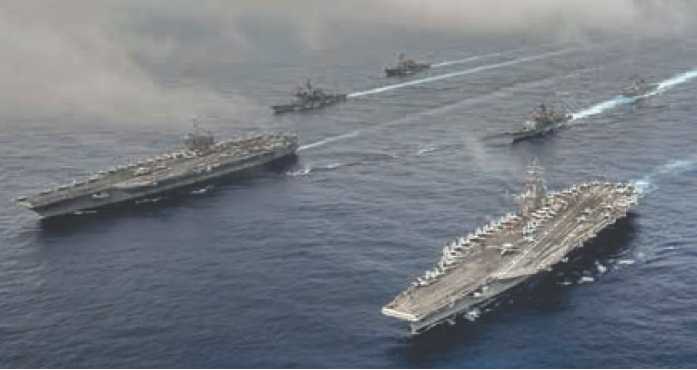
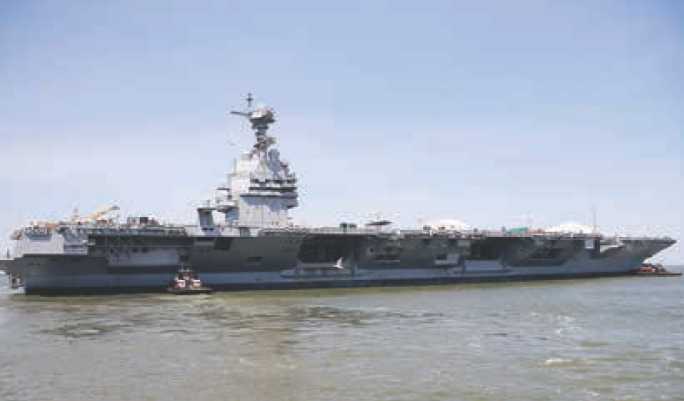
AIRCRAFT CARRIERS
CVN 68 Nimitz-Class and CVN 78 Ford-Class Aircraft Carrier Programs
Description
The U.S. Navy's nuclear-powered aircraft carriers (CVNs), in combination with their embarked air wings and strike group warships, provide the proper balance between forward presence and surge capability to conduct warfighting and peacetime operations around the globe in support of national priorities. Sailing the world's oceans, each carrier strike group is a versatile, lethal, and independent striking force capable of engaging targets at sea or hundreds of miles inland. The unique mobility and independence of aircraft carriers provide unmatched global access that requires no host-nation support. America's CVNs can remain on-station for months at a time, replenishing ordnance, spare parts, food, consumables, and aircraft fuel while simultaneously conducting air strikes and other critical missions. This capability demonstrates the carrier's remarkable operational flexibility and self-reliance so vital to conducting time-critical strike operations.
Aircraft carriers and their strike groups are always ready upon arrival and are either on-station ready to deliver or just a few days away from where they will be needed. To meet the demands of 21st-century warfare, U.S. aircraft carriers will deploy with air wings comprising the newest and most-capable aviation platforms, including the FA-18E/F Super Hornet, EA-18G Growler, F-35C Lightning II, E-2D Advanced Hawkeye, and, in the not-too-distant future, the MQ-25A Stingray. Joint concepts of operation, centered on the aircraft carrier, will additionally leverage the military strengths of all the services, bringing cooperative muscle to the fight and a potent synergy across the warfare continuum. Following the inactivation of the USS Enterprise (CVN 65) in December 2012, after more than 51 years of service, the Navy has been fulfilling its mission with a reduced force structure of ten aircraft carriers, as authorized by the National Defense Authorization Act for FY 2010. The force will increase to the statutory requirement of 11 aircraft carriers when Gerald R. Ford (CVN 78) is delivered to the Navy.
The lead ship of the first new class of aircraft carriers, CVN 78 has been under construction since 2008. The Ford-class is designed for increased efficiency throughout the ship—aimed at reducing the total operating cost by approximately $4 billion dollars per hull when compared to the Nimitz (CVN 68)-class carriers—while enhancing warfighting capabilities. In converting all auxiliary systems outside the main propulsion plant from steam to electric power, the requirement for costly steam, hydraulic, and pneumatic piping, as well as the maintenance and repair of those distributed systems, will be significantly reduced. The advanced and more efficient reactor plant provides an electrical generating capacity nearly three times that of a Nimitz-class carrier, enabling such new technologies such as the Electromagnetic Aircraft Launch System and advanced command-and-control systems. The new ship design, which is based on the Nimitz hull, also includes the Advanced Arresting Gear system and Dual-Band Radar. The redesigned flight deck, which incorporates a smaller island structure located further aft on the ship, allows greater flexibility during aircraft turnaround and launch-and-recovery cycles, leading to at least a 33 percent increase in daily sortie generation-rate capability. Combined, these new technologies and more efficient systems will enable the Ford-class ships to operate with about 900 fewer Sailors than the Nimitz class.
Status
Construction of Gerald R. Ford was 98 percent complete in August 2016 at Huntington Ingalls Industries, Newport News Shipbuilding. The keel for John F. Kennedy (CVN 79) was laid on August 22, 2015, and the ship was approximately 20 percent constructed as of August 2016.
Developers
Huntington Ingalls Industries Newport News, Virginia
* * * * * * * * * * * *
AIRCRAFT
AH-1Z and UH-1Y Helicopter Upgrades
Description
The H-1 Upgrade Program upgrades legacy Huey/Venom UH-1N and Super Cobra AH-1W aircraft, ensuring that the Marine Air-Ground Task Forces possess credible rotary-wing attack and utility support platforms for the next 20 years. The H-1 program reduces life-cycle costs, significantly improves operational capabilities, and extends the service lives of both aircraft. There is 85 percent commonality between the two aircraft. This greatly enhances the maintainability and readiness of the systems by leveraging the ability to support and operate both aircraft within the same squadron structure.
The program includes a new, four-bladed, all-composite rotor system, coupled with a sophisticated, fully integrated glass cockpit. It also incorporates a performance-matched transmission, four-bladed tail rotor drive system, and upgraded landing gear. The integrated glass cockpit with modern avionics systems provides a more lethal platform as well as enhanced joint interoperability. Operational enhancements include a dramatic increase in range, speed, survivability, payload, and lethality of both aircraft, with a significant decrease in logistics footprint. Compared to legacy aircraft, the UH-1Y Huey/Venom helicopter operates at nearly twice the in-service range, with more than double the payload. The AH-1Z Super Cobra helicopter realizes similar performance increases, with the ability to carry twice the in-service load of precision-guided munitions.
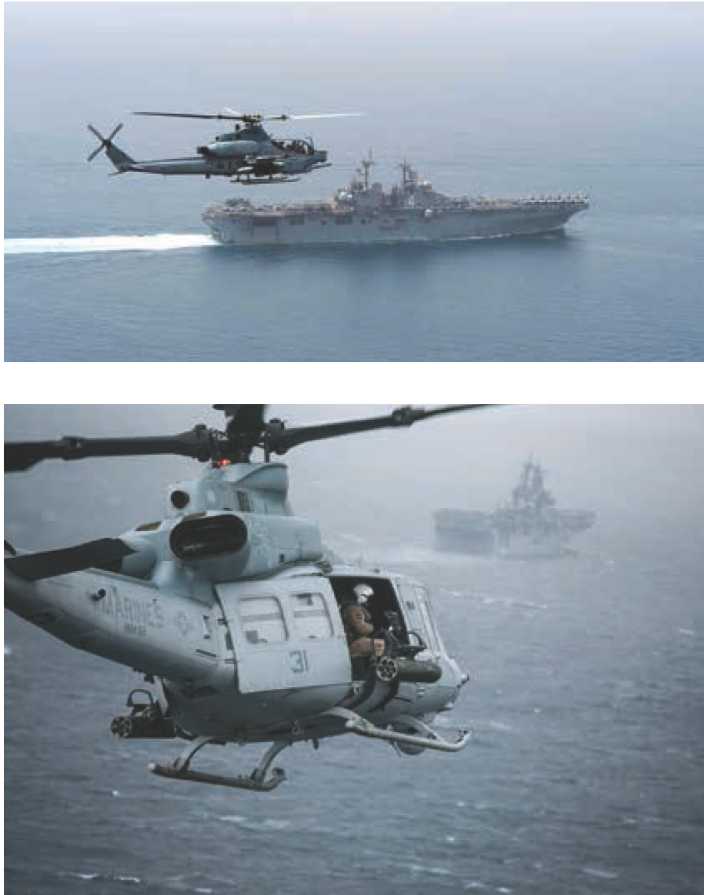
Status
The H-1 Upgrades program of record is for 160 UH-1Ys and 189 AH-1Zs. Through the end of FY 2016, 266 H-1 aircraft were on contract (160 UH-1Y, 111 AH-1Z), with 139 UH-1Ys and 57 AH-1Zs delivered as of September 2016. The FY 2017 budget requests 24 H-1 Upgrade aircraft. AH-1Z full-rate production was achieved on November 28, 2010, and at the same time the H-1 Upgrades program was designated ACAT-1C. AH-1Z initial operational capability was reached on February 24, 2011 and the first successful deployment of the new attack helicopter occurred with the 11th Marine Expeditionary Unit (MEU) from November 2011 to June 2012. This MEU detachment was another program "first," as it was the first "all Upgrades" (UH-1Y/AH-1Z) deployment. All West Coast MEU deployments (11th, 13th, and 15th) comprise only UH-1Y and AH-1Z aircraft. The UH-1Y made its initial deployment with the 13th MEU from January to June 2009, and the UH-1Y has conducted sustained combat operations in Operation Enduring Freedom since November 2009. The Marine Corps' fleet of utility aircraft includes only UH-1Ys; the last UH-1N was retired in September 2014. The UH-1Y and AH-1Z have been aggressively deployed ahead of their respective material support dates, in an effort to support our deployed troops with the most capable aircraft available.
Developers
Bell Helicopter Textron Fort Worth, Texas
Amarillo, Texas
* * * * * * * * * * * *
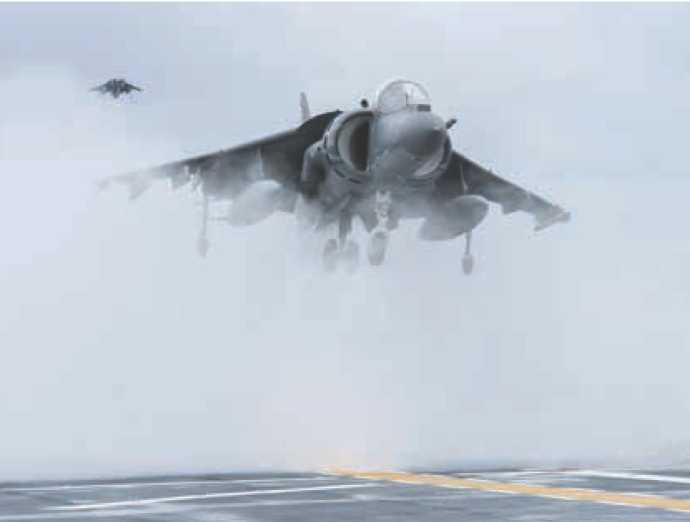
AV-8B Harrier II+ Vertical/Short Take-Off and Landing (V/STOL) Aircraft
Description
The AV-8B Harrier is a single-seat, light attack aircraft that supports the Marine Air-Ground Task Force (MAGTF) commander by engaging surface targets and escorting friendly aircraft, day or night, under all weather conditions during expeditionary, joint or combined operations. By virtue of its vertical/short takeoff and landing capability, the AV-8B can operate from a variety of amphibious ships, rapidly constructed expeditionary airfields, forward sites--e.g., roads and forward operating bases—and damaged conventional airfields. Two variants of the aircraft are in service, the AV-8B II Night-Attack Harrier and the AV-8B II+ Radar Harrier. The Night-Attack Harrier improved the original AV-8B design through incorporation of a navigation, forward-looking infrared sensor, a digital color moving map, night-vision goggle compatibility, and a higher-performance engine. The in-service Radar Harrier has all the improvements of the Night-Attack Harrier plus the APG-65 multi-mode radar. The fusion of night and radar capabilities allows the Harrier II+ to be responsive to the MAGTF's needs for expeditionary, night, and adverse-weather offensive air support.
Status
The Harrier Operational Flight Program H6.0 integrated the digital, improved triple-ejector racks for increased carriage capacity of the Joint Direct Attack Munition, fully integrated ALE-47 airborne warning hardware and software, adjustments for improving moving-target engagements, improved radar capability, safety improvements, and Advanced Medium-Range-Air-to-Air Missile AIM-120 A/B flight clearance. In 2015, the AV-8B received the H6.1 Operational Flight Program (OFP), enabling full integration of the Generation 4 LITENING targeting pod, as well as correcting software deficiencies to smart weapon employment and targeting.
It also brought a Common OFP for LITENING to the AV-8B, enabling the LITENING pod to be interchanged between F/A-18 Hornets and AV-8Bs without any software reloads. Airborne Variable Message Format terminals will be installed in the AV-8B, enabling joint standard digital-aided close-air support technology. Other near-term capability upgrades in FY 2016 included the digital video recorder, continued implementation of the BRU-70/A digital improved triple-ejector rack, and expanded carriage of the AIM-120 missile. The next major steps for the AV-8B II+ are Link-16 integration, continued development of digital interoperability in the future network infrastructure, and AIM-9X Short-Range-Air-to-Air Missile and AIM-120C integration.
Developers
The Boeing Company St. Louis, Missouri
* * * * * * * * * * * *
C-2A Greyhound Logistics Support Aircraft
Description
The C-2A Greyhound is the Navy's medium-lift/long-range logistics support aircraft. Capable of operational ranges up to 1,000 nautical miles, the C-2A can transport payloads up to 10,000 pounds between aircraft carrier strike groups and forward logistics sites. The Greyhound's cargo bay can be rapidly reconfigured to accommodate passengers, litter patients medical evacuation, and time-critical cargo. The large rear cargo ramp allows direct loading and unloading for fast turnaround and can be operated in light to airdrop supplies and personnel. Equipped with an auxiliary power unit for unassisted engine starts, the C-2A can operate independently from remote locations. The versatile Greyhound can also support special operations and distinguished visitor transport requirements.
Status
The aircraft has undergone several modifications and a service life extension program that extended the Greyhound fleet's service life until 2028.
Developers
Northrop Grumman Bethpage, New York
* * * * * * * * * * * *
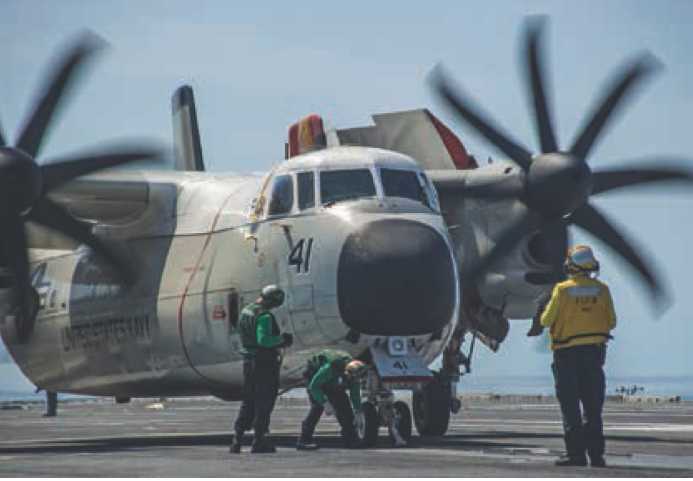
C-40A Clipper Navy Unique Fleet Essential Airlift (NUFEA)
Description
The Naval Air Force Reserve provides 100 percent of the Navy's organic intra-theater logistics airlift capability via the Navy Unique Fleet Essential Airlift community. NUFEA provides Navy component commanders with short-notice, fast-response, intra-theater logistics support for naval power projection worldwide. The legacy C-9B and C-20G aircraft are being replaced by the C-40A Clipper, a modified Boeing 737-700/800 series aircraft. This state-of-the-art aircraft can transport 121 passengers (passenger configuration), 40,000 pounds of cargo (cargo configuration), or a combination of the two (combination configuration), at ranges greater than 3,000 nautical miles at Mach 0.8 cruise speed. Maximum gross takeoff weight is 171,000 pounds. The unique ability to carry cargo pallets and passengers simultaneously maximizes the operational capability, flexibility, safety, and capacity. The C-40A has an electronic light deck fully compliant with future communications, navigation, and air traffic control mandates; advanced technology Stage III noise-compliant, fuel-efficient engines; and an integral cargo door/ cargo handling system.
Status
Fifteen aircraft are in the C-40A inventory in late 2016. The Navy has purchased the aircraft via commercial-off-the shelf standards using standard best commercial practices. C-40A squadrons are located at Naval Air Station Oceana, Virginia; Naval Base Coronado/Naval Air Station North Island, California; Naval Air Station Jacksonville, Florida; Naval Air Station/Joint Reserve Base Fort Worth, Texas; and Naval Air Station Whidbey Island, Washington.
Developers
The Boeing Company Seattle, Washington
* * * * * * * * * * * *

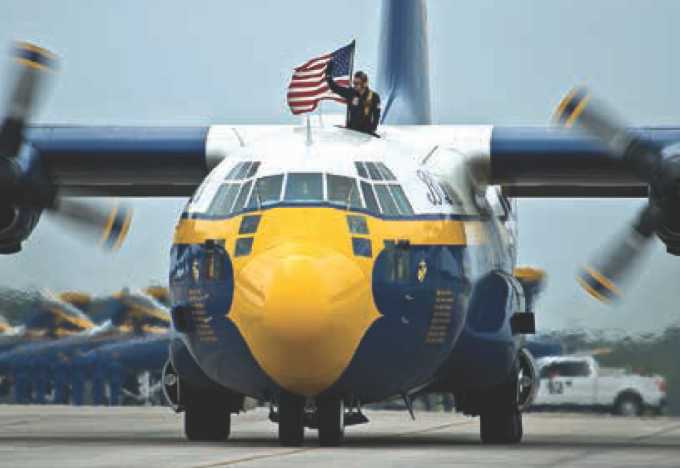
C-130T Hercules Intra-Theater Airlift Aircraft
Description
The Navy C-130T Hercules — a component of the Navy Unique Fleet Essential Airlift (NUFEA) community — provides heavy, over-, and outsized-organic airlift capability. These aircraft are deployed worldwide and provide rapid-response direct support to Navy component commanders' theater requirements. This aircraft can be reconfigured within minutes to transport up to 40,000 pounds of cargo or up to 75 passengers.
Status
The Navy has started a program to upgrade its C-130T aircraft to meet all current and future communications navigation surveillance/air traffic management requirements. These NUFEA, heavy-lift aircraft are stationed at Naval Air Station Jacksonville, Florida; Naval Air Station Joint Reserve Base New Orleans, Louisiana; Joint Base Andrews/Naval Air Facility Washington, DC; Naval Base Ventura County/Naval Air Station Point Mugu, California; and Joint Base McGuire/Dix/Lakehurst, New Jersey.
Developers
Lockheed Martin Bethesda, Maryland
Marietta, Georgia
* * * * * * * * * * * *
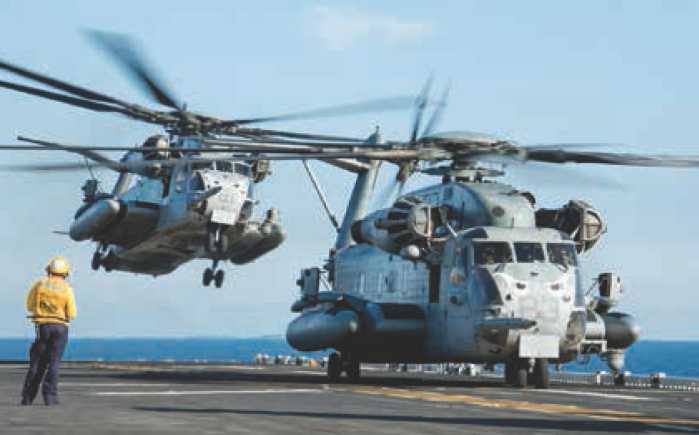
CH-53E Super Stallion Helicopter Description
The CH-53E entered service in 1981 and in late 2016 is the only heavy-lift helicopter in the Department of Defense (DoD) rotor-craft inventory. The 2017 force construct is eight active component HMH squadrons and one reserve component HMH. The Super Stallion fleet has enabled heavy-lift assault support operations in Afghanistan, Iraq, and the Horn of Africa and is forward deployed in support of Marine Expeditionary Units, Unit Deployment Program Okinawa, Marine Rotational Force-Darwin, and Special-Purpose Marine Air-Ground Task Forces. The past 15 years of combat operations and humanitarian crises have validated the relevance of vertical heavy lift by MAGTF and joint force commanders alike. The CH-53E inventory is 146 aircraft. Replacement production capacity does not exist, nor are there CH-53Es available in war storage. Flow aircraft inventory is aggravated by pipeline aircraft (aircraft receiving modifications, depot-level repairs, and standard depot-level maintenance), which creates a shortfall of physical assets available for tasking on the flight line. As a result of this shortfall, a squadron's primary aircraft inventory is 12 aircraft. Transition to the Heavy-Lift Replacement CH-53K will enable re-distribution of CH-53E aircraft, allowing squadrons to return to 16 aircraft.
Status
The CH-53E Readiness Recovery Effort (RRF) is addressing recommendations from the Super Stallion Independent Readiness Review conducted to assist the CH-53E community to achieve and maintain full readiness until CH-53K full operational capability in 2029. The recovery plan is a three-year process extending through FY 2019, and the "reset" of all 146 aircraft by 2020 is the main effort. Reset specification consists of all maintenance requirement cards including phase cycle and calendar/special inspections improving serviceability and material condition of the aircraft. Upon completion, the squadron will conduct a full functional check-light to ensure the aircraft is returned full mission capable with zero outstanding awaiting maintenance discrepancies.
Other RRF elements include procurement of the correct amount of individual material readiness list and support equipment, functional check-flight training for pilots and crew chiefs, procure five portable electronic maintenance aids per aircraft, ix all technical publication discrepancy reports, reconstitute MH-53Es stored at Aerospace Maintenance and Regeneration Group for stick and rudder aircraft at Marine Heavy Helicopter Training Squadron-302, Contract Maintenance Field Teams, and fully fund program related logistics.
It is imperative to sustain the CH-53E fleet, as the aircraft will continue to support the full spectrum of assigned combat operations and scheduled deployments during the transition to the CH-53K.
Developers
Sikorsky Aircraft Corporation Stratford, Connecticut
* * * * * * * * * * * *
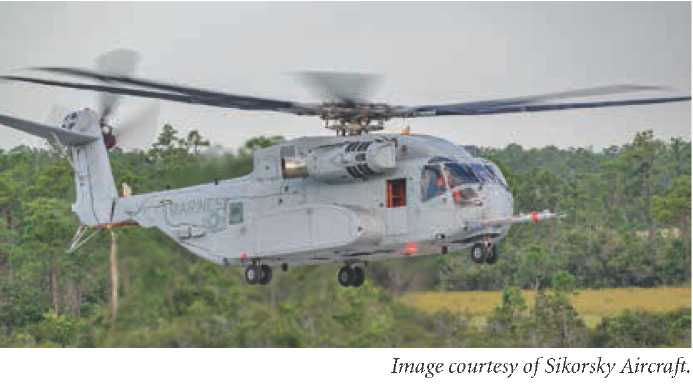
CH-53K King Stallion Heavy-Lift Replacement (HLR) Helicopter
Description
The CH-53K is the follow-on to the Marine Corps CH-53E Super Stallion heavy-lift helicopter. Major systems improvements of the newly manufactured helicopter include more powerful engines, expanded gross weight airframe, drive train, advanced composite rotor blades, glass cockpit, external and internal cargo handling systems, and enhanced survivability. The CH-53K will be capable of externally lifting 27,000 pounds on a standard sea level hot day (103° Fahrenheit) to a range of 110 nautical miles and delivering cargo in a landing zone at a pressure altitude of 3,000 feet and 91.5°F, a capability improvement nearly triple the in-service CH-53E. Additionally, the CH-53K will be capable of transporting 30 combat-loaded troops. The CH-53K's increased capabilities are essential to meeting the Marine Corps Expeditionary Force 21 Capstone Concept and ship-to-objective maneuver requirements. The CH-53K fully supports the joint operational concept of full-spectrum dominance by enabling rapid, decisive operations and the early termination of conflict by projecting and sustaining forces in denied environments. The expeditionary maneuver warfare concept establishes the basis for the organization, deployment, and employment of the Marine Corps to conduct maneuver warfare and provides the doctrine for effective joint and multinational operations.
Status
The Navy awarded Sikorsky Aircraft Corporation the post-Milestone B system development and demonstration contract on April 5, 2006. The program conducted preliminary design review during the fourth quarter FY 2008. The critical design review successfully completed ahead of schedule in the third quarter FY 2010, and the program has transitioned from the design to the manufacturing phase. The Navy awarded two contracts to Sikorsky to build a total of six System Demonstration Test Articles (SDTAs); the first was awarded in the third quarter FY 2013 for four SDTAs and the second in the fourth quarter FY 2016 for two SDTAs. The SDTAs will be the first fleet representative CH-53K helicopters delivered and will be used for operational test and evaluation. In early 2015, the ground test vehicle executed the ground test program; mounted to the test pedestal, the test vehicle completed bare head light off of all engines and initial shake down testing with all engines operating and rotor system turning. Four engineering demonstration models are conducting the light test phase that began on October 27, 2015 with first light. Major milestones planned for the CH-53K are to achieve Milestone C and receive a flow-rate initial production contract second quarter FY 2017 and reach initial operational capability in 2019 and full operational capability in 2009. The Marine Corps requirement is 200 aircraft.
Developers
Sikorsky Aircraft Corporation
Lockheed Martin Corporation Stratford, Connecticut
* * * * * * * * * * * *
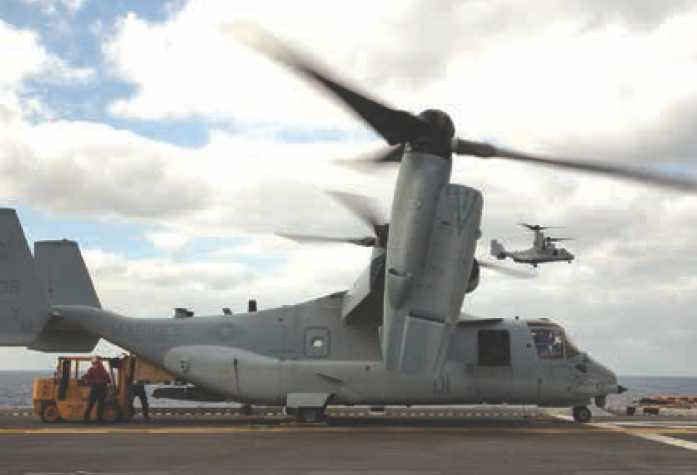
CMV-22B Osprey Tilt-Rotor Aircraft
Description
The CMV-22B Osprey will provide the Joint Force Maritime Component Commander time-critical logistics support, transporting personnel, mail, and priority cargo from advance bases to the sea base. As an aerial resupply/logistics for sea basing (AR/LSB) capability, the CMV-22B's primary mission is carrier onboard delivery, but it also fulfills secondary missions of vertical on-board delivery, vertical replenishment, medical evacuation, Naval Special Warfare support, missions of state (diplomatic presence and distinguished visitor movement), humanitarian assistance/disaster relief, and search and rescue. Two Fleet Logistics Support squadrons—located at Naval Air Station North Island, California, and Naval Station Norfolk, Virginia—and the Forward-Deployed Naval Forces detachment in Japan will operate CMV-22Bs. The Navy will leverage existing Marine Corps logistics, maintenance and training processes, including the V-22 Fleet Replacement Squadron at Marine Corps Air Station New River, North Carolina, for pilot and aircrew training. In a basic transport mission profile, the CMV-22B provides significant range/payload increase over the C-2 Greyhound.
Status
The Navy will procure 44 aircraft, achieving an initial operational capability in 2021 and full operational capability in 2023. The Navy issued a contract in the second quarter FY 2016 to develop the engineering change to meet the AR/LSB mission. This includes an extended-range fuel configuration, a public address system, and secure beyond-line-of-sight communications capability. Future developments include: production contract award in FY 2018; first aircraft delivery in FY 2020; complete CMV-22B AR/LSB developmental and operational testing in FY 2021; the first detachment of three aircraft able to deploy in FY 2021; and ability to support major combat operations in FY 2013.
Developers
Bell/Textron Fort Worth, Texas
The Boeing Company Philadelphia, Pennsylvania
Rolls Royce Indianapolis, Indiana
* * * * * * * * * * * *
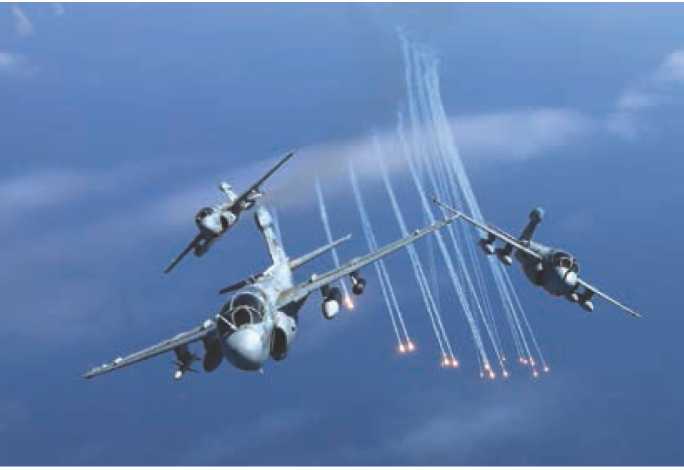
EA-6B Prowler
Airborne Electronic Attack (AEA) Aircraft Description
The EA-6B Prowler provides airborne electronic warfare (EW) attack capabilities against enemy systems operating within the radio frequency spectrum. EA-6B capabilities traditionally support the strike capabilities of joint force operations, aircraft carrier air wings, and Marine Air-Ground Task Forces (MAGTFs). The need for EW demonstrably increased during numerous joint and allied operations since 1991 against traditional and non-traditional target sets in support of ground forces. The enormous demand for AEA in support of worldwide airborne electronic attack requirements have driven EA-6B and AEA operational employment rates to record levels.
Status
The EA-6B Improved Capability (ICAP) III upgrade reached initial operational capability in September 2005. This generational leap in AEA capability deployed for the first time in 2006. ICAP III includes a completely redesigned receiver system (ALQ-218), new displays, and MIDS/Link-16, which dramatically improve joint interoperability. The Navy completed "sundown" of the Prowler and transitioned to an all EA-18G Growler force in April, 2016. The Marine Corps will fly the EA-6B ICAP III through 2019. The Joint Strike Fighter F-35B Lightning LL and a series of networked air and ground EW payloads on manned and unmanned platforms, forming a collaborative system of systems labeled "MAGTF EW," will replace and expand Prowler capabilities, providing increased EW capacity, flexibility, and scalability in direct support of the MAGTF commander and joint forces. The first implementation of MAGTF EW, the Intrepid Tiger II pod carried on the AV-8B Harrier LL+, made its initial deployment in May 2012 and on a Marine Corps F/A-18 Hornet in June 2014.
Developers
Naval Air Warfare Center,
Weapons Division Point Mugu, California
Northrop Grumman Bethpage, New York
* * * * * * * * * * * *

EA-18G Growler
Airborne Electronic Attack (AEA) Aircraft Description
The EA-18G Growler is replacing the Navy's EA-6B Prowler. The EA-18G provides full-spectrum airborne electronic attack (AEA) capabilities to counter enemy air defenses and communication networks, most notably anti-radiation missiles. These capabilities continue to be in high demand in overseas contingency operations, where Growler operations protect coalition forces and disrupt critical command and control links. The Growler maintains a high degree of commonality with the F/A-18F Super Hornet, retaining a great deal of the latter's inherent strike-fighter and self-protection capabilities while providing air-to-air self-protection, thus freeing other assets for additional strike-fighter tasking.
Status
Growler reached initial operational capability in September 2009 and in late 2016 is in full-rate production. In December 2009, the Department of Defense decided to continue the Navy Expeditionary AEA mission and recapitalize the Navy EA-6B expeditionary force with the EA-18G. As a result, 26 additional aircraft were programmed for procurement for three active and one reserve expeditionary squadrons. All three active component expeditionary squadrons have transitioned to the EA-18G. The FY 2014 President's budget requested 21 additional EA-18Gs to stand-up two more expeditionary squadrons. The first EA-18G deployment occurred in November 2010 in an expeditionary role supporting Operation New Dawn and in March 2011 in support of Operations Odyssey Dawn and Unified Protector, during which the EA-18G conducted combat operations. The first carrier deployment occurred in May 2011 on board the USS George H. W. Bush (CVN 77). Final deliveries will complete in FY 2018. The inventory objective of 160 aircraft will support ten carrier-based squadrons, five active expeditionary squadrons, and one reserve squadron. Full operational capability is planned for FY 2017.
Developers
The Boeing Company St. Louis, Missouri
Northrop Grumman Bethpage, New York
* * * * * * * * * * * *
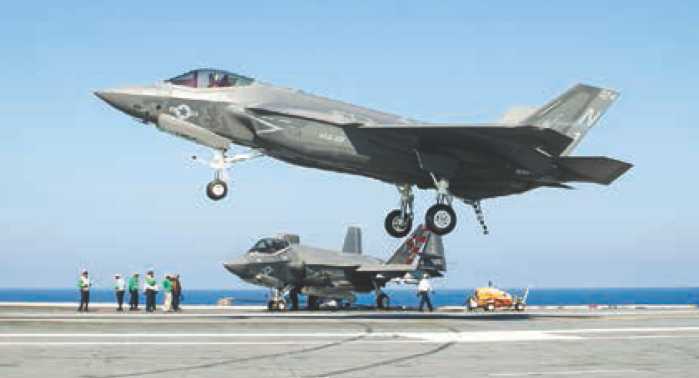
F-35 Lightning II Joint Strike Fighter (JSF) Description
The Joint Strike Fighter program is delivering a transformational family of next-generation strike aircraft, combining stealth and enhanced sensors to provide lethal, survivable, and supportable tactical jet aviation strike fighters. The F-35C carrier variant, the F-35B short takeoff and vertical landing, and F-35A conventional takeoff and landing "family of aircraft" designs share a high level of commonality and meet U.S. service and allied partner requirements. The keystone of this effort is a mission systems avionics suite that delivers unparalleled interoperability among U.S. armed services and coalition partners. Agreements for international participation in the program have been negotiated with Australia, Canada, Denmark, Italy, the Netherlands, Norway, Turkey, and the United Kingdom. Israel, Japan, and the Republic of Korea selected the F-35 through the U.S. Foreign Military Sales program. In U.S. service, the F-35C will replace F/A-18A-C aircraft and complement the F/A-18E/F Super Hornet. The F-35B will replace Marine F/A-18s, AV-8Bs and EA-6Bs.
Status
As of September 2016, the Department of the Navy had taken delivery of 52 F-35Bs and 24 F-35Cs. After successfully completing two amphibious ship developmental test (DT) periods, the F-35B variant successfully carried out its third and final DT trial in October 2016. The F-35C completed its third and final shipboard developmental test period in August 2016 on the USS George Washington (CVN 73). The Marine Corps declared F-35B initial operational capability in July 2015 and will permanently base its first operational squadron, VMFA-121, at Marine Corps Air Station Iwakuni, Japan, in January 2017. The first F-35B shipboard operational deployment is scheduled for spring 2018. The Navy's F-35C IOC is planned in 2018 and coincides with stand up of the first operational F-35C squadron at Naval Air Station Lemoore, California. The first F-35C shipboard operational deployment is scheduled for spring 2021.
Developers
Lockheed Martin Fort Worth, Texas
Pratt & Whitney Hartford, Connecticut
* * * * * * * * * * * *
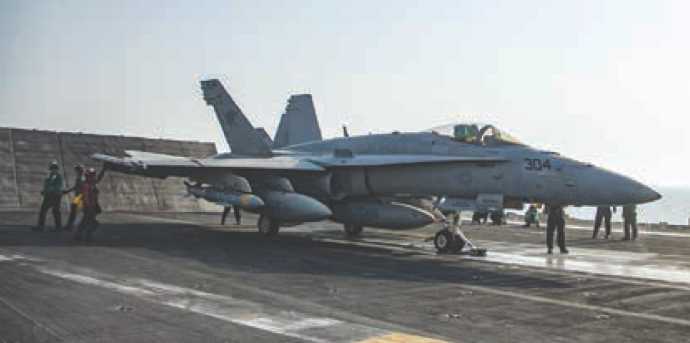
F/A-18A-D Hornet Strike-Fighter Aircraft
Description
The F/A-18 Hornet is a multi-mission strike fighter that combines the capabilities of a fighter and an attack aircraft. The single-seat F/A-18A and two-seat F/A-18B became operational in 1983. Eventually, the Hornet replaced the Navy's A-6 Intruder, A-7 Corsair LL, and F-4 Phantom LL and the Marine Corps F-4 aircraft. Reliability and ease of maintenance were emphasized in the Hornet's design, and F/A-18s have consistently flown three times as many hours without failure as other Navy tactical aircraft while requiring half the maintenance time.
The F/A-18 is equipped with a digital fly-by-wire light control system that provides exceptional maneuverability and allows the pilot to concentrate on operating the aircraft's weapons system. A solid thrust-to-weight ratio and superior turn characteristics, combined with energy sustainability, enable the Hornet to defeat any adversary. The ability to sustain evasive action is what many pilots consider to be the Hornet's finest trait. The F/A-18 is the Navy's first tactical jet to incorporate digital-bus architecture for the entire avionics suite, making this component of the aircraft relatively easy to upgrade on a regular and affordable basis.
Following a production run of more than 400 F/A-18A/Bs, deliveries of the single-seat F/A-18C and two-seat F/A-18D began in September 1987. The F/A-18C/D models incorporated upgrades for employing updated missiles and jamming devices. These versions are armed with the AIM-120 Advanced Medium-Range Air-to-Air Missile and the infrared-imaging version of the AGM-65 Maverick. The Hornet is battle tested and a proven, highly reliable and versatile strike fighter. Navy and Marine Corps Hornets were in the forefront of strikes in Afghanistan in 2001 during Operation Enduring Freedom, where they continue to serve, and in Iraq in 2003 during Operations Iraqi Freedom/New Dawn. The latest lot of F/A-18C/D Hornets is far more capable than the first F/A-18A/Bs. Although the F/A-18C/D's growth is limited, the Hornet will continue to ill carrier air wings for years to come, before gradually giving way to the larger, longer-range and more capable F/A-18E/F Super Hornet and the F-35 Lightning LL Joint Strike Fighter. The last Hornet, an F/A-18D, rolled off the Boeing production line in August 2000.
Status
As of September 2016, the Navy and Marine Corps had 92 F/A-18A, 21 F/A-18B, 359 F/A-18C and 129 F/A-18D aircraft in service and test roles, and two NF/A-18C and two NF/A-18D versions in permanent test roles. Hornets equip 16 active Navy and Marine Corps and three Navy and Marine Corps Reserve strike fighter squadrons, two fleet replacement squadrons, three air-test and evaluation squadrons, the Navy's Flight Demonstration Squadron (Blue Angels), and the Naval Strike and Air Warfare Center.
Developers
The Boeing Company St. Louis, Missouri
General Electric Lynn, Massachusetts
* * * * * * * * * * * *
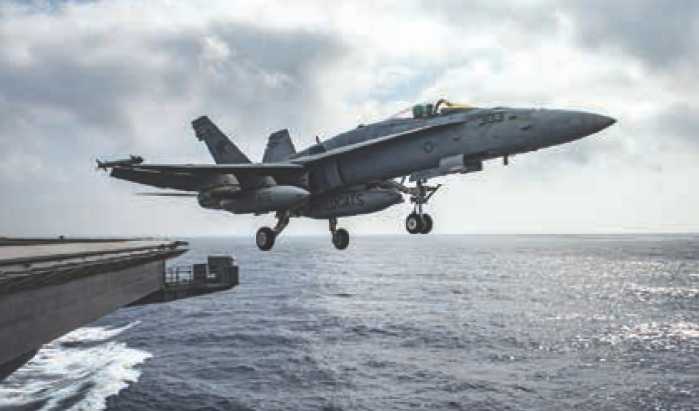
F/A-18E/F Super Hornet Strike-Fighter Aircraft
Description
The multi-mission F/A-18E/F Super Hornet strike fighter is an evolutionary upgrade of the F/A-18C/D Hornet. The F/A-18E/F is able to conduct unescorted strikes against highly defended targets early in a conflict. The Super Hornet provides the carrier strike group with a strike fighter that has significant growth potential and more than adequate carrier-based landing weight, range, endurance, and ordnance-carrying capabilities comparable to those of the F-14 Tomcat and F/A-18A/C Hornet it replaces. The single-seat F/A-18E and the two-seat F/A-18F have a 25 percent larger wing area and a 33 percent higher internal fuel capacity that effectively increase endurance by 50 percent and mission range by 41 percent. It has five "wet" stations that give the Super Hornet in-light tanker capability.
The Super Hornet incorporates two additional wing stations that allow for increased payload flexibility in the mix of air-to-air and air-to-ground ordnance. The F/A-18E/F can carry a full array of the newest joint "smart" weapons, such as the Joint Direct-Attack Munition (JDAM) and the Joint Standoff Weapon (JSOW). The Super Hornet has the ability to recover aboard a carrier with optimum reserve fuel while carrying a load of precision-strike weapons; its carrier-recovery payload is more than 9,000 pounds.
The Super Hornet also has the space, power, and cooling capability needed to accommodate valuable but installation-sensitive avionics when they become available, including the Active Electronically Scanned-Array (AESA) radar that is installed on approximately 85 percent of delivered Super Hornets. Sophisticated systems such as the Integrated Defensive Electronic Countermeasures System, Advanced Targeting Forward Looking Infrared, Joint Helmet- Mounted Cueing System, JDAM and JSOW, AIM-9X Sidewinder Short-Range Air-to-Air Missile and AIM-120 Advanced Medium-Range Air-to-Air Missile, APG-79 AESA radar system, and advanced mission computers and displays make the F/A-18E/F an extremely capable and lethal strike platform. Future planned upgrades include the AIM-120D, the AGM-88E Advanced Anti-Radiation Guided Missile, and cockpit and display improvements. The first operational Super Hornet squadron (VFA-115) deployed on board the USS Abraham Lincoln (CVN 72) on July 24, 2002, for a ten-month deployment that included initial operations in support of Operation Iraqi Freedom. At the forefront of combat operations, Super Hornet squadrons are integrated into all ten Navy carrier air wings, and with future capability upgrades, are well suited to complement the F-35 Lightning LL Joint Strike Fighter.
Status
As of September 2016, there were 287 F/A-18E models and 259 F/A-18F models in U.S. Navy inventory. The FY 2016 program of record is 584 aircraft.
Developers
The Boeing Company St. Louis, Missouri
General Electric Lynn, Massachusetts
* * * * * * * * * * * *
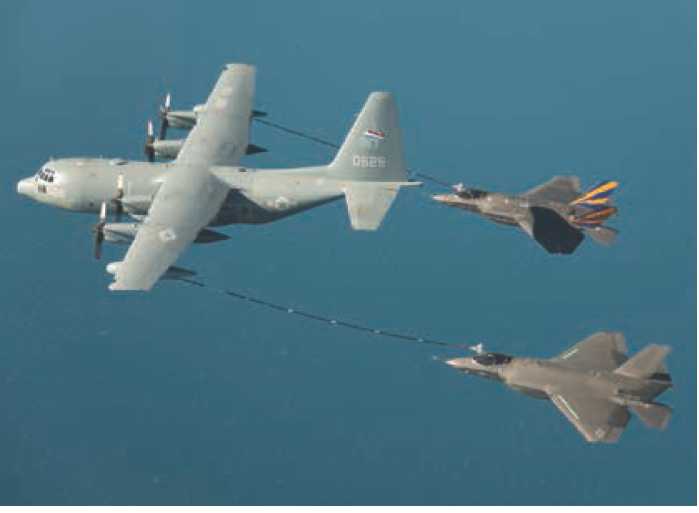
KC-130J Hercules Tactical Tanker and Transport
Description
The KC-130J is a four-engine turbo-prop, multi-role, multi-mission tactical aerial refueler, and tactical transport aircraft that supports all six functions of Marine Aviation and is well suited to meet the mission needs of forward-deployed Marine Air-Ground Task Forces (MAGTFs). The Hercules provides the six functions:
(1) fixed-wing, rotary-wing, and tilt-rotor tactical air-to-air refueling; rapid ground refueling of aircraft and tactical vehicles;
(2) assault air transport of air-landed or air-delivered personnel, supplies, and equipment; (3) command-and-control augmentation; (4) battlefield illumination; (5) tactical aero medical evacuation; and (6) combat search and rescue. When equipped with the Harvest HAWK Intelligence Surveillance Reconnaissance Weapon Mission kit, the aircraft can perform multi-sensor image reconnaissance and provide close air support. With its increase in speed, altitude, range, performance, state-of-the-art light station that includes two heads-up displays, night vision lighting, an augmented crew station, fully integrated digital avionics, enhanced air-to-air refueling capability, and aircraft survivability enhancements, the KC-130J will provide the MAGTF commander with multi-mission capabilities well into the 21st Century.
Status
The Marine Corps requirement is 79 KC-130Js. As of September 2016, the KC-130J inventory totaled 50 aircraft. Fourteen KC-130T model aircraft operated by the Reserves are yet to be replaced.
Developers
Lockheed Martin Marietta, Georgia
* * * * * * * * * * * *
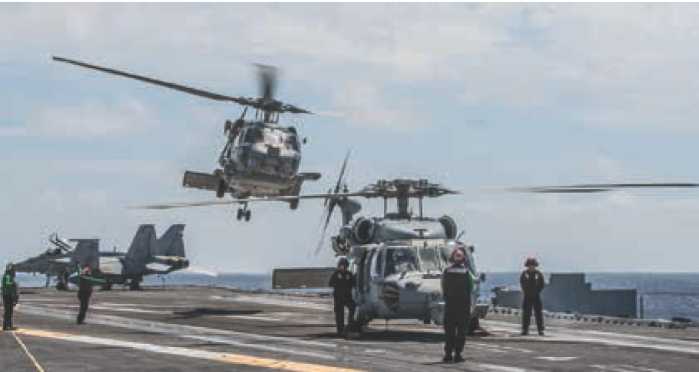
MH-60R/S Seahawk Multi-mission Combat Helicopter
Description
The MH-60R and MH-60S Seahawk multi-mission combat helicopters are the two pillars of the Navy's 21st-Century air wing. MH-60R/S squadrons deploy on aircraft carriers, elements of the carrier air wing, and strike group surface warships. Expeditionary squadrons deploy as detachments embarked on amphibious assault ships, surface combatants, and logistics vessels. The MH-60R provides anti-submarine and surface warfare capability with a suite of sensors and weapons that includes airborne flow-frequency dipping sonar, surface search radar with automatic periscope detection and discrimination modes, electronic support measures, advanced forward-looking infrared (FLIR) sensors, precision air-to-surface missiles, and torpedoes. The MH-60R is the only airborne anti-submarine warfare asset in strike groups and on independently deploying warships. The MH-60S provides surface and mine countermeasure warfare capabilities, as well as robust Naval Special Warfare, search and rescue, combat search and rescue, and logistics capability, with air-to-ground weapons and the same FLIR and Link-16 capability as the MH-60R. Airborne mine countermeasure operations will use advanced sensor and weapons packages to provide detection, localization, and neutralization of adversary "weapons that wait." MH-60R/S platforms are produced with 85 percent common components (e.g., common cockpit and dynamic components) to simplify maintenance, logistics, and training.
Status
The MH-60R was authorized to enter full-rate production in March 2006 and the last aircraft are scheduled for delivery in FY 2018. The Navy plans to acquire 280 MH-60Rs. The MH-60S was approved for full-rate production in August 2002 and the 275th and final MH-60S rolled off the line in January 2016. At the end of FY 2016, there were 226 MH-60R and 275 MH-60S helicopters in the inventory.
Developers
Lockheed Martin Owego, New York
Sikorsky Aircraft Corporation Stratford, Connecticut
* * * * * * * * * * * *
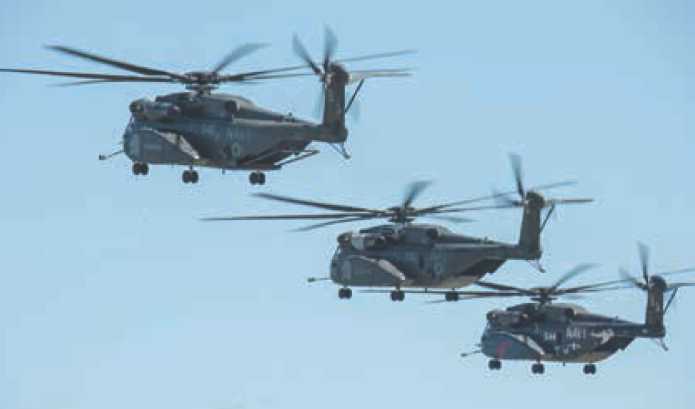
MH-53E Sea Dragon Airborne Mine Countermeasures (AMCM) Helicopter
Description
The MH-53E provides AMCM capability to naval forces through various mine-hunting and mine-sweeping systems. The MH-53E supports undersea warfare by defending the Fleet from surface and sub-surface mine threats and ensuring sea lines of communication remain passable for not only carrier and expeditionary strike groups, but also for vital commercial shipping. The MH-53E provides the Navy's only heavy-lift rotary-wing capability enabling over-the-horizon combat logistics support, pending delivery of the CH-53K King Stallion. Secondary missions include vertical onboard delivery, tactical aircraft recovery, humanitarian assistance and disaster relief, and Naval Special Warfare support.
The USS Ponce (AFSBI 15) has been designated an interim afloat forward-staging base and its replacement, the USNS Lewis B. Puller (T-ESB 3), has been designated an expeditionary sea base to provide staging for the MH-53E and associated airborne mine-hunting and mine-sweeping systems, enabling a more rapid and sustained deployment of AMCM forces.
Status
The MH-53E program is executing an in-service sustainment strategy to ensure continued AMCM and heavy-lift support to the sea base until the transition to the Littoral Combat Ship mine countermeasures mission package is complete. The sustainment strategy addresses fatigue, obsolescence, readiness, and safety issues. A fatigue life extension program has been completed, which extended the aircraft service life to 10,000 hours, enabling the Navy to maintain a dedicated AMCM capability through the 2025 timeframe.
Developers
General Electric Lynn, Massachusetts
Sikorsky Aircraft Corporation Stratford, Connecticut
* * * * * * * * * * * *

MQ-25 Carrier Based Aerial Refueling System
Description
The Deputy Secretary of Defense Resource Management Decision for the FY 2017 budget request restructured the Unmanned Carrier Based Reconnaissance and Strike (UCLASS) program to the Carrier Based Aerial Refueling System. Officially designated MQ-25 on July 13, 2016, MQ-25 will enhance aircraft carrier (CVN) capability and versatility for the joint force through integration of a persistent, multi-mission aerial refueling and intelligence, surveillance, and reconnaissance (ISR) unmanned aircraft system (UAS) into the carrier air wing (CVW). The ability of the CVW to provide an organic refueling capability is essential for performing blue-water light operations and achieving meaningful, extended range combat strike capabilities. MQ-25 will significantly extend the range, reach, and mission effectiveness of the CVW. Prior to MQ-25, there was no program to replace the refueling capability provided by F/A-18E/F Super Hornet strike fighters. MQ-25 will free up these strike fighters to execute their primary missions and preserve fatigue-life expenditure. Additionally, MQ-25 will provide a long-endurance ISR capability to address the CVW organic ISR capability gap. MQ-25 will pioneer the integration of manned-unmanned operations, mature complex sea-based C4I (command, control, communication, computers, and intelligence) UAS technologies, and pave the way for future multi-mission UASs to pace emerging threats. MQ-25 will reach initial operational capability by the mid-2020s.
Status
The Navy awarded four sole-source concept-refinement contracts to Boeing, General Atomics, Lockheed Martin, and Northrop Grumman in the fourth quarter FY 2016. The concept refinement effort will include MQ-25 technical and task analyses and, when applicable, also include prototyping and non-lying demonstration events. These activities will identify key system technologies, attributes, and approaches to optimize cost, schedule, and technical risk during engineering and manufacturing development (EMD) phase of the program. The program is on-track to release a final air system EMD request for proposal in the third quarter FY 2017 for a third quarter FY 2018 air system EMD contract award.
Developers
To be determined.
* * * * * * * * * * * *
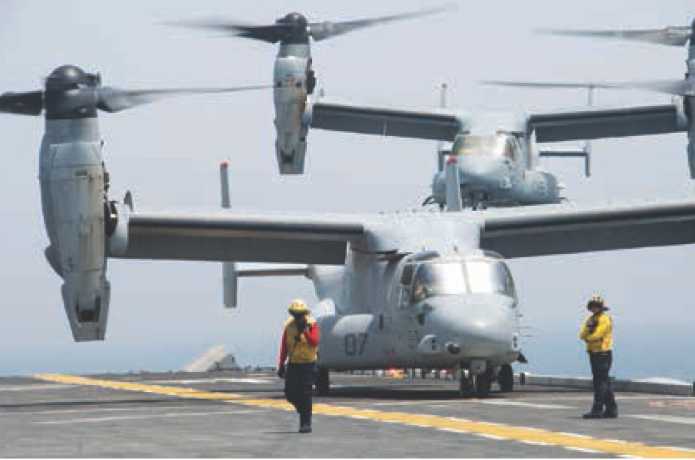
MV-22B Osprey Tilt-Rotor Aircraft
Description
The MV-22 Osprey is the world's first production tilt-rotor aircraft and blends the vertical light capabilities of helicopters with the speed, range, altitude, and endurance of fixed-wing transport aircraft. This combat multiplier represents a quantum improvement in strategic mobility and tactical flexibility for the Marine Corps, Navy, and Air Force. The Osprey has a 370-nautical mile combat radius, can cruise at 260 knots, and can carry 24 combat-equipped Marines or a 12,500-pound external load. With a 2,200 nautical-mile single-aerial refueling range, the aircraft also has a strategic self-deployment capability. Specific missions for the MV-22 include medium-lift expeditionary assault support, aerial delivery, tactical recovery of aircraft and personnel, casualty and humanitarian evacuation, rapid insertion and extraction, and airborne resupply/logistics support to the sea base. The MV-22 is the cornerstone of Marine Corps assault support capability, with the speed, endurance, and survivability needed to fight and win on tomorrow's battlefields.
Status
The Marine Corps transition to the MV-22 was 75 percent complete at the end of 2016; more than 280 of 360 aircraft have been delivered to 14 of 16 operational squadrons. In the years ahead, the MV-22 will remain the Nation's crisis-response platform of choice, and future MV-22s will provide aerial refueling of F/A-18, AV-8, and F-35 aircraft. Additionally, through Link-16 and software reprogrammable radios, the Osprey is digitally linked to the Marine Air-Ground Task Force, enhancing interoperability of ground and air forces during long-range operations. The Osprey will field an ability to provide all-aspect reactive fires and effective ballistic protection in hostile environments. Finally, the program is pursuing a common configuration, readiness, and modernization, ensuring operational relevance at a lower cost for decades to come.
Developers
Bell Helicopter Textron Fort Worth, Texas
Boeing Defense and Space Group, Helicopter Division Philadelphia, Pennsylvania
Rolls Royce Indianapolis, Indiana
* * * * * * * * * * * *
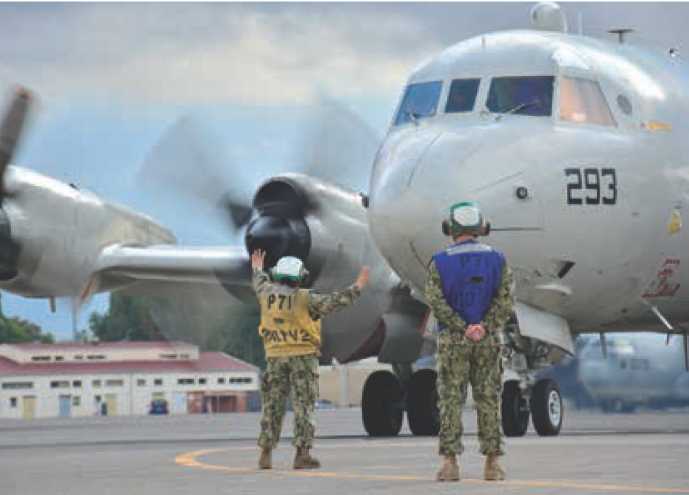
P-3C Orion Modification, Improvement, and Sustainment
Description
The legacy P-3C Orion maritime patrol aircraft provides antisubmarine warfare (ASW), anti-surface warfare (ASUW), and intelligence, surveillance, and reconnaissance (ISR) capabilities to naval and joint task force commanders and contributes directly to maritime domain awareness across the globe. Squadrons are based in Jacksonville, Florida; Whidbey Island, Washington; and Kaneohe Bay, Hawaii. Because of the P-3's range, endurance, and multi-mission capabilities, the aircraft has been in high demand for the past five decades and is nearing its end of service life.
The Navy's P-3 roadmap focuses on three areas: (1) airframe sustainment; (2) mission systems obsolescence; and (3) recapitalization to the P-8A Poseidon Multi-mission Maritime Aircraft. Regarding airframe sustainment, 39 aircraft were grounded on 27 December 2007, a result of on-going Fatigue Life Management Program analysis that revealed the aft lower surface of the outer-wing (Zone 5) experienced fatigue at higher levels than previously estimated. The Chief of Naval Operations approved a P-3 Recovery Plan that included a dual-path approach encompassing Zone 5 modifications to replace outer-wing components and manufacture new outer-wing assemblies where needed. The mission system sustainment program improves aircraft availability through replacement and upgrades to obsolete systems with modern hardware systems and software. These programs ensure the P-3C continues to meet Navy's ASW, ASUW, and ISR requirements through completion of the transition to the P-8A Poseidon in FY 2019.
Status
The Navy has successfully implemented its P-3C Fatigue Life Management Program. Through FY 2016, 60 of the 61 Special Structural Inspection-Kits and 89 of 90 Zone 5 modifications have been completed. Procurement of outer wing assemblies began in 2008, and installs commenced in 2011. By the end of FY 2016, 26 outer wing assemblies have been completed, with the last three aircraft in work.
Developers
Lockheed Martin Marietta, Georgia
Eagan, Minnesota Greenville, South Carolina Manassas, Virginia
* * * * * * * * * * * *
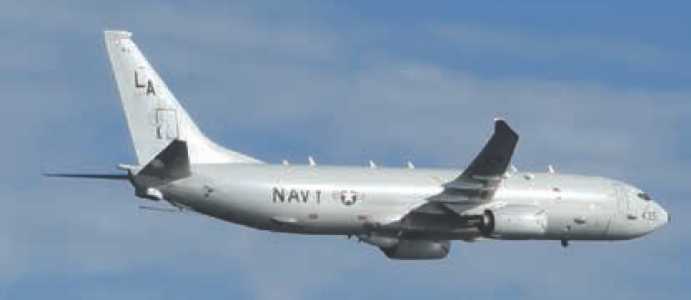
P-8A Poseidon Multi-mission Maritime Aircraft (MMA) Description
The P-8A Poseidon recapitalizes and improves the broad-area anti-submarine warfare (ASW), anti-surface warfare (ASUW), and intelligence, surveillance, and reconnaissance (ISR) capability resident in the legacy P-3C Orion. The P-8A combines the proven reliability of the commercial Boeing 737 airframe, powerplants, and avionics with an open architecture that enables the affordable integration of modern sensors and communications networks. The P-8A leverages global logistics support infrastructure and commercial training applications to provide both higher operational availability and improved warfighting readiness. The P-8A program invested in high-fidelity simulation to attain a 70/30-percent simulator/aircraft training ratio, significantly reducing life cycle costs for the life of the platform. The P-8A will be built with three incremental upgrades that include improved ASW sensors, network-enabled ASW and ASUW weapons, sensor and targeting enhancements, and improved communications capability.
Status
The P-8A Poseidon is meeting all cost, schedule, and performance parameters in accordance with the acquisition program baseline. In August 2010, the program successfully passed Milestone C and the first flow-rate initial-production (LRIP) aircraft delivered to Patrol Squadron Thirty (VP-30) at Naval Air Station Jacksonville, Florida in March 2012. The first operational VP squadron commenced transition from P-3C to P-8A in July 2012. The program achieved initial operational capability in December 2013, when the first P-8A squadron (VP-16) deployed to Kadena, Japan. The program was approved for full-rate production (FRP) in January 2014, and the Navy awarded the FRP Lot I contract for 16 aircraft in February 2014. By the end of FY 2016, seven lots of LRIP/ FRP aircraft, including 80 aircraft and associated trainers, spares and support equipment, were on contract with Boeing Defense Space and Security. Six fleet squadrons have completed transition to P-8A, with 45 aircraft delivered on or ahead of schedule. The seventh fleet squadron began transition in October 2016. The P-8A program continues to execute its evolutionary acquisition strategy. Increment 2 will deliver improved ASW capabilities as a series of three engineering change proposals (ECPs): multi-static active coherent high-altitude anti-submarine warfare sensors; high-altitude ASW weapon capability; and targeting enhancements. These ECPs will be incorporated in-line with production or via retrofit. Increment 3 will continue advanced development as a series of four ECPs, with initial operational capability in FY 2023. Increment 3 improves the warfighting capability of baseline P-8A to pace future threats and integrates a network-enabled ASUW weapon, advanced ASW and ISR sensors, precision targeting, and architecture upgrades to satisfy the Net-Ready Key Performance Parameter. The P-8A warfighting requirement is 117 aircraft.
Developers
The Boeing Company Renton, Washington
* * * * * * * * * * * *
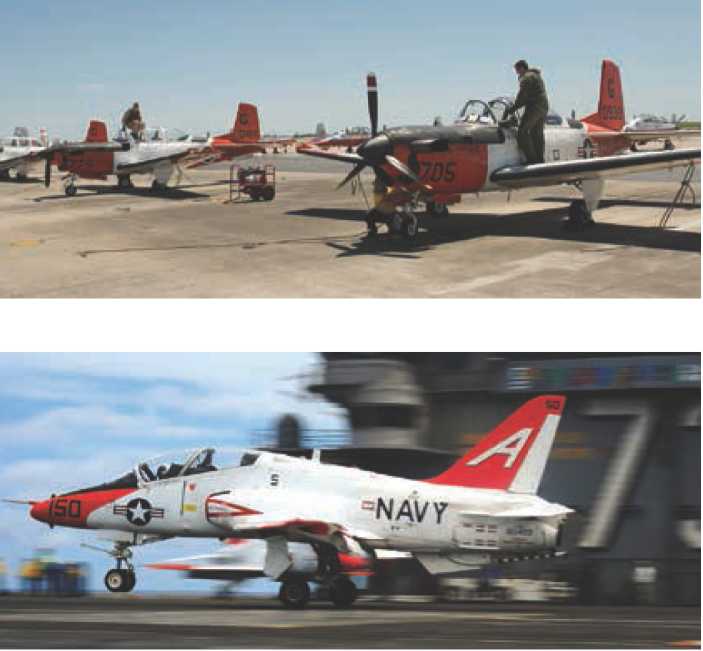
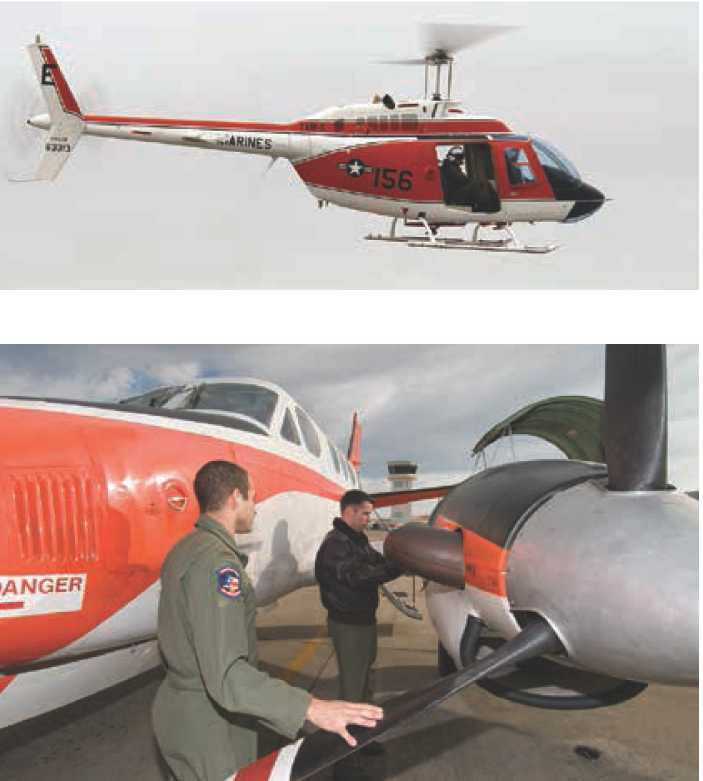
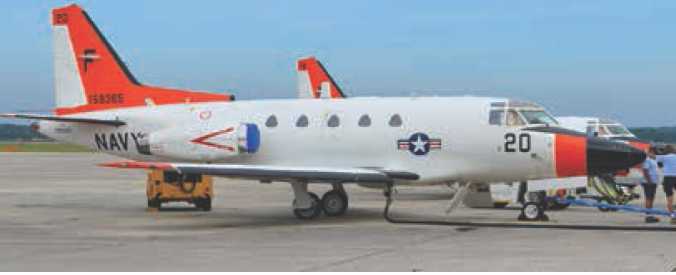
Naval Aviation Training Aircraft
Description
The Commander, Naval Air Training Command's (CNATRA) mission is to train and safely produce the world's finest combat aviation professionals—Naval Aviators and Naval Flight Officers—and deliver them at the right time, in the right numbers, and at the right cost to the Fleet for follow-on tasking. This mission is essential to generate the readiness the Fleet requires. CNATRA's training aircraft inventory includes the T-6A/B Texan LL, T-45 Goshawk, TH-57 Sea Ranger, T-44 Pegasus, and the TC-12 Huron.
All undergraduate military light officers (UMFOs) begin primary light training in the T-6B Texan LL. Built by Beechcraft Defense Corporation, the T-6B features a Pratt & Whitney PT-6A-68 engine with increased horsepower, ejection seats for increased safety, cockpit pressurization, onboard oxygen-generating systems, and a completely digital "glass" cockpit.
The T-45C Goshawk, a carrier-capable derivative of the British Aerospace Hawk, is used for intermediate and advanced training in the strike syllabus for jet pilots. Future upgrades include resolution of an engine-surge issue to enhance fuel efficiency and safety, and preservation of current aircraft through service life assessment and service life extension programs.
The TH-57 Sea Ranger, the Navy version of the commercial Bell Jet Ranger, is used for advanced training in the rotary-wing (helicopter) pilot syllabus.
The T-44 Pegasus and the TC-12 Huron are twin turboprop, pressurized, fixed-wing aircraft that are used for intermediate and advanced training for multi-engine and tilt-rotor pilots. Continued improvements to the T-44 include the replacement of wing wiring, simulator upgrades, and the conversion from analog to digital cockpits. The T-44 training system has received new simulators to replace the obsolete legacy instrument light trainers.
VFA (attack) and VAQ (electronic warfare) advanced UMFO training is in the T-45C. The T-45, integrated with the Virtual Mission Training System (VMTS), an embedded synthetic radar system, is used for the tactical maneuvering and advanced phase radar training portion of the VFA and VAQ UMFO syllabus. CNATRA has charted a course to revolutionize UMFO training by employing the T-6A, the T-45C with VMTS, and high-fidelity simulators to train future VFA and VAQ UMFOs. VP, VQ and VAW advanced UMFO training will be conducted in the multi-crew simulator (MCS). The MCS will focus on crew resource management, communications, and sensor integration and will provide intermediate and advanced training for all NFOs.
Status
The T-6 has completed production with an inventory of 295 aircraft, with the final lot aircraft delivered in June 2016. The TH-57B (visual light) and the TH-57C (instrument light) will be receiving minor avionics upgrades that will allow continued operation past 2020. The TC-12 will be phased out of advanced training by 2017.
Developers
The Boeing Company (T-45) St. Louis, Missouri
Hawker Beechcraft (T-6) Wichita, Kansas
* * * * * * * * * * * *
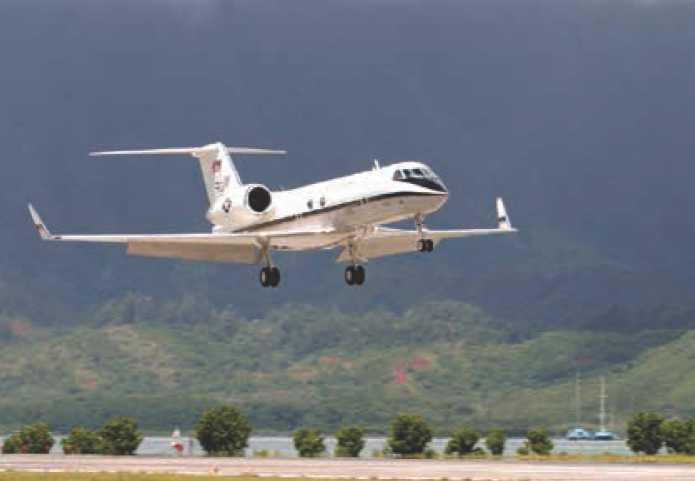
Service Secretary Controlled Aircraft/ Executive Airlift (SSCA/EA)
Description
The Department of the Navy maintains Service Secretary Controlled Aircraft/Executive Airlift in accordance with the Department of Defense Directive 4500.56. The SSCA aircraft are designated by the secretaries of the military departments for transportation of their senior Service officials. The offices of the Secretary of the Navy, Chief of Naval Operations, and Commandant of the Marine Corps coordinate with Fleet Logistics Support Squadron One (VR-1) for scheduling Navy and Marine Corps senior leader travel. At the discretion of the Secretary of the Navy, other SSCA/ EA aircraft are stationed outside of the continental United States to support senior leader travel. Three C-37Bs (Gulfstream-550), one C-37A (Gulfstream-V), and one C-20 (Gulfstream-LV) provide executive transport services. The C-37A/B meets all international-imposed air traffic management communications, navigation, and surveillance requirements.
Status
The first C-37 aircraft was delivered in 2002, a second aircraft in 2005, and two more in 2006. The Navy's first and only C-37A is based at Hickam Air Force Base, Hawaii. The C-37Bs and C-20Ds are based at Joint Base Andrews/Naval Air Facility Washington, D.C., and are assigned to Fleet Logistics Support Squadron One. Additionally, the Navy bases a C-20 at Naval Air Station Sigonella, Italy.
Developers
Gulfstream (General Dynamics) Savannah, Georgia
* * * * * * * * * * * *
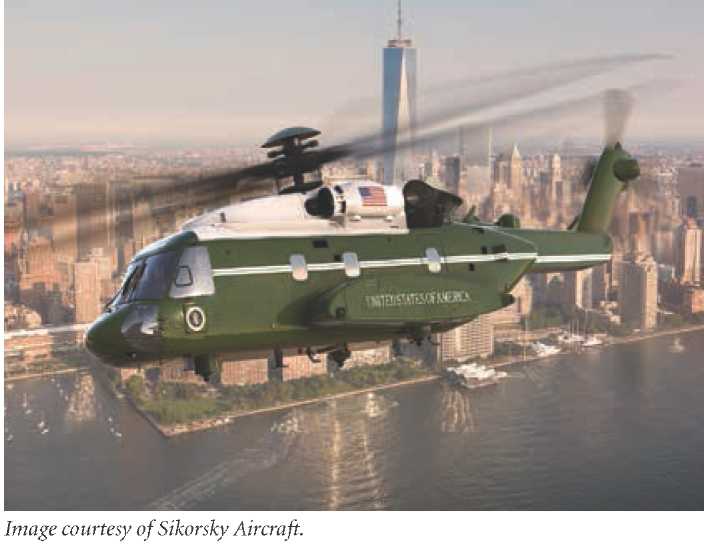
VH-92A Presidential Replacement Helicopter
Description
A replacement is required for the 41-year-old VH-3D Sea King and 25-year old VH-60N WhiteHawk helicopters that provide transportation for the President of the United States, foreign heads of state, and other dignitaries as directed by the White House Military Office. The Replacement Presidential Helicopter will provide a survivable, mobile command-and-control "VIP" transportation capability and a system-of-integrated-systems necessary to meet presidential transport mission requirements, including the ability to be globally transportable via Air Force Strategic Lift.
Status
The Presidential Helicopter Fleet Replacement Program became a formal ACAT-1D acquisition program in March 2014 when it successfully completed a Milestone B and the Defense Acquisition Board approved the program to enter the engineering manufacturing and development (EMD) phase. In May 2014, the Navy awarded an EMD contract with production options to Sikorsky Aircraft Corporation. Under the contract, Sikorsky will use its in-production S-92A medium-lift helicopter to integrate government-defined mission systems and install an executive interior. The program successfully completed critical design review in July 2016. First light and the beginning of contractor test are planned for April 2017, with the initial operational capability planned for 2020.
Developers
General Electric Lynn, Massachusetts Lockheed Martin Mission Systems and Training Owego, New York Sikorsky Aircraft Corporation, Lockheed Martin Stratford, Connecticut
* * * * * * * * * * * *
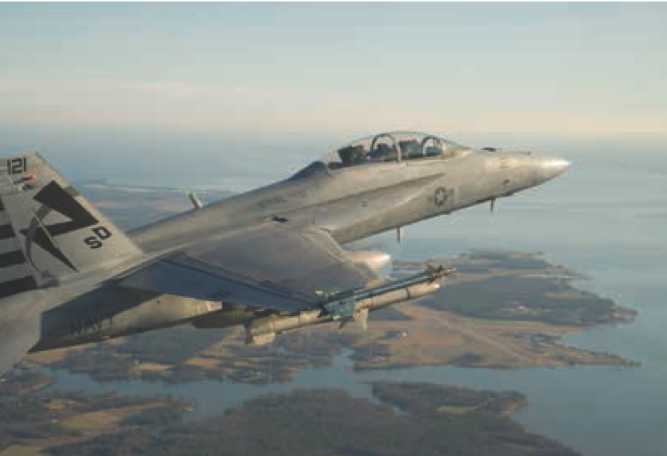
AVIATION WEAPONS
AGM-88E Advanced Anti-Radiation Guided Missile (AARGM)
Description
The U.S. Navy's AGM-88E AARGM is the latest evolution of the High-Speed Anti-Radiation Mission (HARM) weapon system. Prior to AARGM, HARM was the Navy's only anti-radiation, defense-suppression, air-to-surface missile. Employed successfully in naval operations for decades, HARM can destroy or suppress broadcasting enemy electronic emitters, especially those associated with radar sites used to direct anti-aircraft guns and surface-to-air missiles. Fielded configurations of HARM include AGM-88B (Block IIIA), AGM-88C (Block V), and AGM-88C (Block VA). The HARM program is a Navy-led joint-service (Navy, Air Force, and Marine Corps) program.
The AGM-88E program upgrades some of the existing HARM missile inventory with a new guidance section and a modified control section to incorporate multi-sensor, multi-spectral, digital anti-radiation homing detection capability, global positioning system/inertial navigation system guidance, and a millimeter-wave terminal seeker. AARGM also includes a netted situation awareness/targeting capability and weapon impact assessment reporting via direct connectivity with national technical means. The Department of Defense and the Ministry of Defense of the Republic of Italy have signed an international memorandum of agreement for cooperative development of AGM-88E. The AARGM system is a transformational and affordable upgrade to the legacy HARM.
Status
The AGM-88E program completed initial operational testing and evaluation and reached initial operational capability during the third quarter FY 2012. The full-rate production (FRP) decision was approved and first FRP contract was awarded in the fourth quarter FY 2012. AARGM is integrated on F/A-18C/D/E/F Hornet/ Super Hornet and EA-18G Growler aircraft. The Italian air force will integrate AARGM on the Tornado ECR aircraft in accordance with the international cooperative development program agreements. AARGM Block I software will be delivered to the Fleet in FY 2017, addressing discrepancies identified during operational test, which will increase lethality of the weapon. AARGM Extended Range began as a program of record in 2016 and will significantly increase the range of the AARGM weapons system and will allow for internal carriage in the F-35C Joint Strike Fighter. Initial operational capability is planned for 2023.
Developers
ATK Woodland Hills, California
* * * * * * * * * * * *
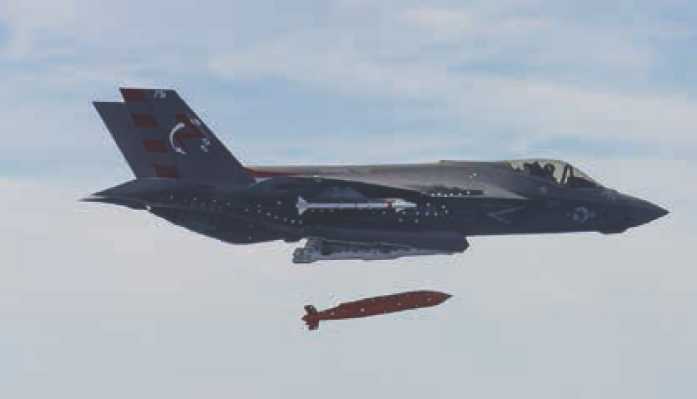
AGM-154 Joint Standoff Weapon (JSOW)
Description
The JSOW is a family of weapons that enables naval aircraft to attack targets at standoff distances using global positioning system/ inertial navigation system for guidance. All JSOW variants share a common body, but can be configured for use against area targets, bunker penetration, and ship attack. Defeating emergent, time-critical threats, whether in close-in proximity or over the horizon, requires an all-weather weapon capable of penetrating defended sanctuaries and destroying hostile targets while minimizing the danger of collateral damage to friendly and neutral shipping as well as friendly/neutral assets and personnel ashore. The JSOW Unitary (JSOW-C) variant adds an imaging infrared seeker and autonomous target acquisition to attack point targets with precision accuracy. The JSOW-C-1 incorporates new target-tracking algorithms into the seeker for moving targets, giving the joint force commanders an affordable, air-delivered, standoff weapon that is effective against fixed and re-locatable land and maritime targets. Used in conjunction with accurate targeting information and anti-radiation weapons, JSOW-C-1 will provide the capability to defeat enemy air defenses while creating sanctuaries that permit the rapid transition to flow-cost, direct-attack ordnance.
Status
AGM-154A reached initial operational capability (IOC) in 1999, and the AGM-154C variant achieved IOC in FY 2005. JSOW C-1 began procurement in FY 2011 and achieved IOC in June 2016. JSOW C-1 was procured through FY 2016.
Developers
Raytheon Tucson, Arizona
* * * * * * * * * * * *
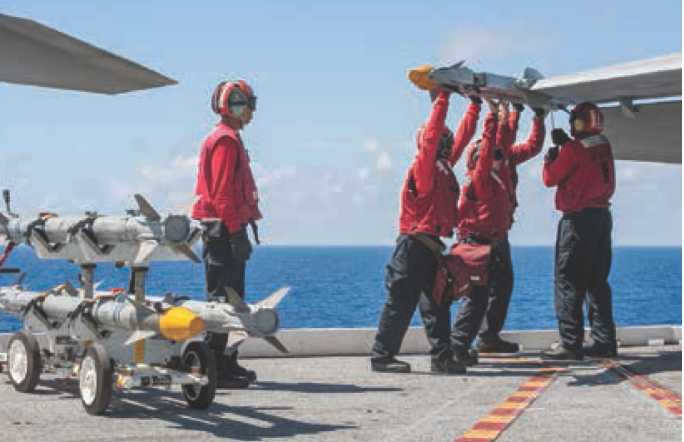
AIM-9X Sidewinder Short-Range Air-to-Air Missile (SRAAM)
Description
The AIM-9X Sidewinder is a fifth-generation all-aspect infrared (IR) day and night, beyond-visual-range, lock-on-after-launch missile with superior detection and tracking capability, high off-bore sight capability, robust IR counter-countermeasures, enhanced maneuverability, and growth potential via software improvements. The AIM-9X development leveraged existing AIM-9M components to minimize development risk and cost. Obsolescence and pre-planned product improvements efforts have been ongoing since initial operational capability in 2003. A series of independent engineering change proposals provided improved performance in the way of faster processors in the guidance control unit and an improved fuze/target detector (DSU-41) and data link component. These improvements led to the AIM-9X Block II missile program in FY 2011.
Status
The AIM-9X Block II procurement began in FY 2011. The AIM-9X Block II completed operational testing in FY 2015 and achieved initial operational capability in March 2015. AIM-9X Block II+ is being procured in 2017 for a 2019 delivery, which will provide F-35B/C Lightning LL additional survivability improvements compared to when carrying an AIM-9X Block II. Under the System Improvement Program III effort, the Navy is also addressing obsolescence concerns and cost avoidance measures and will ultimately field 9.4/10.4 software in 2020, improving the lethality of the weapons system.
Developers
Raytheon Tucson, Arizona
* * * * * * * * * * * *
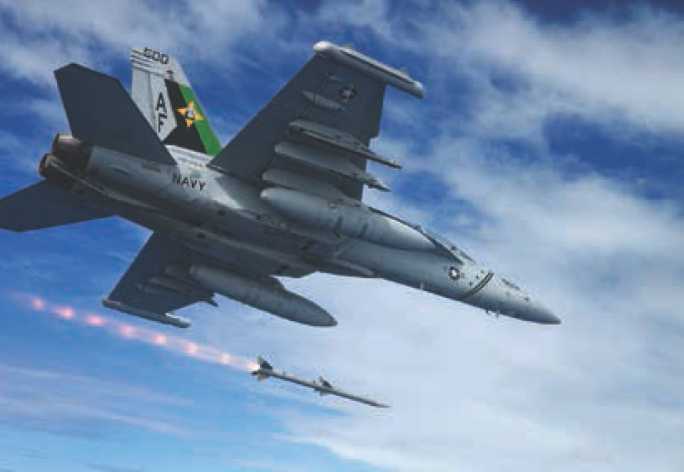
AIM-120 Advanced Medium-Range Air-to-Air Missile (AMRAAM)
Description
The AIM-120 AMRAAM is an all-weather, all-environment, radar-guided missile developed by the Air Force and Navy. The missile is deployed on the AV-8B Harrier, FA-18A-D Hornet, FA-18E/F Super Hornet, EA-18G Growler, and F-35B Lightning LL. AMRAAM will be deployed on F-35C Lightning LL when it achieves initial operational capability (IOC). Entering service in September 1993, AMRAAM has evolved to maintain air superiority through pre-planned product improvement programs. This modernization plan includes clipped wings for internal carriage, a propulsion-enhancement program, increased warhead lethality, and enhanced electronic counter-countermeasures capabilities through hardware and software upgrades. Additionally, the missile has improved capabilities against flow- and high-altitude targets in an advancing threat environment. AIM-120C7 completed production and AIM-120D production began in FY 2008. With the "sundown" of the AIM-7 Sparrow missile in 2018, AMRAAM will be the Services' sole medium/beyond-visual-range missile.
Status
The AIM-120C7 missile variant reached IOC in FY 2008. The AIM-120D completed operational test in fourth quarter FY 2014. The Navy achieved IOC of the latest hardware variant AIM-120D in January 2015. To pace the threat, the Navy has fielded the Electronic Protection Improvement Program (EPIP) Basic for AIM-120C3-C7 missiles and the System Improvement Program (SIP) 1 for AIM-120D in 2016. Advanced EPIP for AIM-120C7 is planned for 2017, and SIP 2 for AIM-120D will follow in 2018 to improve lethality further against the advancing threat.
Developers
Raytheon Tucson, Arizona
* * * * * * * * * * * *

Joint Direct-Attack Munition (JDAM, GBU-31/32/38) / Laser JDAM (GBU-54)
Description
The JDAM is an Air Force-led joint program for a global positioning system (GPS)-aided, inertial navigation system (INS) guidance kit to improve the precision of existing 500-pound, 1,000-pound, and 2,000-pound general-purpose and penetrator bombs in all weather conditions. JDAM addresses a broad spectrum of fixed and re-locatable targets at medium-range and releasing aircraft at high altitudes. The weapon is autonomous, all weather, and able to be employed against pre-planned targets or targets of opportunity. This weapon system has proven to be a true force multiplier, allowing a single aircraft to attack multiple targets from a single release point, and has proven its value during operations in Kosovo, Iraq, and Afghanistan.
In September 2006, the Departments of the Navy and Air Force put in place a flow-cost, non-developmental enhancement to the GBU-38 (500-pound) JDAM to address moving targets. Open competition and source selection completed in February 2010, and the Air Force awarded a contract to Boeing for a version of Laser JDAM (LJDAM) that provides a direct-attack moving-target capability. LJDAM (GBU-54) is a 500-pound dual-mode weapon that couples the GPS/INS precision of the JDAM and laser-designated accuracy of the laser-guided bomb into a single weapon. LJDAM also provides added capability and flexibility to the Fleet's existing inventory of precision-guided munitions to satisfy the ground moving-target capability gap.
Status
LRIP for the 2,000-pound kits began in FY 1997, and Milestone III was reached in FY 2001. The 1,000-pound JDAM kit reached initial operational capability (IOC) in FY 2002, and IOC for the 500-pound weapon occurred during the second quarter of FY 2005. LJDAM reached IOC in FY 2012. The Navy is developing the GBU-58 Laser JDAM for the BLU-109 penetrator to field in 2018 to replace the legacy GBU-24 Paveway III weapons systems.
Developers
The Boeing Company St. Louis, Missouri
Lockheed Martin Bethesda, Maryland
* * * * * * * * * * * *
Offensive Anti-Surface Warfare Increment 1 (OASuW Inc 1) Long-Range Anti-Ship Missile (LRASM)
Description
The Long-Range Anti-Ship Missile program will provide the first increment of next-generation anti-ship capabilities for the Navy and Air Force. The combatant commanders have an unmet urgent operational need to field improved anti-surface warfare capability. LRASM/ OASuW Increment 1 ills the most urgent air-launched requirement, significantly reduces joint force warfighting risks, and positions the Department of Defense (DoD) to address evolving surface warfare threats. In 2016, the Navy requested funds to begin the OASuW Increment 2 program to be a full and open competition to address the "sundown" of Harpoon 1C and SLAM-ER ASUW weapons in the mid 2020s.
Status
The OASuW Inc 1 program is a joint (DoN lead/USAF) accelerated acquisition program scheduled for early operational capability on the B-1 Lancer in the fourth quarter FY 2018 and on the FA-18E/F Super Hornet in the fourth quarter FY 2019. The OASuW Inc 1 capability development document (CDD) has been approved by the Joint Requirements Oversight Council (JROC), and the program passed its Knowledge Point 3 (Milestone B equivalent) in March 2016. The Navy has staffed the CDD for OASuW Increment 2 requirements for JROC validation in FY 2017.
Developers
Raytheon Tucson, Arizona
* * * * * * * * * * * *
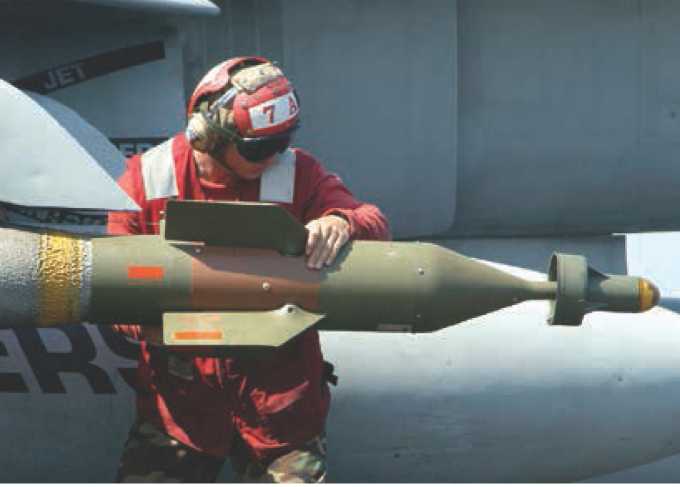
Paveway II Laser-Guided Bomb (LGB) / Dual-Mode LGB (GBU-10/12/16) and Paveway III (GBU-24) LGB
Description
The Paveway II/III laser-guided bomb program is an Air Force-led joint effort with the Navy. LGBs include GBU-10, -12, and -16, using Mk 80/Bomb-Live Unit (BLU) series general-purpose bomb bodies, and GBU-24, using the BLU-109 bomb body with updated guidance and control features. GBU-12 is a 500-pound class weapon; GBU-16 is a 1,000-pound class weapon; and GBU-10 is a 2,000-pound class weapon. An LGB has a Mk 80/BLU-series warhead fitted with a laser-guidance kit and computer control group mounted on the bomb nose. Legacy LGBs will remain in the Navy inventory through FY 2020. The Dual-Mode LGB (DMLGB) retrofits legacy LGBs to a dual-mode configuration using common components. This provides increased flexibility to the warfighter by combining proven laser terminal guidance technology with the all-weather, fire-and-forget capability of inertial navigation system/global positioning system. The DMLGB reached initial operational capability in September 2007 on the AV-8B Harrier LL+ and FA-18 Hornet/Super Hornet aircraft.
Status
Approximately 7,000 DMLGB kits have been procured. No future funding for DMLGB is planned, given the development of the dual-mode Laser Joint Direct Attack Munition.
Developers
Lockheed Martin Bethesda, Maryland
Raytheon Tucson, Arizona
* * * * * * * * * * * *
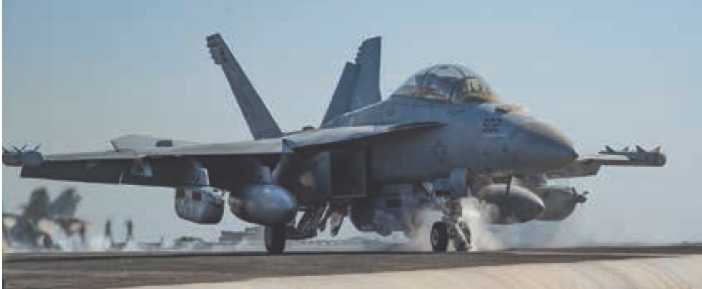
AVIATION SENSORS AND SYSTEMS
Airborne Electronic Attack (AEA) Next-Generation Jammer (NGJ)
Description
The Next-Generation Jammer is the replacement for the ALQ-99 Tactical Jamming System (TJS). Fielded in 1971, ALQ-99 is the only airborne tactical jamming system in the Department of Defense inventory. ALQ-99 is facing material and technological obsolescence and cannot counter all current, much less future, threats. The NGJ will provide significantly improved jamming capabilities with an open-system architecture that will support software and hardware updates to rapidly counter a wide variety of technically complex systems. It will be a full-spectrum jammer, developed in increments, and will initially be fielded on the EA-18G Growler. NGJ will be the prime contributor for the airborne electronic attack mission.
Status
NGJ Increment 1 achieved Milestone B in March 2016 and in late 2016 is executing the engineering, manufacturing and development (EMD) phase. The EMD contract was awarded to Raytheon in April 2016. Increment 2 is a FY 2016 new-start program. In FY 2017 Increment 2 is conducting technology studies, validating technology readiness levels, building and testing pod prototypes, and performing system-engineering tests.
Developers
The Boeing Company (Platform Prime) St. Louis, Missouri Raytheon (Pod Prime) El Segundo, California
* * * * * * * * * * * *
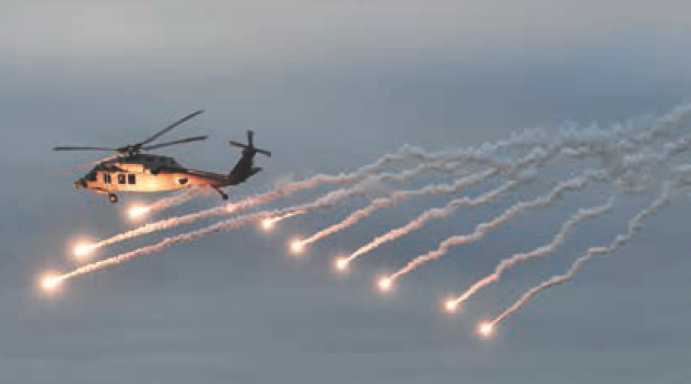
ALQ-214 Integrated Defensive Electronic Countermeasures (IDECM)
Description
The IDECM system is employed on the F/A-18 series Hornet/ Super Hornets to defend against radar-guided surface-to-air and air-to-air missile systems. Through either a towed decoy or onboard transmitters, the ALQ-214 produces complex waveform radar jamming that defeats advanced threat systems.
Status
IDECM has been developed in three phases: (1) ALQ-165 On Board Jammer and ALE-50 towed decoy (initial operational capability, IOC, in FY 2002); (2) ALQ-214 On-Board Jammer and ALE-50 towed decoy (IOC FY 2004); and (3) ALQ-214 On Board Jammer and ALE-55 Fiber-Optic Towed Decoy (IOC FY 2011). The ALE-55 Fiber-Optic Towed Decoy replaces the ALE-50 towed decoy. IDECM is entering a fourth phase with development of the production Block 4 ALQ-214 On-Board Jammer for the F/A-18C/D/E/F Hornet/Super Hornet aircraft and is in full-rate production. The software improvement program will achieve IOC in FY 2017.
Developers
BAE Systems Nashua, New Hampshire
Excelis, Inc. Clifton, New Jersey
* * * * * * * * * * * *
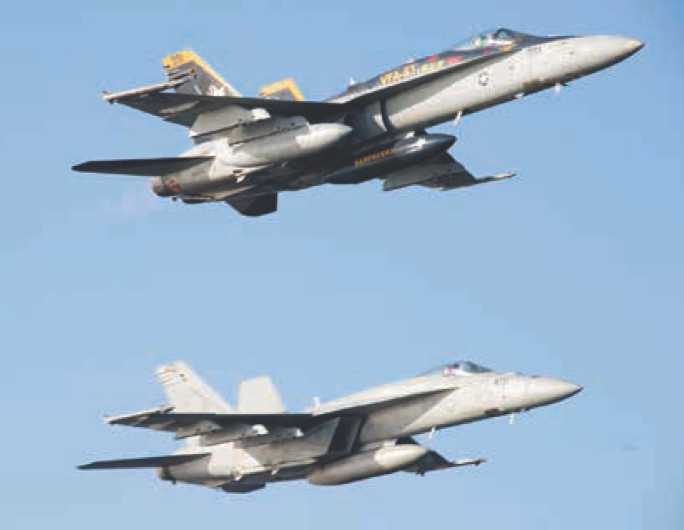
ALR-67(V)3 Advanced Special Receiver (RWR)
Description
The ALR-67(V)3 will meet Navy requirements through the year 2020. It enables the Navy Hornet/Super Hornet family of aircraft to detect threat radar emissions, enhancing aircrew situational awareness and aircraft survivability.
Status
The ALR-67(V)3 program successfully completed the engineering and manufacturing development phase and operational testing in 1999 and entered full-rate production in FY 2013. Production quantities will eventually outfit all F/A-18 Hornet/Super Hornet aircraft.
Developers
Arete Associates Tucson, Arizona
Raytheon Goleta, California
* * * * * * * * * * * *

APG-79 Active Electronically Scanned Array (AESA) Radar System
Description
The APG-79 AESA Phase I upgrade provides multi-mode function flexibility while enhancing performance in the air-to-air arena (including cruise missile defense) as well as the air-to-ground arena. The Phase II upgrade provides enhanced performance in hostile electronic countermeasure environments and provides significant electronic warfare improvements. Growth provisions will allow for future reconnaissance capability through the use of synthetic aperture radar technology and improved hardware and software. The APG-79 AESA radar is installed on Block II F/A-18E/F Super Hornet and all EA-18G Growler aircraft.
Status
The APG-79 completed subcontractor competition in November 1999; the Navy awarded the engineering and manufacturing development contract in February 2001; and the radar achieved initial operational capability in 2007. AESA Milestone C and flow-rate initial production approvals were received in January 2004 for initial delivery with Lot 27 Super Hornets in FY 2005. Full-rate production was achieved in June 2007 following completion of the initial operational test and evaluation in December 2006. The first deployment of the AESA system was with the VFA-22 "Fighting Redcocks" in 2008. Retrofit installations into Block II Lot 26-29 F/A-18E/Fs began in 2013. All Block II F/A-18E/F and EA-18G aircraft will be equipped with the APG-79 AESA radar by 2019.
Developers
The Boeing Company St. Louis, Missouri
Raytheon El Segundo, California
* * * * * * * * * * * *
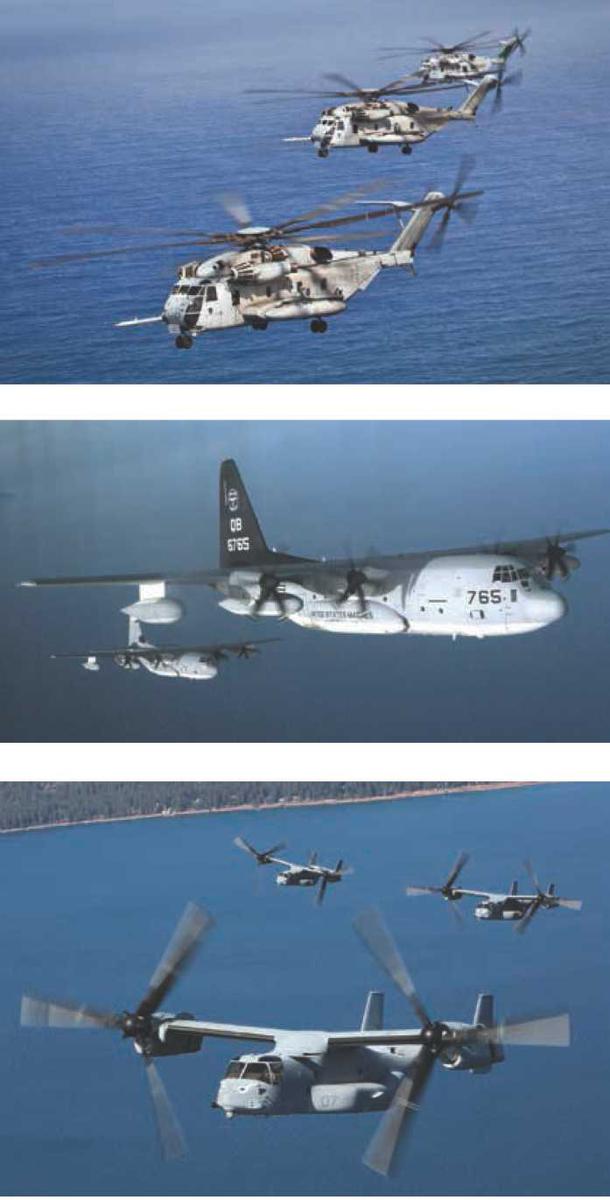
AAQ-24 Department of the Navy Large Aircraft Infrared Countermeasures (DoN LAIRCM) System
Description
The AAQ-24(V)25, DoN LAIRCM System is an ACAT II Special Interest program. The system consists of advanced, two-color infrared (IR) missile warning that cues an inexhaustible laser countermeasure and ALE-47 expendables to defeat shoulder-launched missiles. The current IR missile warning sensors are being retrofitted to provide advanced threat warner (ATW) capability. ATW sensors will improve missile-warning performance and will provide laser warning (LW), and hostile fire indication (HFI), as well as threat point of origin for better situational awareness. ATW will improve countermeasures accuracy and enable tactical responses to surface to air threats including small arms, anti-aircraft artillery, rocket propelled grenades and laser-guided weaponry. The DoN LAIRCM and ATW configuration includes four major components: (1) IR MWS sensors; (2) a dedicated processor; (3) a control indicator unit for cockpit display; and (4) Guardian laser turret assembly that consists of a four-axis stabilized gimbaled system, a fine-track sensor, and a Viper TM laser.
The system is deployed on Marine Corps CH-53E Super Stallion helicopters. The CH-53E systems are being upgraded to the ATW configuration, and ATW is also being installed on the MV-22 and KC-130J aircraft, and will be installed on the CH-53K in the future. The Naval Air Systems Command (NAVAIR) began DoN LAIRCM integration on CH-53Es in 2009 and Navy C-40 Clipper and Marine Corps KC-130J Hercules aircraft in FY 2012.
A Marine Corps urgent universal need statement signed in April 2014 directed NAVAIR to install DoN LAIRCM/ATW on 24 Special-Purpose Marine Air-Ground Task Force MV-22 Ospreys. The ATW follow-on test and evaluation (FOT&E) was called out of test in July 2015, and ATW retrofit and initial installation kits were fielded based on the operational test (OT) report. ATW sensor retrofit will initially be fielded on MV-22 in the second quarter FY 2017 based on a Quick Reaction Assessment. During this same period KC-130J completed Non-Recurring Engineering to integrate DoN LAIRCM. KC-130J testing and fielding was planned for the first quarter FY 2017. The CH-53K baseline DECM configuration includes DoN LAIRCM with OT planned in the first quarter FY 2019. Upon completion of OT testing, the CH-53K will be upgraded to the ATW configuration to meet emergent threats.
The DoN LAIRCM program Office provided government-furnished equipment to the P-8A Poseidon program to support a 2015 urgent operational need.
Status
DoN LAIRCM initial operational capability was achieved in May 2009, and a full-rate production decision was approved in January 2010. Advanced threat warning operational test and evaluation began in FY 2013, and finished FOT&E in FY 2015. Delivery began in FY 2016. The DoN LAIRCM Program Office works closely with its counterpart the Air Force LAIRCM program to leverage contracts, test and evaluation, and sustainment efforts, and is working closely with the Army to provide support during the transition to a new missile warning system.
Developers
Northrop Grumman Rolling Meadows, Illinois
* * * * * * * * * * * *

ASQ-228 Advanced Targeting Forward-Looking Infra-Red (ATFLIR) Sensor
Description
The ATFLIR provides the F/A-18A+/C/E/F Hornet and Super Hornet aircraft with a significantly enhanced capability to detect, track, and attack air and ground targets, compared to the legacy AAS-38/46 NITEHAWK Targeting Forward-Looking Infrared (FLIR) system. Laser-guided and global positioning system standoff weapons systems and higher-altitude attack profiles require improved performance. The ATFLIR provides a significant improvement in operational effectiveness to support precision-strike mission requirements. Improved reliability and maintainability increase operational availability while reducing total ownership costs. The ATFLIR consists of a mid-wave FLIR and electro-optical sensor, laser spot tracker, and a tactical laser for designation and ranging. Improvements to the ATFLIR include the addition of an infrared marker, ROVER data link, and moving-target track improvements.
Status
ATFLIR completed Phase I operational test and evaluation in September 2003 and was determined to be operationally suitable and effective; it was recommended for further fleet introduction and achieved initial operational capability in September 2003. It has demonstrated its combat capability during Operations Iraqi Freedom and Enduring Freedom. The ATFLIR production contract is complete with a total procurement of 410 pods.
Developers
The Boeing Company St. Louis, Missouri
Raytheon El Segundo, California
* * * * * * * * * * * *
Joint Mission Planning Systems (JMPS)
Description
The Joint Mission Planning System is the core of the Naval Mission Planning Systems (NavMPS) portfolio. JMPS enables weapon system employment by providing the information, automated tools, and decision aids needed to plan missions; to load mission data into aircraft, weapons, sensors, and avionics systems; and to conduct post-mission analysis. Navy and Marine Corps aircrews use JMPS for mission planning at different classification levels for a variety of Navy/Marine Corps aviation platforms and air-launched weapons. JMPS software is fielded to the Fleet as a platform-tailored mission planning environment (MPE) that combines a common JMPS framework with NavMPS applications (e.g., WASP and TOPSCENE) and components that support platform-specific capabilities and tactical missions. JMPS replaced and improved upon legacy MPS capabilities, increasing commonality among platforms, and integrating new technologies to support evolving platform capabilities and interoperability requirements.
Status
JMPS is fielded directly to squadrons and supports approximately 40 aircraft type/model series. These include: (1) all F/A-18 Hornet/Super Hornet variants, EA-18G Growler, EA-6B Prowler, AV-8B Harrier LL, MV-22B Osprey, C-2A Greyhound, E-2C/D Hawkeye, P-3C Orion, and EP-3E ARLES LL: (2) Navy and Marine Corps helicopters—MH-53E Sea Dragon and MH-60R/S Seahawk, AH-1W/Z Super Cobra, UH-1Y Venom, CH-53E Super Stallion,VH-3D Sea King and VH-60N WhiteHawk presidential helicopters; and (3) Naval Aviation training aircraft. Future JMPS platforms include the CH-53K King Stallion helicopter and MQ-4C Triton unmanned aerial system.
In 2006 JMPS was designated the single MPS for Naval Aviation, replacing legacy, platform-unique MPS. In 2014 JMPS began fielding platform-tailored MPEs upgraded with a new JMPS framework and Windows 7 operating system (OS). JMPS will transition MPEs to Windows 10 OS in compliance with Department of Defense cybersecurity mandates. JMPS is also transitioning from a 32-bit to a 64-bit architecture that increases memory and processing capabilities to meet fleet requirements. The JMPS program is fielding mobile "electronic kneeboard" devices to support aircrew planning and execution of flight requirements in support of "paperless cockpit" initiatives.
Developers
DCS Corporation Lexington Park, Maryland
Lockheed Martin Marlton, New Jersey
Northrop Grumman San Pedro, California
* * * * * * * * * * * *
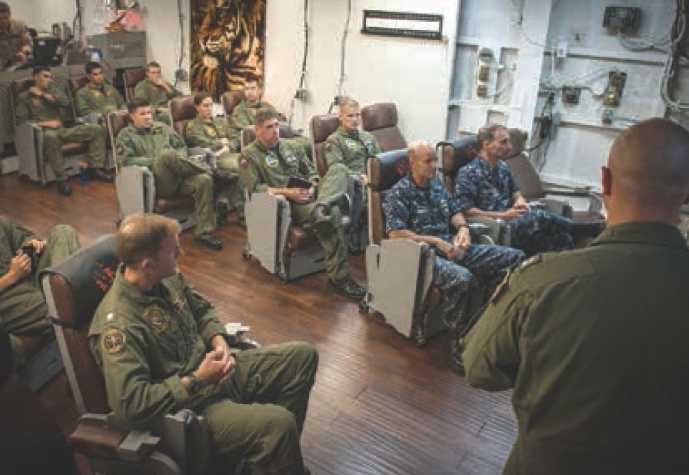

"Distributed Lethality" means that the Navy's Surface Forces are the world's premier multi-domain naval warfighting force. Multi-mission guided-missile cruisers and destroyers, coupled with our smaller littoral combat ships and next-generation frigates, are crucial to deterring and defeating threats through all-domain access, power projection, air and missile defense, precision strike, and maritime security and sea control. Through forward-deployed operations augmented by surface warship homeports in Japan and Spain, the Surface Force maximizes its access to vital world regions in support of the Nation's interests as well as protecting the global maritime commons to safeguard world commerce.
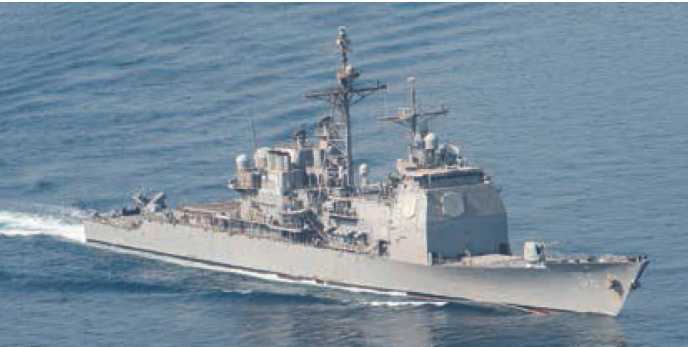
SURFACE WARSHIPS
CG 47 Ticonderoga-Class Aegis Guided-Missile Cruiser Modernization
Description
Ticonderoga-class guided-missile cruisers (CGs) provide multi-mission offensive and defensive capabilities and can operate independently or as part of aircraft carrier strike groups and surface action groups in global operations. Ticonderoga-class cruisers have a combat system centered on the Aegis Weapon System and the SPY-1B/(B)V multi-function, phased-array radar. The combat system includes the Mk 41 vertical launching system that employs Standard Missile surface-to-air missiles, Tomahawk land-attack cruise missiles, advanced undersea and surface warfare systems, embarked sea-control helicopters, and robust command, control, and communications systems in a potent, multi-mission warship.
The oldest 11 cruisers have been extensively modernized, including hull, mechanical, and electrical (HM&E) upgrades as well as improved quality of life, mission-life extension, integrated ship's control, all-electric auxiliaries, and weight and moment modifications. Combat systems upgrades include an open-architecture computing environment. Specific improvements to Cooperative Engagement Capability and SPY radar, maritime force-protection with the Mk 15 Close-In Weapon System Block 1B, Evolved Seasparrow Missile, Nulka decoy, and SPQ-9B radar, and the SQQ-89A(V)15 anti-submarine warfare suite address capability upgrades. Open architecture cruiser modernization warfighting improvements will extend the Aegis Weapon System's capabilities against projected threats well into the 21st Century.
The Navy has commenced a modernization plan of the Fleet's 11 newest cruisers, which will update the ships' combat systems and HM&E systems. This updated modernization plan provides the added benefit of extending the service lives of these ships from 35 to 40 years, ensuring a minimum of 11 relevant and capable purpose-built air defense-commander platforms for carrier strike groups into the mid-2030s.
Status
Combat systems modernization commenced in FY 2008 with the USS Bunker Hill (CG 52). Seven ships have completed Advanced Capability Build (ACB) 08 combat systems modernization, and three have completed ACB-12 combat systems modernization. Aegis CGs 52-62 have completed extensive HM&E upgrades, and in 2015 the USS Gettysburg (CG 64) and USS Cowpens (CG 63) were inducted into phased modernization. The USS Chosin (CG 65) and USS Vicksburg (CG 69) were inducted into phased modernization in 2016.
Developers
Huntington Ingalls Industries,
Ingalls Shipbuilding Pascagoula, Mississippi
Lockheed Martin Moorestown, New Jersey
* * * * * * * * * * * *
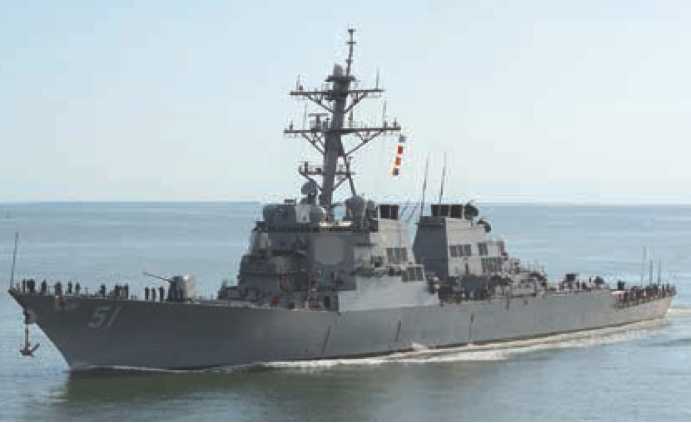
DDG 51 Arleigh Burke-Class Aegis Guided-Missile Destroyer
Description
Arleigh Burke-class guided-missile destroyer combat system is centered on the Aegis Weapon System and the SPY-1D(V) multifunction, phased-array radar. The combat system includes the Mk 41 vertical launching system, an advanced anti-submarine warfare system, advanced anti-air warfare missiles, and Tomahawk land-attack cruise missiles. Incorporating all-steel construction and gas-turbine propulsion, DDG 51 destroyers provide multi-mission offensive and defensive capability, operating independently or as part of an aircraft carrier strike group or surface action group. Flight IIA variants incorporate facilities to support two embarked helicopters, significantly enhancing the ship's sea-control capability. A Flight III variant, which will incorporate the advanced Air and Missile Defense Radar (AMDR) SPY-6(V), is in development. Studies are ongoing to identify additional technology insertions to improve capability in other warfare area missions for Flight III.
Status
Following completion of the original DDG 51 acquisition program, the line was restarted in FY 2010 to continue production of this highly capable platform. Contracts for four Flight IIA ships were awarded from FY 2010 through FY 2012. The first of the "restart" Flight IIA ships, John Finn (DDG 113), successfully completed builder's trials in August 2016. DDG 113 is fitted with the Aegis Weapon System Baseline 9, which enables the ship to simultaneously track and target ballistic missiles and traditional air warfare threats. In June 2013, the Navy awarded a multi-year contract for Flight IIA DDG 51s in FY 2013 through FY 2017. In June 2014, the Navy modified these contracts reflecting engineering change proposals to the Flight III configuration starting with the second ship procured in FY 2016. The Flight III configuration will include the SPY-6(V) next-generation integrated air and missile defense radar, power and cooling enhancements to support SPY-6(V), and additional technology insertions to improve capability and life cycle costs in other warfare area missions. Initial operational capability is scheduled for FY 2023 after delivery of the first ship in FY 2021.
Developers
General Dynamics Bath Iron Works Bath, Maine
Huntington Ingalls Industries, Ingalls Shipbuilding Pascagoula, Mississippi
Lockheed Martin Moorestown, New Jersey
* * * * * * * * * * * *
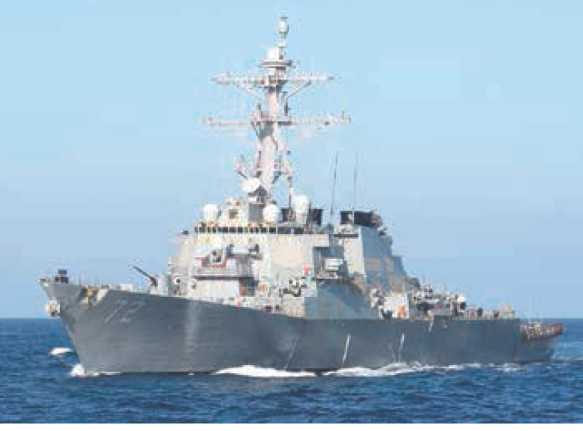
DDG 51 Arleigh Burke-Class Aegis Guided-Missile Destroyer Modernization
Description
Arleigh Burke-class guided-missile destroyers commenced mid-life modernization in FY 2010 with DDGs 51 and 53. The program was originally accomplished in two phases. The first phase concentrated on hull, mechanical, and electrical (HM&E) systems and included new gigabit ethernet connectivity in the engineering plant, a digital video surveillance system, an integrated bridge system, an advanced galley, and other habitability and manpower-reduction modifications. A complete open-architecture computing environment is the foundation for warfighting improvements in the second phase of the modernization for each ship. The upgrade plan consists of an improved multi-mission signal processor, which integrates air and ballistic missile defense capabilities, and enhancements improving radar performance in the littoral regions. Upon the completion of the modernization program, the ships will have the following weapons and sensors: Cooperative Engagement Capability; Evolved Seasparrow Missile; Mk 15 Close-In Weapon System Block 1B; Surface Electronic Warfare Improvement Program; and Nulka decoys. The Mk 41 vertical launching system is upgraded to support SM-3 and newer variants of the Standard Missile family. These two phases are accomplished on each ship approximately two years apart. Modernized DDG 51-class guided-missile destroyers will continue to provide multi-mission offensive and defensive capabilities with the added benefit of sea-based ballistic missile defense (BMD).
Status
The HM&E modernization modifications have been designed into the most recent new-construction Arleigh Burke-class destroyers. Incorporating modernization design in new construction optimizes risk reduction and proof of alteration in the builder's yard, reducing overall risk in the modernization program. Six Flight I DDGs have completed the Advanced Capability Build (ACB-12/ BMD 5.0) process of providing software upgrades for combat systems modernization. DDG modernization initially concentrates on the Flight I and II ships (DDGs 51-78), but is intended as a modernization program for the entire class. The Flight IIA modernization as a single combined HM&E and combat system modernization is scheduled to begin in FY 2017.
Developers
General Dynamics Bath Iron Works Bath, Maine
Lockheed Martin Moorestown, New Jersey
* * * * * * * * * * * *
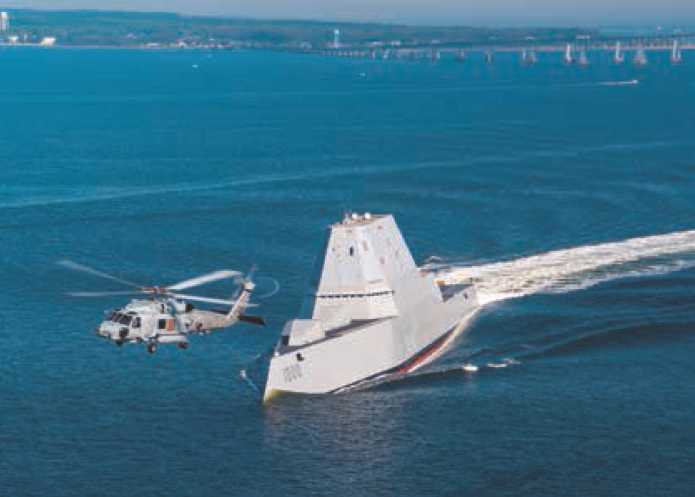
DDG 1000 Zumwalt-Class 21st Century Destroyer
Description
The Zumwalt-class guided-missile destroyer is an optimally crewed, multi-mission surface combatant tailored for land attack and littoral control. This advanced warship will provide offensive, distributed, and precision fires in support of forces ashore and a credible forward naval presence while operating independently or as an integral part of naval, joint or combined strike forces. To ensure effective operations in the littoral, it will incorporate signature reduction, active and passive self-defense systems, and enhanced survivability features. It will field an undersea warfare suite capable of in-stride mine avoidance, as well as robust self-defense systems to defeat littoral submarine threats, anti-ship cruise missiles, and small boats. Additionally, it will provide valuable lessons in advanced technology, such as the integrated power system and advanced survivability features, which can be incorporated into other ship classes.
Status
Zumwalt (DDG 1000) fabrication commenced in February 2009, and the ship delivered in May 2016. Expected to reach initial operational capability in FY 2020, Zumwalt was christened in FY 2014 and commissioned in Baltimore, Maryland, on October 15, 2016. Michael Monsoor (DDG 1001) fabrication commenced in February 2010, and the ship is scheduled to deliver in FY 2017. Fabrication of Lyndon B. Johnson (DDG 1002) commenced in April 2012, and the ship is scheduled to deliver in FY 2019. General Dynamics Bath Iron Works is building the three-ship Zumwalt class, with Huntington Ingalls Industries manufacturing the composite superstructure for DDG 1000 and 1001.
Developers
BAE Systems Minneapolis, Minnesota
General Dynamics Bath Iron Works Bath, Maine Huntington Ingalls Industries,
Ingalls Shipbuilding Pascagoula, Mississippi
Raytheon Systems, Inc. Sudbury, Massachusetts
* * * * * * * * * * * *
Frigate (FF) Description
The next-generation frigate (FF) will be a modified littoral combat ship (LCS) with enhanced lethality and survivability. It will be a multi-mission reconfigurable ship with the simultaneous ability to support surface warfare (SUW) and anti-submarine warfare (ASW) missions. The addition of over-the-horizon missiles will add significant combat capability to support the Navy's distributed lethality concept and blue water operations with larger task forces and high-value units. The FF will provide excellent escort and screening capabilities, with an improved 3-D radar and upgraded electronic warfare suite, providing flexibility in the employment of larger surface combatants while lowering the overall warfighting risk. Its ability to operate in the littorals and "blue water" addresses warfighting capability gaps against asymmetric anti-access threats and thus play a vital role in American maritime security.
The contract award and down-select to either the Freedom or Independence variant FF is planned for FY 2019, but may be as early as FY 2018, with initial operational capability scheduled for 2023. Regardless of the variant chosen, COMBATSS-21 (an Aegis Weapon System derivative) will be the combat management system. This will leverage synergies with other surface warships that use the Aegis combat system and ensure the FF can support the range of naval operations with larger combatants through all phases of conflict. Due to similar maintenance, training requirements, and rotational crewing processes as LCS, FF will fold into the preexisting logistical infrastructure, training support programs, and facilities. Taking advantage of the previous institution of processes and systems for the LCS will enable the FF to quickly contribute to the small surface combatant operational demand, meeting the validated fleet requirements for small surface combatants.
Status
In February of 2014, the Secretary of Defense Chuck Hagel directed Navy to submit proposals for a more lethal and capable small surface combatant to follow LCS 1 through 32. A Small Surface Combatant Task Force (SSCTF) subsequently analyzed and evaluated potential alternatives to LCS. In December 2014, the SSCTF presented its findings to the Defense Secretary, who concurred with the Navy's recommendation to pursue a small surface combatant design based on a modified LCS. The following January, Secretary of the Navy Ray Mabus announced the modified LCS would be called Frigate to emphasize the enhanced lethality, survivability, and multi-mission capability FF would offer to the warfighter. In December 2015, Secretary of Defense Ash Carter directed the Navy to reduce the small surface combatant program of record from 52 to 40 ships for budgetary reasons. In accordance with this direction, Navy has truncated the LCS/FF program to 28 LCS and 12 FF. The last LCS keel will begin construction in 2017, with FF construction beginning as early as 2018 but not later than 2019.
Developers
To be determined.
* * * * * * * * * * * *
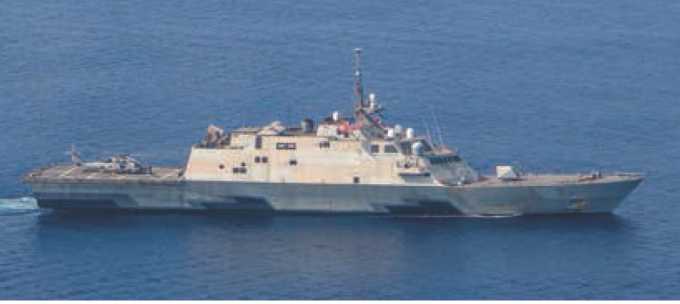
Littoral Combat Ship (LCS)
Description
The Littoral Combat Ship is a modular, reconfigurable ship designed to meet validated fleet requirements in the littoral region. The LCS addresses warfighting capability gaps against asymmetric anti-access threats and is already playing an important role in American maritime security; it will eventually compose a significant portion of the Navy's future surface combatant fleet. Through its innovative modular design, each LCS can be configured for surface warfare (SUW), anti-submarine warfare (ASW), or mine countermeasures (MCM) missions. This versatility enables the Navy to provide warfighters with the most capable, cost-effective solution to counter threats from the littoral regions to the open ocean.

There are two variants of LCS, the Freedom variant (all odd-numbered ships) and Independence variant (all even-numbered ships). The Freedom variant is a steel semi-planing monohull with an aluminum superstructure, constructed by Lockheed Martin in Fincantieri Marinette Marine's shipyard in Marinette, Wisconsin. The Independence variant is an all-aluminum, stabilized mono-hull (trimaran) constructed by Austal USA (formerly teamed with General Dynamics) in Mobile, Alabama. Both ship variants have an open-architecture design and embark one of three interchangeable mission packages to execute SUW, ASW, or MCM missions, as well as having the organic capability to conduct numerous secondary missions. The LCS modular architecture will also enable the rapid upgrade of weapon systems and sensors without requiring expensive and time-consuming shipyard periods. The ships operate on a rotational crewing concept which will provide more than twice the on-station time compared to other, single-crewed ships, resulting in a significant cost savings to the Navy and continuous presence in important world regions. By 2030, six out of every ten U.S. Navy warships deployed worldwide will be LCS ships due to this unique crewing concept. The Navy is also aggressively pursuing forward-/back-it LCS lethality and survivability upgrades to support LCS ability to fold seamlessly into the surface Navy's distributed lethality concept.
Status
The LCS program began in February 2002, and in May 2004 the Navy awarded two contract options to Lockheed Martin and General Dynamics/Austal USA to build the first research-and-development variants. Through highly effective competition between industry bidders in 2010, the LCS program achieved significant cost savings with a fixed-price dual-block buy of 20 LCS (ten of each variant) through FY 2015. By the spring 2017, the Navy had 26 LCS (13 of each variant) at sea, under construction, or under contract. As of early 2017, LCSs 1-8 have been commissioned. LCSs 9-26 will be delivered to the Navy by the end of 2020. In November 2014, the USS Fort Worth (LCS 3) commenced a 16-month deployment to Singapore, beginning continuous LCS presence in the Western Pacific and the implementation of the rotational crewing concept. During the first 14 months of her deployment, she participated in a search and rescue effort for Air Asia flight QZ8501, made 12 port visits, and participated in ten bilateral and multi-lateral exercises across the Indo-Asia-Pacific region. Prior to her scheduled maiden deployment, the Navy upgraded the USS Coronado with a Harpoon SUW missile system and conducted a successful structural test firing during the "Rim of the Pacific" 2016 multilateral naval exercise. She is now equipped with a fully functional and certified missile system for the 2016-2017 Southeast Asia deployment. The USS Jackson (LCS 6) completed shock trials for the Independence variant during the summer 2016, validating and frequently exceeding survivability expectations; the USS Milwaukee (LCS 5) completed shock trials for the Freedom variant in the fall 2016. The long-term testing and deployment schedule is under review by the Fleet following improvements to the rotational construct to improve deployed presence, maintenance execution, and crew ownership.
Developers
Austal USA Mobile, Alabama
Lockheed Martin and Marinette Marine Marinette, Wisconsin
* * * * * * * * * * * *
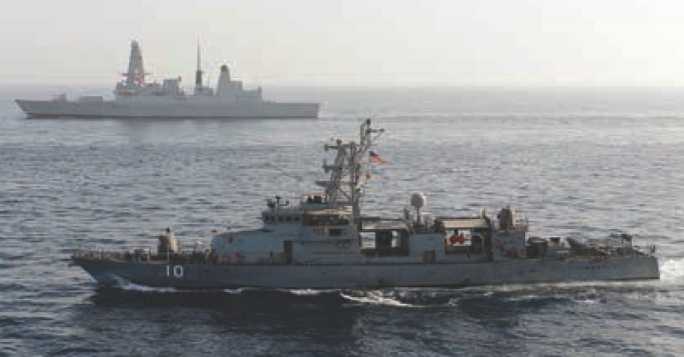
PC 1 Cyclone-Class Patrol Coastal Modernization Program
Description
The Cyclone-class Patrol Coastal ships are essential for conducting theater security cooperation tasks, maritime security operations, and intelligence, surveillance, and reconnaissance missions. The PCs are uniquely suited to operating with maritime partner navies and coastguards, particularly in the green-water/brown-water "seam." Fourteen Cyclone-class ships were built, 13 are operating in the Navy in late 2016, and one was transferred to the Philippine navy in 2004. The PC Modernization improvements correct the most significant maintenance and obsolescence issues and will extend the life of the class by 15 years, to a 30-year expected service life. The program supports significant alterations, such as a main propulsion diesel engine pool and upgrading diesel generators and reverse-osmosis units. Additional hull, mechanical, and electrical modifications and updates to the weapons systems and C4ISR (command, control, communications, computers, intelligence, surveillance, and reconnaissance) suite are also included. As part of the Navy's counter-swarm strategy, for example, a 7.62mm coaxial mount Gatling gun is integrated into the forward and aft Mk 38 Mod 2 25mm electro-optical/infrared machine gun system to augment the PC's surface warfare capabilities for layered self-defense. In addition to the Mk 38 Mod 2 upgrade, the Mk 60 Griffin missile system installation is planned for all ten PCs deployed to Bahrain.
Status
The 13-ship Cyclone-class modernization program commenced in FY 2008 and is scheduled for completion by FY 2017. Ten PCs are forward deployed to Bahrain; the remaining three PCs are home-ported in Mayport, Florida. The forward and aft Mk 38 Mod 2 upgrade and Mk 60 Griffin missile system installation have been completed on all ten Bahrain-homeported PCs.
Developers
Bollinger Shipyards Lockport, Louisiana
* * * * * * * * * * * *
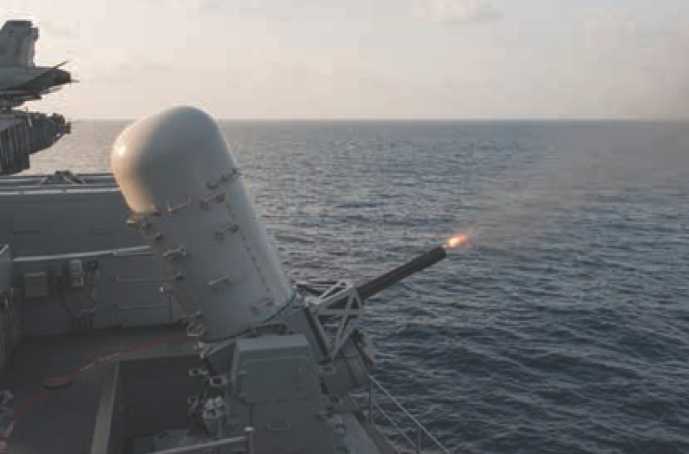
SURFACE WEAPONS
Mk 15 Phalanx Close-In Weapon System (CIWS)
Description
The Mk 15 Mod 21-28 Phalanx Close-In Weapon System is an autonomous combat system that searches, detects, tracks (radar and electro-optic), and engages threats with a 20mm Gatling gun capable of firing 4,500 tungsten penetrator rounds per minute. Integral to ship self-defense and the anti-air warfare defense-in-depth concept, CIWS provides terminal defense against anti-ship missiles and high-speed aircraft penetrating other fleet defenses. Phalanx CIWS can operate autonomously or be integrated with a ship's combat system. The Block 1B configuration provides expanded defense against asymmetric threats such as small, fast surface craft, slow-lying aircraft, and unmanned aerial vehicles through the addition of an integrated forward-looking infrared system. Block 1B also incorporates an optimized gun barrel (OGB) for tighter ordnance dispersion. Enhanced-lethality cartridges can be used with the OGB for improved target penetration. Mk 15 Mod 31 is the SeaRAM system. SeaRAM is based on the Block 1B Phalanx configuration, with the gun subsystem replaced by an 11-round Rolling Airframe Missile (RAM) launcher, capable of firing RAM Block 1 or Block 2 missiles. SeaRAM can be integrated with a ships' combat system or operate autonomously.
Status
More than 250 Mk 15 Phalanx CIWS systems are deployed in the Navy. CIWS Block 1B is installed on all CVNs (three mounts), LHDs (three mounts), LHAs (three mounts), LSDs (two mounts), DDGs (one or two mounts), and CGs (two mounts). By the end of 2019, a fleet-wide upgrade of Phalanx radar systems to Baseline 2 configuration will be complete. SeaRAM systems are employed on the four forward-deployed guided-missile destroyers homeported in Rota, Spain, and also on the Independence (LCS 2) variant littoral combat ship. It is scheduled for the new-construction Freedom-variant LCSs.
The Army procured 45 Land-based Phalanx Weapon System (LPWS) units, with one system since retired from service. Approximately half of the LPWS units are deployed at forward operating bases in theater and the other half are continental U.S.-based, primarily for use in training. LPWS has executed more than 275 successful defensive combat engagements in Iraq and Afghanistan operations.
Developers
Raytheon (Engineering) Tucson, Arizona
Raytheon (Production/Depot) Louisville, Kentucky
* * * * * * * * * * * *
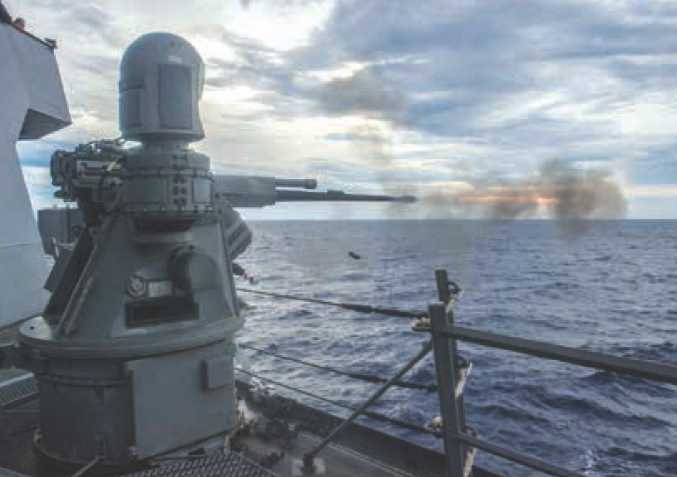
Mk 38 Mod 2 Stabilized 25mm Chain Gun
Description
The Mod 2 program upgrades the Mk 38 Mod 1 25mm chain gun by adding stabilization, remote operation, fire control, and an electro-optical sensor. These additions significantly expand the effective range, lethality, and nighttime capability of the weapon. The program reduces risk for surface ship self-defense by engaging asymmetric threats to ships at close range. It provides the capability to bridge current and future targeting and weapons technology in a close-range force-protection environment, including protection in port, at anchor, transiting choke points, or while operating in restricted waters.
Status
The Navy initiated the Mk 38 Mod 2 program in 2003 to improve ship self-defense against small-boat threats by developing and fielding a mid-term capability for surface ships that is simple, stabilized, and affordable. The Mk 38 Mod 2 program received an approval for initial operational capability in FY 2006. At the end of FY 2016, the program has fielded 257 systems, 64 percent of the planned total. The Mk 38 Mod 2 machine gun system is being installed on aircraft carriers, guided-missile cruisers and destroyers, amphibious warfare ships, patrol coastal ships, command ships, and riverine squadron patrol boats.
An ordnance alteration (ORDALT) has been developed to implement a 7.62mm coaxially mounted automatic gun. This ORDALT completed live-fire testing in late FY 2016 and will complete safety qualification in FY 2017. In addition, improvements to the Mk 38 Mod 2 have been implemented, including an enhanced electro-optical/infrared sensor with increased range and resolution for tracking and Identification to counter swarm fast-attack craft/fast in-shore-attack craft. Mk 38 Mod 3 is assigned for this improved configuration. The Mk 38 Mod 3 has completed environmental qualification and live-fire testing in late FY 2016 and will complete safety qualification in FY 2017.
Developers
BAE Louisville, Kentucky
Rafael USA, Inc. Haifa, Israel
* * * * * * * * * * * *
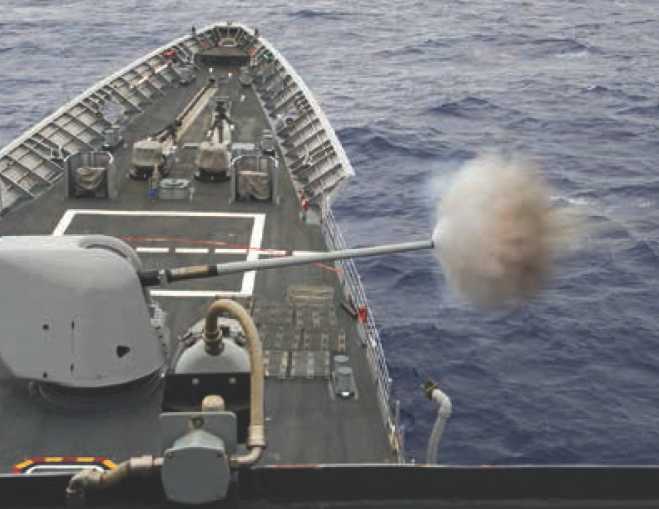
Mk 45 Mod 4 5-Inch/62-Caliber Gun System Upgrade
Description
The Mk 45 Mod 4 5-inch/62-caliber gun is a modification of the 5-inch/54-caliber gun with higher firing energies to support long-range munitions. The gun retains the functionality of the 5-inch guns, including ability to fire all existing 5-inch rounds. The modified design also improves maintenance procedures and provides enhanced anti-surface and anti-air warfare performance. Modifications include a longer (62-caliber) barrel, an ammunition recognition system, and a digital control system.
Status
The Mk 45 Mod 4 gun was added to the new-construction Arleigh Burke (DDG 51)-class destroyers, starting with the USS Winston S. Churchill (DDG 81).
Developers
BAE Systems Minneapolis, Minnesota
* * * * * * * * * * * *

Mk 46 Mod 2 Gun Weapon System (GWS)
Description
The Mk 46 Mod 2 is a 30mm GWS with a two-axis stabilized gun that can fire up to 200 rounds per minute. The system uses a forward-looking infrared sensor, a flow-light television camera, and laser range finder with a closed-loop tracking system to optimize accuracy against small, high-speed surface targets. Adapted from the Marine Corps expeditionary fighting vehicle gun, the Mk 46 Mod 2 GWS is an upgrade to the Mk 46 Mod 1 GWS. Both systems build upon commercial off-the-shelf /non-development items (COTS/NDI) technology using open-system architecture to allow for rapid and cost-effective use of COTS/NDI components and software.
Status
The Mk 46 Mod 2 GWS is being installed on the San Antonio (LPD 17)-class amphibious transport dock ships and the Zumwalt (DDG 1000)-class destroyers as well as the littoral combat ship surface warfare mission package.
Developers
General Dynamics Land Systems Sterling Heights, Michigan
* * * * * * * * * * * *
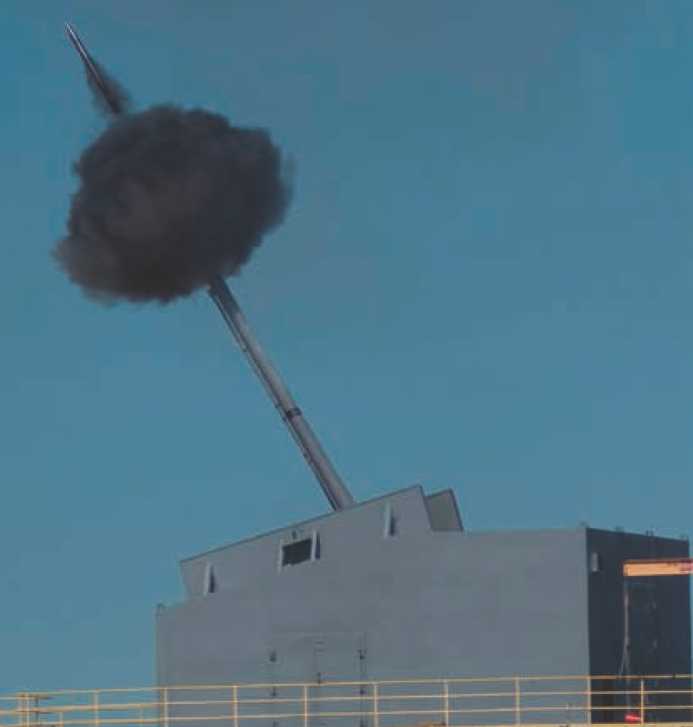
Mk 51 Gun Weapon System (GWS)
Description
The Mk 51 GWS is a 155mm (6-inch) advanced gun system (AGS) being installed in the three Zumwalt (DDG 1000)-class destroyers to provide precision, volume, and sustained fires in support of distributed joint and coalition forces ashore. The Mk 51 GWS is a fully integrated, automatic gun and magazine weapon system that will support the Zumwalt-class naval surface fire support mission. Each system will be capable of independently firing up to ten rounds per minute. The Mk 51 GWS was designed to meet DDG 1000 optimal manning and radar-signature requirements.
Status
Mk 51 manufacturing is underway at two facilities—Cordova, Alabama, and Louisville, Kentucky—and is meeting ship-production schedules. Mk 51 magazines and guns have been installed on DDG 1000, with follow-on mount/magazine fabrication and installation in progress or completed in DDG 1001 and 1002.
Developers
BAE Systems Minneapolis, Minnesota
* * * * * * * * * * * *
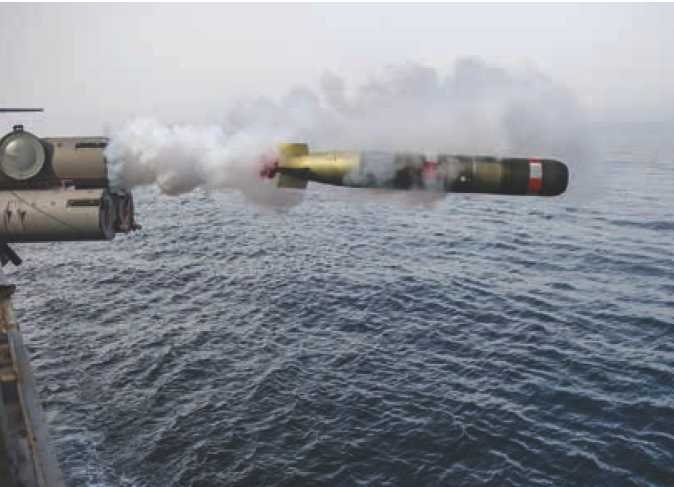
Mk 54 Lightweight Torpedo (LWT)
Description
The Mk 54 Lightweight Torpedo is a modular upgrade to the lightweight torpedo inventory and adds the capability to counter quiet diesel-electric submarines operating in the littoral. Mk 54 LWT combines existing torpedo hardware and software from Mk 46, Mk 50, and Mk 48 advanced capability programs, with advanced digital commercial off-the-shelf electronics. The resulting Mk 54 LWT offers significantly improved shallow-water capability at reduced life-cycle costs. The Mk 54 LWT modernization plan will introduce new hardware and software updates providing stepped increases in probability of kill, while reducing life-cycle cost and allowing the torpedo to remain ahead of the evolving littoral submarine threat. Mk 54 is also replacing the Mk 46 as the payload in the vertical-launch anti-submarine rocket.
Status
Mk 54 torpedoes are being delivered for fleet use to meet the total munitions requirement. FY 2020 will be the final year of Mk 54 Mod 0 production. Mk 54 Mod 1 has begun developmental testing, and operational testing begins in FY 2018. Initial operational capability for Mk 54 Mod 1 is planned for FY 2023.
Developers
Raytheon Mukilteo, Washington
* * * * * * * * * * * *
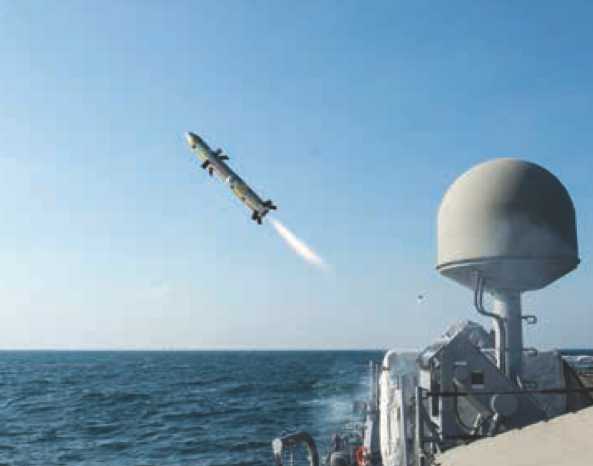
Mk 60 Griffin Missile System (GMS)
Description
The Griffin Missile System combines a lightweight laser and global positioning system/inertial navigation system in an integrated guided-missile system that has been adapted for use on forward-deployed Cyclone (PC 1)-class Patrol Coastal ships. The GMS was originally designed as an air-to-ground precision-engagement missile for U.S. Air Force MC-130 gunships. The Navy modified the GMS as a rapid deployment capability in support of fleet operational needs to improve small-vessel engagement capacity. The Griffin Block II is a 5.5-inch missile with a 13-pound blast-fragmentation warhead and semi-active laser seeker. The GMS uses the Brite Star II electro-optic infrared laser designator sensor ball mounted on the PC's mast to provide target Identification and illumination.
Status
At-sea testing completed in July 2013, and GMS proved capable against small-vessel threats. The first operational system was installed on the USS Monsoon (PC 4) in 2012, and the remaining nine installs were completed by the end of FY 2016.
Developers
Naval Surface Warfare Center Dahlgren, Virginia
Raytheon Tucson, Arizona
* * * * * * * * * * * *
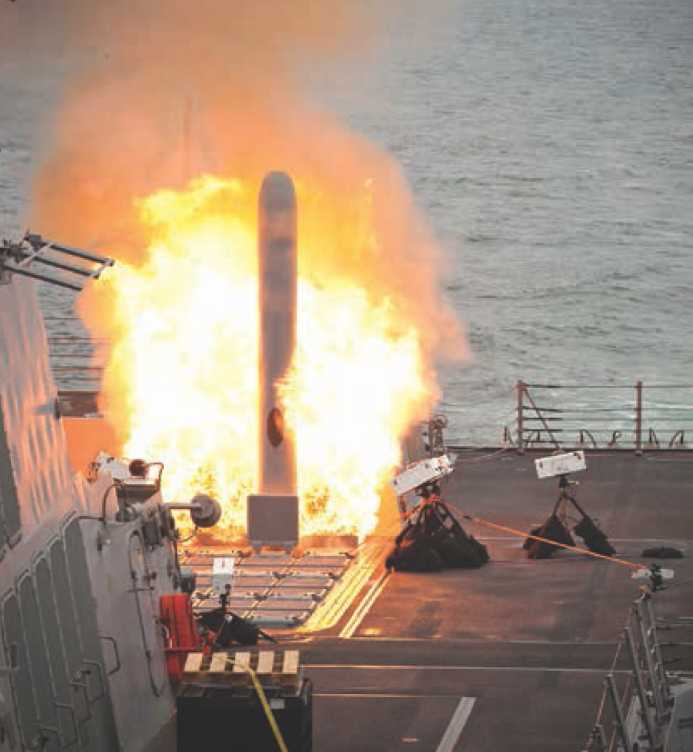
RGM/UGM-109E Tomahawk Land-Attack Missile (TLAM)
Description
Deployed on surface warships and attack- and guided-missile submarines, the Tomahawk land-attack missile is the Department of Defense's premier, all-weather, long-range, subsonic land-attack cruise missile. The Block IV Tactical Tomahawk (TACTOM, RGM-109E/UGM-109E) preserves Tomahawk's long-range precision-strike capability while significantly increasing responsiveness and flexibility. TACTOM improvements include in-light retargeting, the ability to loiter over the battlefield, and in-light missile health and status monitoring via a satellite data link. TACTOM also facilitates rapid mission planning and execution via global positioning system (GPS) onboard the launch platform and features an improved anti-jam GPS. A seeker variant is under development to add anti-surface warfare capability. Future payloads could include smart sub-munitions, a penetrator warhead, and a multiple-response warhead. Plans call for the Navy to procure more than 4,000 TACTOM weapons prior to program termination. TLAM Block III missiles will be retired from service by 2020.
Status
A full-rate production contract was signed in August 2004. It was Navy's first multi-year contract for TACTOM procurement of more than 1,500 missiles. This contract ended in FY 2008, and all missiles have been delivered. Tomahawk Block IV procurement in FY 2009 to FY 2016 was executed via firm, fixed-price contracts. The Navy will continue to procure TACTOM through FY 2017. A recertification and modernization program has been funded to start in FY 2019 to add an additional 15 years' service life to each missile in the TACTOM Block IV inventory.
Developers
Raytheon Missile Systems Tucson, Arizona
* * * * * * * * * * * *
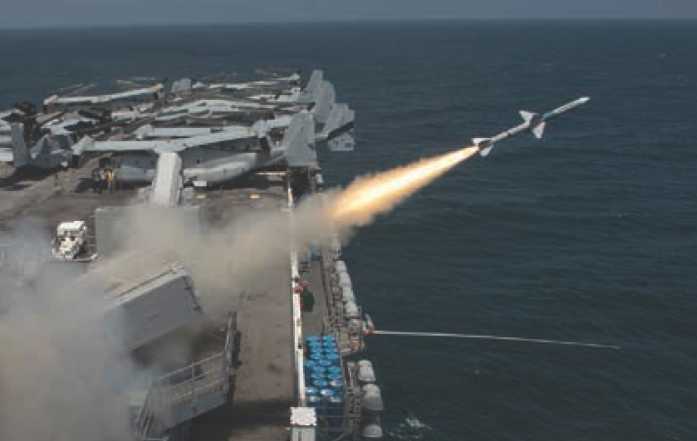
RIM-7, Mk 57 NATO Seasparrow Surface Missile System (NSSMS) and RIM-162 Evolved Seasparrow Missile (ESSM)
Description
The Mk 57 NATO Seasparrow Surface Missile System (NSSMS) and its associated RIM-7P Seasparrow Missile and the RIM-162 Evolved Seasparrow Missile (ESSM) serve as the Navy's primary surface-to-air ship self-defense missile system. NSSMS is deployed on aircraft carriers, surface warships, and landing helicopter dock amphibious assault ships, and is being installed on the newest class of landing helicopter assault ships. The Mk 57 Target Acquisition System (TAS) is a combined volume-search radar and control element that determines threat evaluation and weapon assignment.
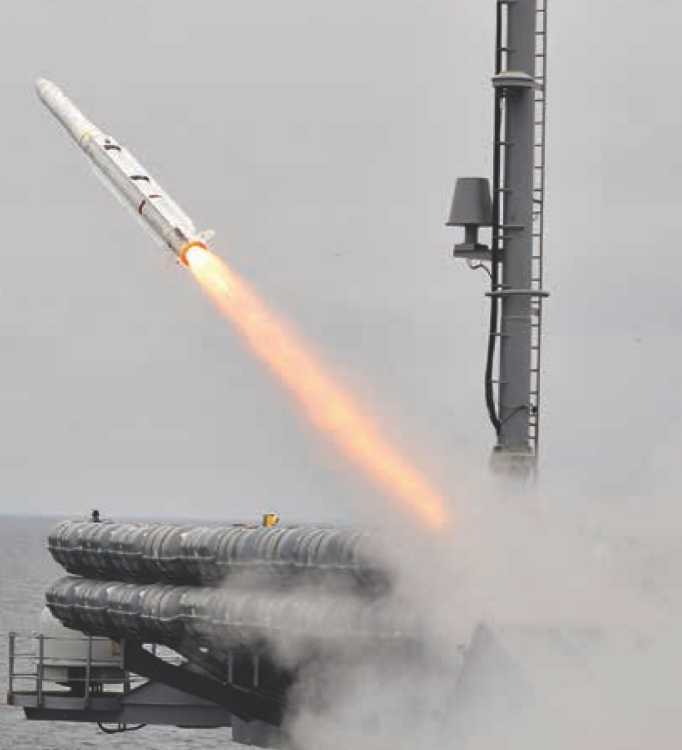
A kinematic upgrade to the RIM-7P missile, the ESSM Block 1 is the next-generation Seasparrow Missile that serves as a primary self-defense weapon on aircraft carriers and large-deck amphibious warships and provides layered-defense for Aegis cruisers and destroyers. ESSM Block 1 upgrades include a more powerful rocket motor, tail control section for quick response on vertical-launch system ships, upgraded warhead, and a quick-reaction electronic upgrade. Enhanced ESSM kinematics and warhead lethality leverage the robust RIM-7P guidance capability to provide increased operational effectiveness against high-speed, maneuvering, hardened anti-ship cruise missiles at greater intercept ranges than the
RIM-7P. Operational in FY 2004, ESSM Block 1 continues to be procured as part of the NATO Seasparrow Consortium involving ten NATO countries. To pace evolving threats, the next-generation ESSM Block 2 is being developed cooperatively by the consortium, replacing the missile guidance section with an active/semi-active dual-mode seeker.
Status
ESSM Block 1 is fielded on Ticonderoga (CG 47)-class guided-missile cruisers, Arleigh Burke (DDG 51)-class destroyers with Aegis Baselines 6.3 and higher, aircraft carriers (CVNs) and select amphibious ships (LHD 7-8, LHA 6). It will be deployed on the three Zumwalt (DDG 1000)-class destroyers, Wasp-class amphibious assault ships (LHDs 1-6), America class (LHA 7-8), and in-service Aegis cruisers and destroyers as well as new-construction destroyers. ESSM (Block 1 and Block 2) joint universal weapon link (JUWL) development is on schedule, and interrupted continuous wave illumination (ICWI) capability has already been incorporated. DDG 1000 and CVN 78 will require a unique variant of ESSM Block 1, incorporating both ICWI and JUWL. ESSM Block 2 development is in the engineering and manufacturing development phase. ESSM Block 2 achieved Milestone B in FY 2015 and will achieve initial operational capability in 2020 on Aegis ships and FY 2022 for non-Aegis ships.
Developers
Raytheon Tucson, Arizona
* * * * * * * * * * * *
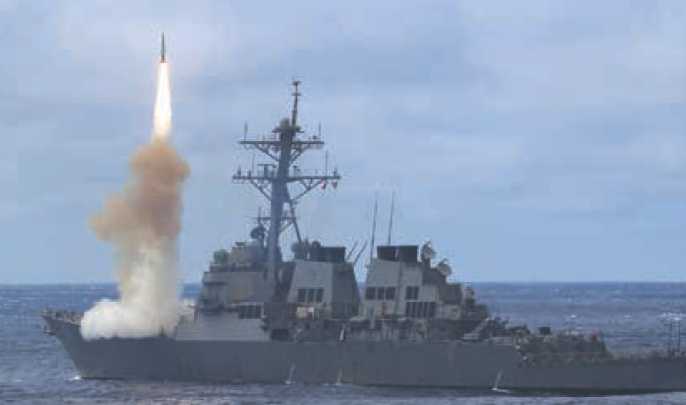
RIM-66C Standard Missile-2 Blocks III/IIIA/IIIB
Description
The RIM-66C Standard Missile 2 (SM-2) is the Navy's primary air-defense weapon. SM-2 Block III/IIIA/IIIB configurations are all-weather, ship-launched, medium-range, surface-to-air missiles in service with the Navy and 15 allied navies. SM-2 enables forward naval presence, littoral operations, and projecting and sustaining U.S. forces in anti-access and area-denied environments. SM-2 Block III/IIIA/IIIB missiles are launched from the Mk 41 vertical launching system installed in Aegis cruisers and destroyers. Block III features improved performance against flow-altitude threats and optimizes the trajectory-shaping within the Aegis command guidance system by implementing shaping and fuse altimeter improvements. Block IIIA features a new directional warhead and a moving-target-indicator fuse design for improved performance and lethality against sea-skimming threats. Block IIIB adds an infrared-guidance mode capability developed in the missile homing-improvement program to improve performance in a stressing electronic countermeasure environment. Blocks IIIA/IIIB will be the heart of the SM-2 inventory for the next 20 years. The latest generation of Block IIIB missiles includes a maneuverability upgrade (SM-2 Block IIIB w/MU2) to enhance weapon performance against flow-altitude, supersonic maneuvering threats.
Status
The Navy established a depot (FY 2013) and rocket motor regrain program (FY 2014) to maintain the inventory out to the 2030+ timeframe. This will allow the SM-2 inventory to keep pace with Navy's 30-year shipbuilding plan, keep infrastructure in place to convert SM-2 Block IIIA missiles to the unique interrupted continuous wave illumination/joint universal weapon link variant for the three Zumwalt (DDG 1000)-class warships, and support projected increases in fleet proficiency firings. In addition, to avoid significant hardware obsolescence impacts, a modification to SM-2 to incorporate SM-6 technology will result in a supportable missile with commonality benefits to the Standard Missile family. This effort will begin in FY 2017 and will result in increased SM-2 capability from the incorporation of this latest technology.
Developers
Raytheon Tucson, Arizona
* * * * * * * * * * * *
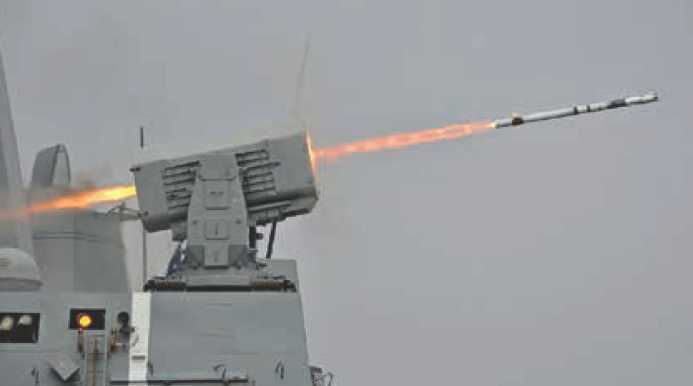
RIM-116A Rolling Airframe Missile (RAM)
Description
The Rolling Airframe Missile is a high rate-of-fire, flow-cost system, with the Block 0 configuration based on the AIM-9 Sidewinder, designed to engage anti-ship cruise missiles (ASCMs). RAM is a surface-to-air missile with passive dual-mode radio frequency/ infrared (RF/IR) guidance and an active-optical proximity and contact fuse. RAM has minimal shipboard control systems and is autonomous after launch. While effective against a wide spectrum of existing threats, RAM enhancements have been developed to improve and keep pace with emerging threats. RAM Block 1 IR upgrade incorporates IR all-the-way-homing to improve performance against evolving passive and active ASCMs. RAM Block 2, in flow-rate initial production (LRIP), provides increased kinematic capability against highly maneuvering threats and improved RF detection against flow probability of intercept threats. The RAM program is a cooperative development, production, and in-service program with Germany.
Status
RAM is installed in the Tarawa (LHA 1)- and Wasp (LHD 1)-class amphibious assault ships, Whidbey Island (LSD 41)- and Harpers Ferry (LSD 49)-class dock landing ships, aircraft carriers, and San Antonio (LPD 17)-class landing platform dock ships. RAM is also installed on the USS Freedom (LCS 1), the Lockheed Martin variant of the littoral combat ship. The Block 0 and Block 1 configurations have completed production with the Block 2 missile in the fifth year of flow-rate initial production. Block 2 achieved initial operational capability in May 2015 with a full-rate production decision planned for FY 2018. A RAM Block 2 capability enhancement commenced development in FY 2016 to improve system performance against a stream raid threat scenario with plans to deliver the new capability in two incremental phases (FY 2019 and FY 2021).
Developers
RAMSYS GmbH Ottobrunn, Germany
Raytheon Tucson, Arizona
* * * * * * * * * * * *
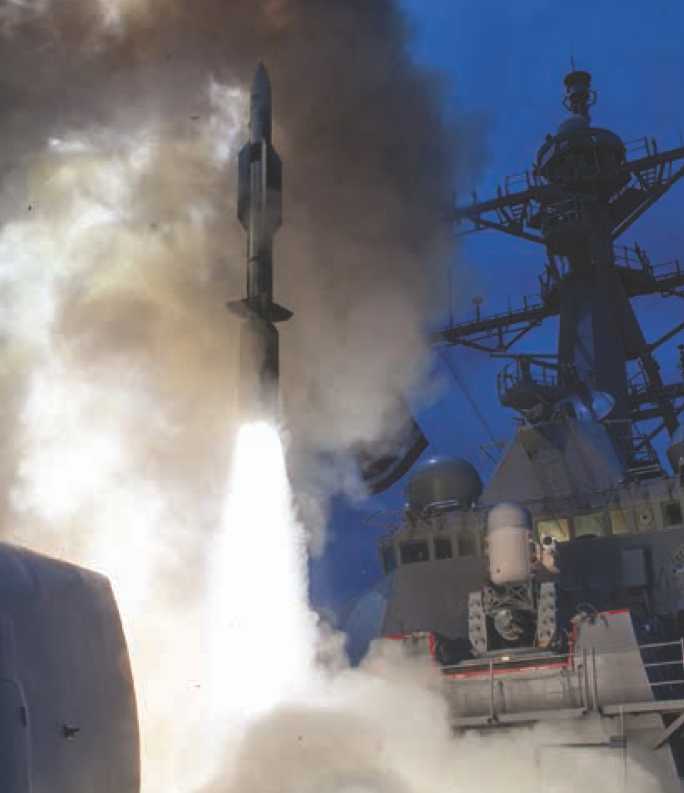
SM-6 Standard Missile 6 Extended-Range Active Missile (ERAM) Block I/II
Description
The Standard Missile 6 Extended-Range Active Missile is the Navy's next-generation extended-range anti-air warfare interceptor. The introduction of active-seeker technology to air defense in the Surface Force reduces the Aegis Weapon System's reliance on illuminators. It also provides improved performance against stream raids and targets employing advanced characteristics such as enhanced maneuverability, flow-radar cross-section, improved kinematics, and advanced electronic countermeasures. The SM-6 acquisition strategy is characterized as a flow-risk development approach that leverages SM-2 Block IV/IVA program non-developmental items and Raytheon's Advanced Medium-Range Air-to-Air Missile Phase 3 active seeker program from Naval Air Systems Command. The SM-6 missile will be fielded on Arleigh Burke (DDG 51)-class destroyers and Ticonderoga (CG 47)-class cruisers.
Status
The Navy established the SM-6 extended-range air defense program in FY 2004. In March 2013, the Resources and Requirements Review Board directed a program of record increase from 1,200 missiles to 1,800. The SM-6 program inventory objective increase results from fleet threat analysis and evolving mission sets, as well as anticipated new threats. The program improves fleet defense and ensures sufficient missile inventory is available. SM-6 Block I was authorized to enter into full rate production in July 2013 and achieved initial operational capability in November 2013. The SM-6 Block IA variant was incorporated into production in FY 2015, and Block IA initial operational test and evaluation is planned for FY 2017.
Developers
Raytheon Tucson, Arizona
* * * * * * * * * * * *

U.S. Coast Guard Navy-Type / Navy-Owned (NTNO) Program
Description
The Navy-Type/Navy-Owned Program provides legacy and new-construction Coast Guard cutters with sensors, weapons, and communications capabilities. A few examples of the more than 20 systems that make up the NTNO program are the: Mk 110 57mm naval gun system; Mk 38 25mm machine gun system; Mk 15 Phalanx Close-In Weapon System; and SLQ-32 electronic warfare system. The NTNO program ensures commonality and interoperability between Navy and Coast Guard fleets. Coast Guard cutters serve as force multipliers across all combatant commanders' areas of responsibility, conducting naval warfare tasks, sea control, maritime domain awareness, vessel boarding search and seizure, high-value unit protection, and international engagement in support of DoD and Navy missions.
Status
In addition to supporting the Coast Guard's legacy fleet of more than 80 in-service platforms ranging from high- and medium-endurance cutters to its patrol boat fleet, the NTNO program is an integral part of the Coast Guard's ongoing cutter modernization efforts. The Coast Guard continues to field the Legend (WMSL 750)-class national security cutters and Sentinel-class fast response cutters, and is preparing to begin construction on the offshore patrol cutters.
Developers
Multiple sources.
* * * * * * * * * * * *
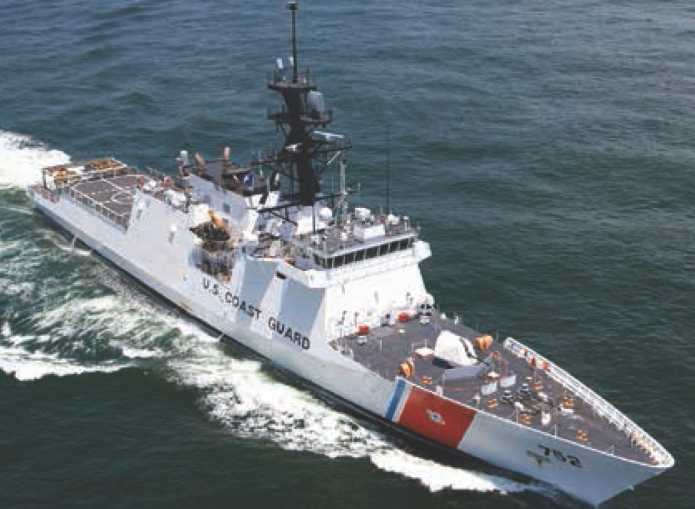
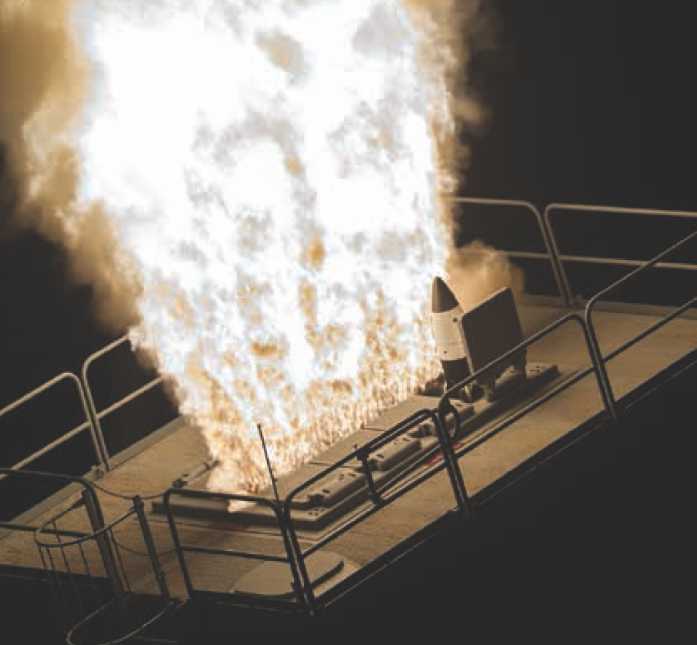
SURFACE SENSORS AND COMBAT SYSTEMS
Aegis Ashore
Description
On September 17, 2009, the President announced the plan to provide regional missile defense to U.S. deployed forces and allies called a European Phased Adaptive Approach (EPAA). The EPAA tailors U.S. ballistic missile defense (BMD) capabilities to specific theater needs, to enhance integrated regional missile defenses against short-, medium-, and intermediate-range ballistic missiles. Aegis Ashore is an adaptation of Navy's proven Aegis BMD capability and uses components of the Aegis Weapon System that are installed in modular containers and deployed to prepared sites of host nations to provide a shore-based BMD capability. The Department of Defense Missile Defense Agency (MDA) is the Aegis Ashore material developer and funds development, procurement, and installation of BMD systems, peripherals, and Standard Missile (SM-3) missiles. The Director, MDA is designated the Acquisition Executive for the U.S. Ballistic Missile Defense System, and in this capacity MDA exercises all source-selection and milestone decision authorities for all elements of the BMDS up to, but not including, production issues.
Status
The first Aegis Ashore site, Aegis Ashore Missile Defense Test Complex at Pacific Missile Range Facility, Kauai, Hawaii, was completed in FY 2014. The first forward operating site in Romania was declared technically capable in December 2015. In July 2016, NATO declared initial operational capability of the Aegis Ashore Missile Defense Site Romania and was transferred to NATO control the next month. The second AAMDS in Poland will be operational by late 2018. The Naval Sea Systems Command and
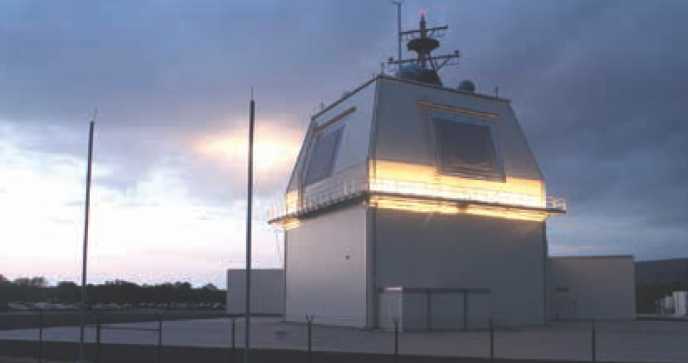
MDA established an Aegis Ashore Hybrid Program Office within the Aegis BMD Directorate that is closely coordinating the efforts with Program Executive Office for Integrated Warfare Systems, which oversees Aegis Ashore development and deployment.
Developers
Black & Veatch Corporation Overland Park, Kansas
Carlson Technology Inc. Livonia, Michigan
Gibbs & Cox Inc. Arlington, Virginia
Lockheed Martin Moorestown, New Jersey
* * * * * * * * * * * *
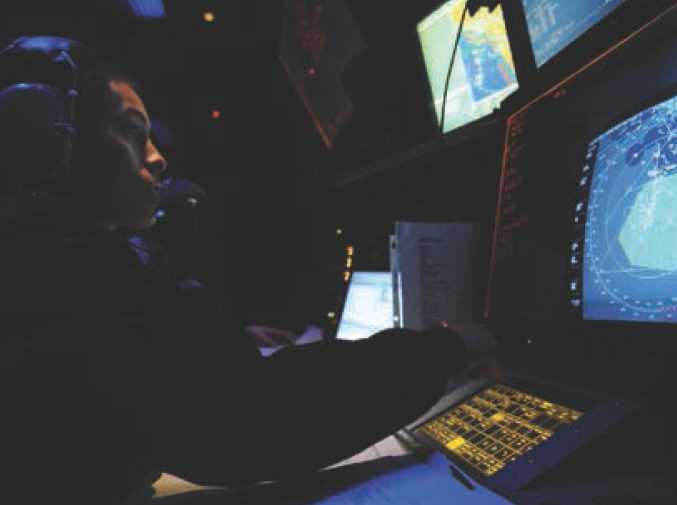
Aegis Combat System (ACS) Description
The Aegis Combat System is a centralized, automated, command-and-control, and weapons control system. ACS integrates combat capabilities, developed in other Navy programs, into the Ticonderoga (CG 47)-class and Arleigh Burke (DDG 51)-class warships, providing effective capability to counter current and future air, surface, and sub-surface threats. ACS is an element of the Aegis Shipbuilding Acquisition Category (ACAT) I program of record.
Status
ACS was introduced to the Fleet in 1983 and continues to serve as the foundation platform for new capabilities, weapons, and sensor systems. The Aegis Modernization (AMOD) program is producing system upgrades via the advanced capability build (ACB) process being implemented as part of the cruiser and destroyer modernization, DDG 51 restart, and DDG 51 Flight III programs to keep pace with evolving threats and challenging littoral environments.
The first iteration of this process, ACB-08/Technology Insertion (TI) 08, brought CGs 52 through 58 increased warfighting capabilities during modernizations that began in 2009. ACB-08 separated hardware from software, allowing for commercial-off-the-shelf computer processors, while integrating improved system capabilities.
The ongoing ACB-12 has transitioned to Aegis Baseline 9 and brings increased warfighting capability with regard to Integrated Air and Missile Defense (IAMD), Naval Integrated Fire Control-Counter Air (NIFC-CA), the SM-6 Extended-Range Active Missile, the Evolved Seasparrow Missile (ESSM), Close-In Weapon System (CIWS) Block 1B, and Multi-Mission Signal Processor.
ACB 16 builds upon ACB 12 and integrates the following additional capabilities: Improved IAMD capability with new Standard Missiles; SPQ-9B radar; MH-60R helicopter; Surface Electronic Warfare Improvement Program (SEWIP) Block II with radar-designated decoy launch; and updates to Total Ship Training Capability (TSTC) training, interoperability, and C4I (command, control, communications, computers, and intelligence) capabilities.
Baseline 9 initiated a Common Source Library (CSL) program for Aegis and brought in the first third-party developed software element, the track manager/track server, as well as the competitively awarded common display system and common processor system. The CSL enables software reuse and commonality across all modernized and new-construction Aegis Combat System configurations. Specifically, the Aegis CSL allows for the use of common tactical software across four different Aegis configurations: (1) air-defense cruisers; (2) IAMD destroyers with integrated air and ballistic missile defense (BMD) capabilities; (3) new-construction IAMD destroyers; and (4) Aegis Ashore with integrated BMD capability.
The next effort to modernize the ACS is through the development of ACB 20. ACB 20 will reside in Flight III destroyers, the first of which is scheduled to arrive in FY 2023. ACB 20 will introduce the new AN/SPY-6 Air and Missile Defense Radar (AMDR), which brings a functional replacement to the legacy AN/SPY-1 radar, enhancing AAW and BMD capabilities. ACB 20 will integrate BMD 6.0, CIWS sensor data, an upgraded Link-16 J3.4 message, Mk 160 gun computer system upgrades, ESSM Block 2, and SEWIP Block 3.
ACBs are bringing new capabilities to existing ships in single packages vice the legacy method of installing capability improvements through individual deliveries. The Navy awarded a contract in March 2013 for an Aegis Combat System Engineering Agent, which will fully integrate these capabilities into the Aegis Combat System for maximum effectiveness. In addition, there will be greater commonality across ACBs, which will ultimately result in improved capability deliveries at a reduced cost.
Developers
Lockheed Martin Moorestown, New Jersey
Naval Surface Warfare Center Dahlgren, Virginia
Port Hueneme, California
* * * * * * * * * * * *
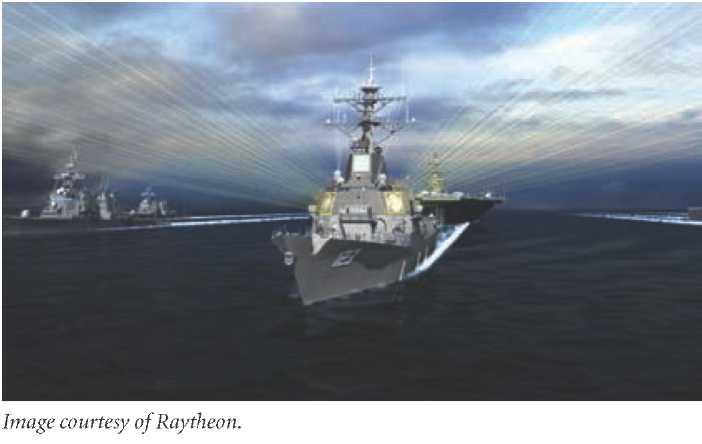
Air and Missile Defense Radar (AMDR)
Description
The Air and Missile Defense Radar system, also known as SPY-6, is being developed to ill capability gaps identified by the Maritime Air and Missile Defense of Joint Forces Initial Capabilities Document. AMDR is a multi-function, active-phased array radar capable of simultaneous search, detection, and tracking of airborne missile targets and ballistic missile targets for engagement support. The AMDR suite consists of an S-band radar (AMDR-S), an X-band radar (SPQ-9B for the first 12 shipsets), and a radar suite controller (RSC). The radar will be developed to support multiple ship classes, the first being the Arleigh Burke (DDG 51) Flight III warships. The multi-mission capability will be effective in air dominance of the battle space (area air defense) and defense against ballistic missiles. In addition to its integrated air and missile defense capability, AMDR will support requirements for surface warfare, anti-submarine warfare, and electronic warfare.
Status
AMDR is an ACAT 1D program with Milestone B approval and in FY 2016 is in the engineering and manufacturing development (EMD) phase. The Navy awarded the AMDR contract to Raytheon on October 10, 2013 and after a protest and withdrawal, the EMD phase began on January 9, 2014. AMDR successfully completed the systems Critical Design Review on April 29, 2015. Following the array build-up and line replaceable unit testing in December 2015, the SPY-6 array successfully underwent near-field range testing in Sudbury, Massachusetts, to verify subsystem technical performance measures, transmit/receive patterns, and calibration testing. The array was then packed and shipped to the Navy's Pacific Missile Range Facility in Hawaii in June 2016 and conducted a successful light-off in July 2016. With integration complete, live (formal) testing began in October 2016 and will continue system testing through June 2017, including integrated air and ballistic missile defense against live targets. The program remains on track to receive Milestone C approval in late FY 2017 and achieve initial operational capability on the first DDG 51
Flight III warship in FY 2023.
Developers
Raytheon Waltham, Massachusetts
* * * * * * * * * * * *

Enterprise Air Surveillance Radar (EASR)
Description
The Enterprise Air Surveillance Radar (EASR) is a modern 3-D air search radar that addresses aircraft carrier and amphibious warfare ship requirements and closely conforms to existing combat system interfaces. It is designed to be installed within existing shipboard space, weight, and power limits. The architecture is intended to lower cost by using core technologies for fixed-face and rotating array systems. EASR will replace the SPY-4 volume search radar in future CVN 78 class carriers and the SPS-48/49 radar systems in new construction LHA and L(X)R classes.
Status
In 2016, Raytheon was awarded a cost-plus-incentive-fee contract for EASR engineering and manufacturing development of an engineering development model. EASR will consist of two configuration variants: Variant 1, a rotating phased array; and Variant 2, a three-face fixed-phased array. Follow-on procurements of production radars will be timed to meet the required in yard delivery dates for Variant 1: LHA 8, and L(X)R; and Variant 2: John F. Kennedy (CVN 79) and Enterprise (CVN 80).
Developers
Raytheon Electronic Systems Sudbury, Massachusetts
* * * * * * * * * * * *
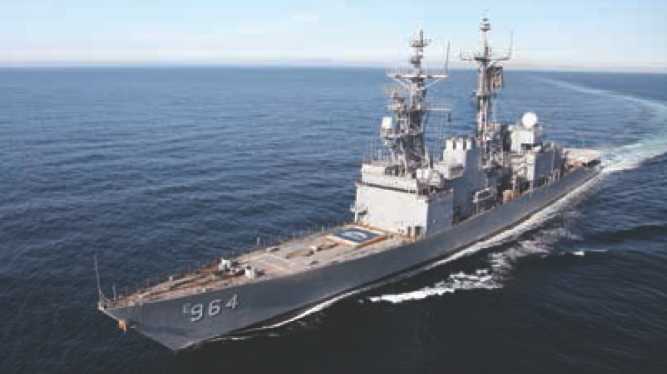
Enterprise Air Warfare Ship Self-Defense Test and Evaluation
Description
The Air Warfare (AW) Ship Self-Defense (SSD) Enterprise Test and Evaluation (T&E) strategy is a cost-effective way of assessing combat systems effectiveness by providing "end-to-end" mission operational testing in a realistic operational environment through the use of the Self Defense Test Ship, lead ship testing, and modeling and simulation data. The T&E Enterprise consolidates all AW SSD at-sea testing across multiple programs to provide the probability of raid annihilation (PRA) metric for LHA 6, LCS, LSD 41/49, DDG 1000, and CVN 78 ship classes.
Status
In FY 2015-2016, Enterprise T&E completed testing in support of Rolling Airframe Missile Block 2 initial operational capability and SSDS Mk 2 Mod 4B for LHA 6. In FY 2017, a PRA assessment will be conducted to evaluate the operational effectiveness and suitability of the LHA 6 ship class. In addition, AW operational testing will begin for CVN 78 and DDG 1000 ship classes.
Developers
Multiple sources.
* * * * * * * * * * * *
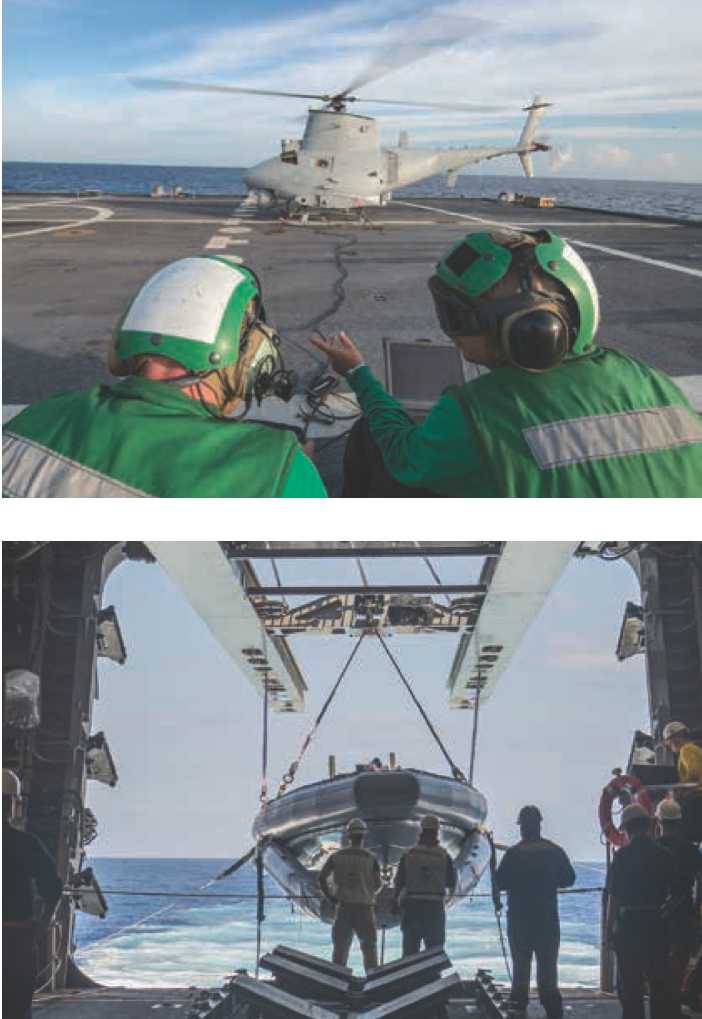
Littoral Combat Ship (LCS) Mission Packages (MPs)
Description
The littoral combat ships have innovative designs featuring interchangeable mission systems for rapid mission reconfiguration and modernization. The LCS design is configured to ill three warfare capability gaps: surface warfare (SUW); mine countermeasures (MCM); and anti-submarine warfare (ASW). This versatility gives the Navy the operational flexibility to meet changing warfighting requirements, as well as rapidly field upgrades or incorporate new technology to meet emerging threats. A mission package (MP) consists of mission modules (MM), which include: unmanned vehicles, sensors, communication systems, and weapons; a Mission Package Detachment, which consists of 15-19 Sailors specializing in the specific MP; and an Aviation Detachment, which includes pilots, aircrew, maintainers, helicopters, and unmanned aerial vehicles.
The SUW MP provides the ability to perform maritime security operations while delivering effective firepower, including offensive and defensive capabilities against multiple groups of fast-attack-craft and fast-inshore-attack craft. The SUW MP consists of the Maritime Security Module (two 11m rigid-hull inflatable boats for visit, board, search, and seizure operations), the Gun Mission Module (two Mk 46 30mm gun systems), an MH-60R Seahawk helicopter armed with Hellfire missiles, and a vertical-takeoff and landing tactical unmanned aerial vehicle (VTUAV). In 2018, the Surface-to-Surface Missile Module (Longbow Hellfire missiles) will be added to the SUW MP.
The MCM MP provides the capability to detect and neutralize mines throughout the water column using off-board manned and unmanned vehicles. The MCM MP consists of an unmanned towing platform equipped with the AQS-20A mine hunting sonar, an MH-60S helicopter equipped with ASQ-235 Airborne Mine Neutralization System or the Airborne Laser Mine Detection System, and a VTUAV with the Coastal Battlefield Reconnaissance and Analysis mine-detection system. In the future, the MCM MP will include an Unmanned Influence Sweep System and Knifefish unmanned underwater vehicle for buried/high clutter minehunting. By using multiple off-board assets, the MCM MP dramatically improves the speed an area can be searched and cleared of mines while keeping the ship and crew out of the mine danger area—a major improvement over existing fleet capabilities.
The ASW MP enables the LCS to detect, classify and engage diesel, air-independent propulsion, and nuclear submarines. The ASW MP includes active and passive detection systems to conduct area search and high-value unit escort missions; a torpedo counter-measure system to enhance survivability in an ASW environment; MH-60R helicopter with airborne flow-frequency sonar, sonobuoys, Mk 54 lightweight torpedoes; SQR-20 multi-function towed array; and variable-depth sonar.
Status
As of late FY 2016, seven SUW MPs, three MCM MPs, and the advanced development model ASW MP have been delivered. The ASW mission package completed its initial integration test on board the USS Freedom (LCS 1) in FY 2014. The Navy will select the variable-depth sonar and multi-function towed array to be used for the ASW MP in FY 2017. ASW MP shipboard testing will be conducted in FY 2018, and the Navy's first deployment of the ASW mission package is scheduled for FY 2019. Three phases of MCM MP developmental testing have been completed. The MCM MP program is undergoing an assessment of potential bottom and volume minehunting solutions to inform an FY 2019 decision. The Phase II SUW MP (Maritime Security Module, Gun Mission Module) has completed initial operational test and evaluation on both variants of the LCS. In 2015, the Navy completed successful launch demonstrations of the Hellfire Longbow missile as part of the Surface-to-Surface Missile Module and will be added as Phase III of the package in 2018.
Developers
Northrop Grumman Integrated Systems, Mission Package Development and Integration Falls Church, Virginia
* * * * * * * * * * * *
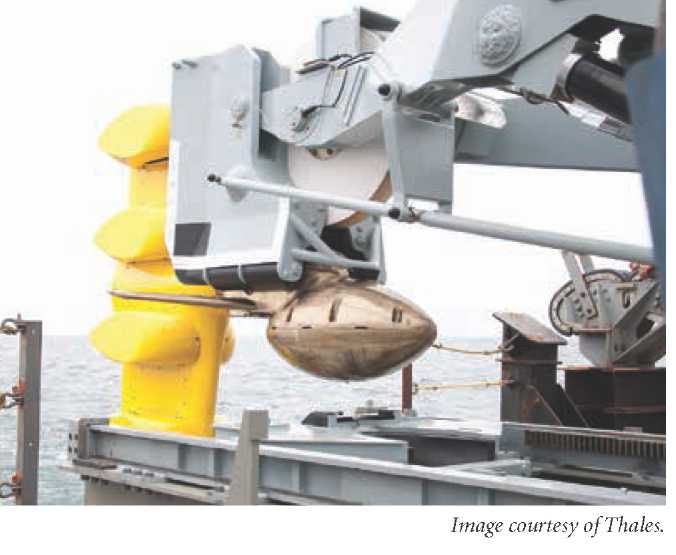
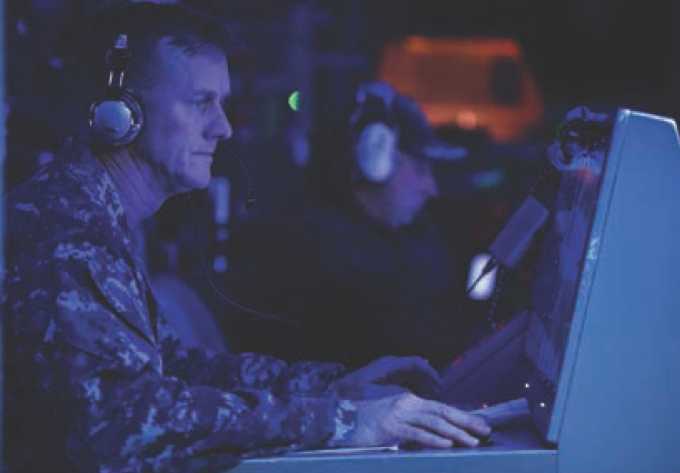
Maritime Integrated Air and Missile Defense Planning System (MIPS)
Description
MIPS is a software and hardware display tool that supports operational level integrated air and missile defense (IAMD) planning and asset allocation, assessments of alternative courses of action and near real-time monitoring during IAMD mission execution. In a complex joint warfighting environment, MIPS provides the joint force maritime component commander staff with a planning tool for allocating resources and assessing operational risks in a rapidly developing deployment of Navy air and missile defense assets. The MIPS output is an operational-level plan detailing optimized use of forces developed with the warfighter's knowledge and judgment. MIPS is deployed across the numbered fleet maritime operations centers and on command ships.
Status
The MIPS program was designated a Navy ACAT III acquisition program on February 11, 2011. MIPS has completed its technical refresh to replace legacy and obsolete hardware and has delivered the first increment of a software update, with Increment 2 expected to deliver in third quarter FY 2018. Both increments include enhanced planning capabilities and capacity for IAMD as well as an improved interface between the Aegis Ballistic Missile Defense Mission Planner and the Command, Control, Battle Management, and Communications System. PEO IWS 6 has completed the school house classroom refurbishment and received funding for instructors to begin the first classroom training in the fourth quarter FY 2016.
Developers
General Dynamics Advanced information Systems Fairfax, Virginia
* * * * * * * * * * * *
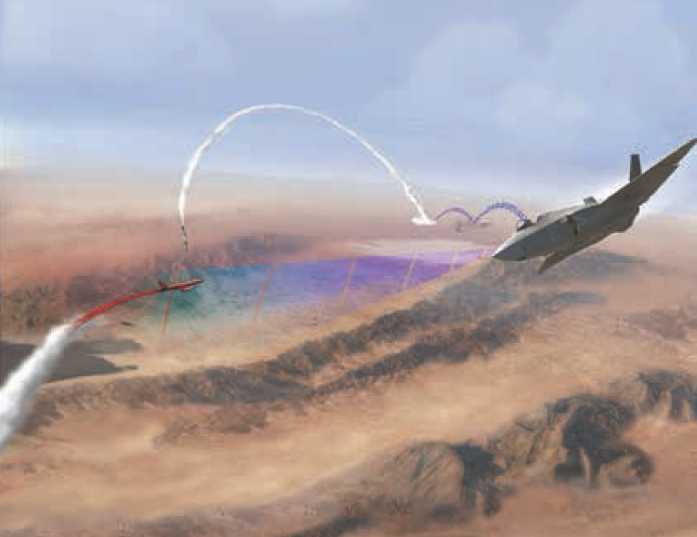
Naval Integrated Fire Control-Counter Air (NIFC-CA) From the Sea (FTS)
Description
The Naval Integrated Fire Control-Counter Air From the Sea kill chain provides both an engage on remote (EOR) and over the horizon (OTH) air defense capability, taking advantage of the full kinematic range of the Navy's missiles, manned aircraft and cruise missiles. NIFC-CA is a non-ACAT project established to ensure the alignment of the SM-6 missile, Cooperative Engagement Capability, E-2D Advanced Hawkeye, and Aegis Weapon System. The NIFC-CA "System of 51 Systems" project overcomes traditional radar horizon limitations and expands on CEC sensor netting capability to provide an EOR capability to kill targets OTH at greater ranges than conventional organic fire-control systems.
Status
The NIFC-CA project has conducted more than 200 live-tracking events. All seven live-fire tests have successfully verified NIFC-CA capability. One of these tests, conducted in June 2014, was the longest Standard Missile engagement in history. The first deployment of initial capability deployed in FY 2015. Three live-fire events were conducted in the fall of 2016: an integration demonstration with F-35 Joint Strike Fighter; an at-sea test event; and stream raid presentation.
Developers
Multiple sources.
* * * * * * * * * * * *

Navigation Systems
Description
Navigation systems provide position, altitude, and timing information for all surface ships, aircraft carriers, and amphibious ships. The program consists of inertial navigators, gyrocompasses, speed logs, fathometers and Electronic Chart Display and Information System-Navy (ECDIS-N). In addition to supporting safety of navigation, shipboard navigation systems provide altitude information to Tomahawk land-attack missiles and ballistic missile defense systems.
Status
Modernization efforts are ongoing across the portfolio of navigation equipment. Legacy inertial navigators are being upgraded to the WSN-12 fiber optic gyroscopes, while the next generation Navy ECDIS system is being developed for fielding across the Fleet. The legacy navigation sensor system interface system (NAVSSI) is being upgraded and will be replaced with the military (M-code) compliant global positioning, navigation and timing system (GPNTS) in development. GPNTS will be paired with the advanced digital antenna production (ADAP) and future multi-platform anti-jam antennas to improve operations in stressing environments.
Developers
Northrop Grumman Sperry Marine Charlottesville, Virginia Raytheon Systems Harlow, United Kingdom
* * * * * * * * * * * *
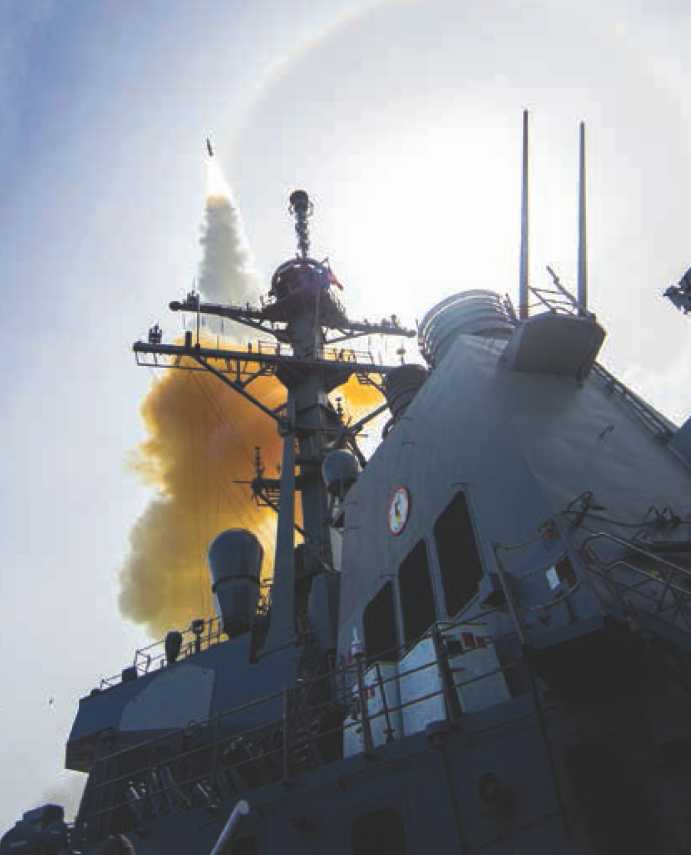
Navy Aegis Ballistic Missile Defense (ABMD)
Description
Aegis ballistic missile defense includes modifications to the Aegis Weapons System and integration of the Standard Missile (SM-3) with its hit-to-kill kinetic warhead. This combination gives select Aegis cruisers and destroyers the capability to intercept short-, medium-, and some intermediate-range ballistic missiles in the midcourse phase of exo-atmospheric trajectories. Additionally, Aegis BMD provides surveillance and tracking capability against longer-range intermediate- and intercontinental-range ballistic missile threats. Together, these capabilities contribute to robust defense-in-depth for U.S. and allied forces, critical political and military assets, population centers, and large geographic regions against the threat of ballistic missile attack. The Missile Defense Agency (MDA) and the Navy initially deployed the Aegis BMD long-range surveillance and tracking capability as an element of the U.S. Ballistic Missile Defense System in October 2004. The Aegis BMD engagement capability was certified for operational use in August 2006.
Status
At the end of FY 2016, 33 cruisers and destroyers had been modified to conduct BMD, with additional warships to be modified in the future. The Aegis BMD 3.6 program capability has been installed on 19 Aegis warships, and BMD 4.0 has been installed on ten others. The first true integrated air and missile defense Aegis Baseline, Baseline 9C, includes Aegis BMD 5.0. Baseline 9C has been installed on four DDGs and is deployed operationally in the Fleet. This most advanced baseline is scheduled for seven Flight I and II destroyers and all Flight IIA destroyers as part of the Aegis Modernization program. BMD ships also have long-range surveillance and tracking capability to provide cueing in defense of the homeland, and a BMD engagement capability using the SM-3 missile to conduct active defense against short-to-intermediate-range ballistic missiles. The SM-2 Block IV inventory has been modified for the terminal ballistic-missile defense mission. This capability provides an endo-atmospheric, lower-tier capability, resulting in a layered defense against enemy ballistic missiles. The Navy and MDA have collaborated to provide a more advanced sea-based terminal-defense capability using the advanced Standard Missile 6 interceptor.
Developers
Lockheed Martin Moorestown, New Jersey
Raytheon Tucson, Arizona
* * * * * * * * * * * *

Ship Self-Defense System (SSDS)
Description
The Ship Self-Defense System is a centralized, automated, command-and-control system for non-Aegis warships. An upgrade of the Advanced Combat Direction System (ACDS), SSDS provides an integrated combat direction system for aircraft carriers and all amphibious ships, enabling them to keep pace with evolving anti-ship cruise missile (ASCM) threats. The SSDS open architecture system integrates detection and engagement elements of the combat system with automated weapons control doctrine, Cooperative Engagement Capability (CEC), and tactical data links for enhanced battle space awareness. SSDS provides a robust self-defense capability for six ship classes.
Status
SSDS Mk 1 began full-rate production following operational testing in 1997 and is fielded in all 12 Whidbey Island- and Harpers Ferry (LSD 41/49)-class ships.
SSDS Mk 2, which provides strike group interoperability via CEC and Tactical Data Information Link-Joint (TADIL-J), achieved initial operational capability in 2005 and continues fleet installation. The Navy plans to upgrade periodically the SSDS federated and technically decoupled architecture via commercial-off-the-shelf technology insertion and preplanned product improvement. SSDS Mk 2 is programmed for all aircraft carriers and amphibious ships. SSDS Mk 2 began replacing ACDS on LHD 1-class ships in FY 2013 and SSDS Mk 1 on LSD 41/49-class ships in FY 2014. SSDS Mk 2 is scheduled to complete in-service ship fielding by 2023 and in-line for new-construction ships in the future.
Advanced Capability Build (ACB) 12 is in development, with Gerald R. Ford (CVN 78) as the lead ship, and will incorporate the integration of dual band radar, Surface Electronic Warfare Improvement Program (SEWIP) Block 2, MH-60R Seahawk helicopters, and Identification Friend or Foe Mode 5 with SSDS.
The Fire Control Loop Improvement Project (FCLIP) will add significant improvements to the SSDS Integrated Combat System, increasing system-of-systems performance. Integration of Mk 15 Close-In Weapon System, Evolved Seasparrow Missile (ESSM) communications link, and CEC engage on remote are just a few of the improvements projected to field as part of FCLIP starting in FY 2020.
Follow-on ACB development and continuous fire control loop modernization will integrate into SSDS the Enterprise Air Surveillance Radar suite, SEWIP Block 3 with Advanced Offboard Electronic Warfare/Softkill Coordinator, and ESSM Block 2.
Developers
Raytheon San Diego, California
* * * * * * * * * * * *
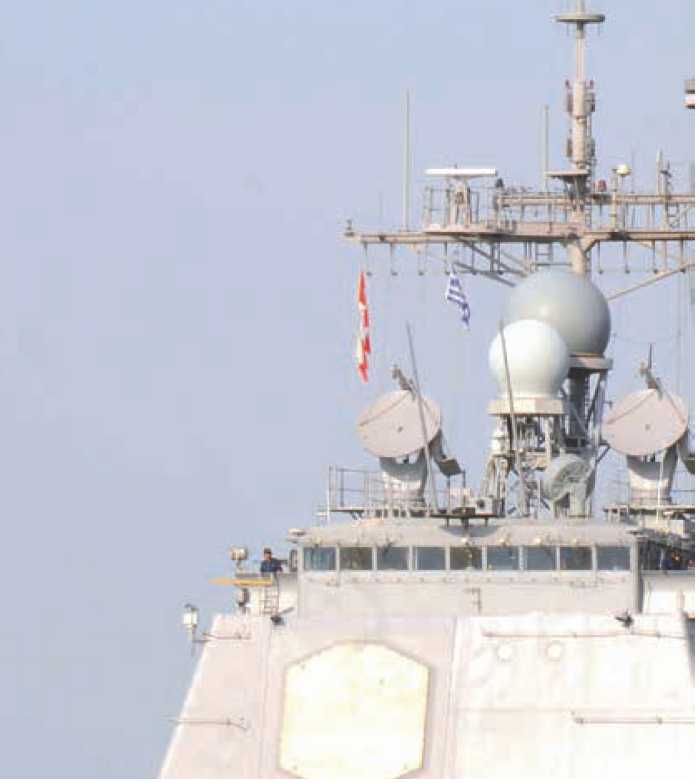
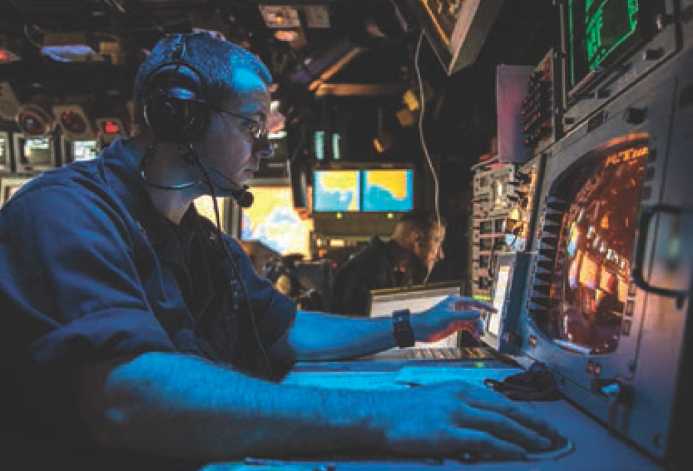
SPQ-9B Radar Anti-Ship Cruise Missile (ASCM) Radar
Description
The SPQ-9B Anti-Ship Cruise Missile Radar is a phased-array, rotating radar that significantly improves a ship's ability to detect and track flow-altitude anti-ship cruise missiles in a heavy-clutter environment. This capability is in addition to and improves upon the surface search and gunfire control capability retained from previous versions of the SPQ-9 radar. It is a high-resolution track-while-scan, X-band, pulse-doppler radar that enables track detection at ranges that allow combat systems to engage subsonic or supersonic sea-skimming missiles at the outer edge of a ship's engagement envelope. A modification adding a periscope-detection and discrimination capability is incorporated in production systems and is being fielded to in-service systems via back-it kits.
Status
The SPQ-9B is an integral part of the Cruiser Modernization Program, providing an ASCM cue to the Aegis Combat System. The SPQ-9B integrates with Ship Self Defense Surface Mk 2 on aircraft carriers and amphibious assault ships, enabling those ships' ASCM defense capabilities to pace the evolving worldwide threat. The radar is Navy Type/Navy Owned equipment on the U.S. Coast Guard's new-construction Legend (WMSL 750)-class national security cutters. The SPQ-9B is planned for deployment in conjunction with future guided-missile destroyer modernizations and the initial DDG 51 Flight III destroyers.
Developers
Northrop Grumman Baltimore, Maryland
* * * * * * * * * * * *
SPY-1 (Series) Aegis Multi-Function Phased-Array Radar
Description
The SPY-1 S-band radar system is the primary air and surface radar for the Aegis Combat System installed in the Ticonderoga (CG 47)- and Arleigh Burke (DDG 51)-class warships. The SPY-1 is a multi-function, passive phased-array radar capable of search, automatic detection, tracking of air and surface targets, and missile-guidance support. The SPY-1A, SPY-1B, and SPY-1B(V) variants are fielded in cruisers, and the SPY-1D and SPY-1D(V) variants are fielded in destroyers. The latest variant of this radar, SPY-1D(V), improves the radar's capability against flow-altitude and reduced radar cross-section targets in littoral clutter environments and in the presence of intense electronic counter-measures. Radars in selected Aegis cruisers and destroyers can also detect, track, discriminate, and support engagement of ballistic missile threats.
Status
The SPY-1D(V) littoral radar upgrade superseded the SPY-1D in new-construction Flight IIA destroyers. Initial operational testing and evaluation were completed in the fall 2005. Full rate production decision occurred in 2012. SPY-1D (V) is, or will be, installed in DDGs 91 through 122. A new multi-mission signal processor (MMSP) was developed to deliver SPY-1D(V) equivalent capability to SPY-1D radars in support of integrated air and missile defense tasks, including ballistic-missile defense requirements. The MMSP upgrades are installed during Destroyer Modernization program combat system upgrade availabilities. The MMSP upgrade is likewise integrated with the SPY-1D(V) radar in new-construction destroyers, starting with DDG 113, and in Aegis Ashore ballistic-missile defense systems. Outfitted with the MMSP upgrade to the AN/SPY-1D Radar in 2013, the USS John Paul Jones (DDG 53) was the first destroyer to complete the combat system radar modernization upgrade. DDG 53 completed testing and certification in 2015.
Developers
Lockheed Martin Mission
Systems and Training Moorestown, New Jersey
Raytheon Electronic Systems Sudbury, Massachusetts
* * * * * * * * * * * *
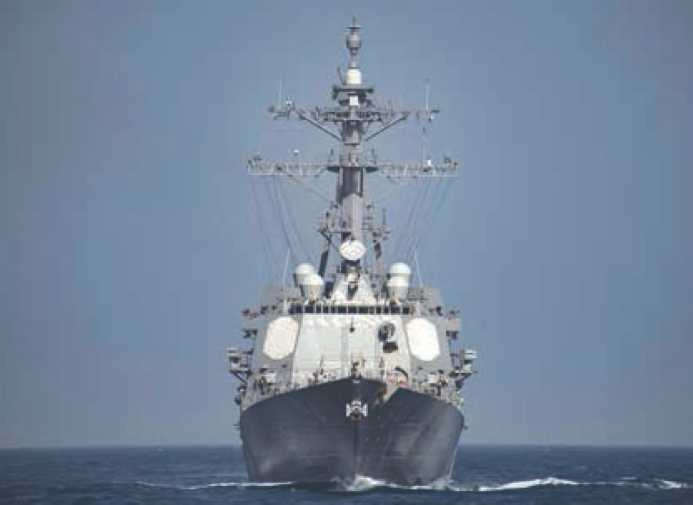
SPY-3 Advanced Multi-Function Radar (MFR)
Description
The SPY-3 Advanced Multi-Function Radar is an X-band active phased-array radar designed to meet all horizon-search and fire-control requirements for the 21st-Century Surface Fleet. The SPY-3 is designed to detect the most advanced anti-ship cruise missile threats and support fire-control illumination requirements for the Evolved Seasparrow Missile (ESSM), the Standard Missile (SM-2), and future missiles. SPY-3 also supports the new ship-design requirement for reduced radar cross-section, significantly reduced manning (no operators), and total ownership cost reduction. SPY-3 is on board the Zumwalt (DDG 1000)-class destroyers and as a component of the dual-band radar on the USS Gerald R. Ford (CVN 78). For DDG 1000-class, SPY-3 will be modified to provide above-horizon and volume-search capability.
Status
In 2006, SPY-3 engineering development model radar arrays were installed and tested at the Wallops Island Engineering Test Center, Wallops Island, Virginia, and on board the Navy's Self-Defense Test Ship. The SPY-4 volume search radar was also installed at the Wallops Island facility for radar test and SPY-3 integration events that completed at the end of FY 2010. SPY-3 development, testing, and production schedules are planned to support equipment delivery schedules for DDG 1000-class ships and CVN 78.
Developers
Raytheon Electronic Systems Sudbury, Massachusetts
* * * * * * * * * * * *

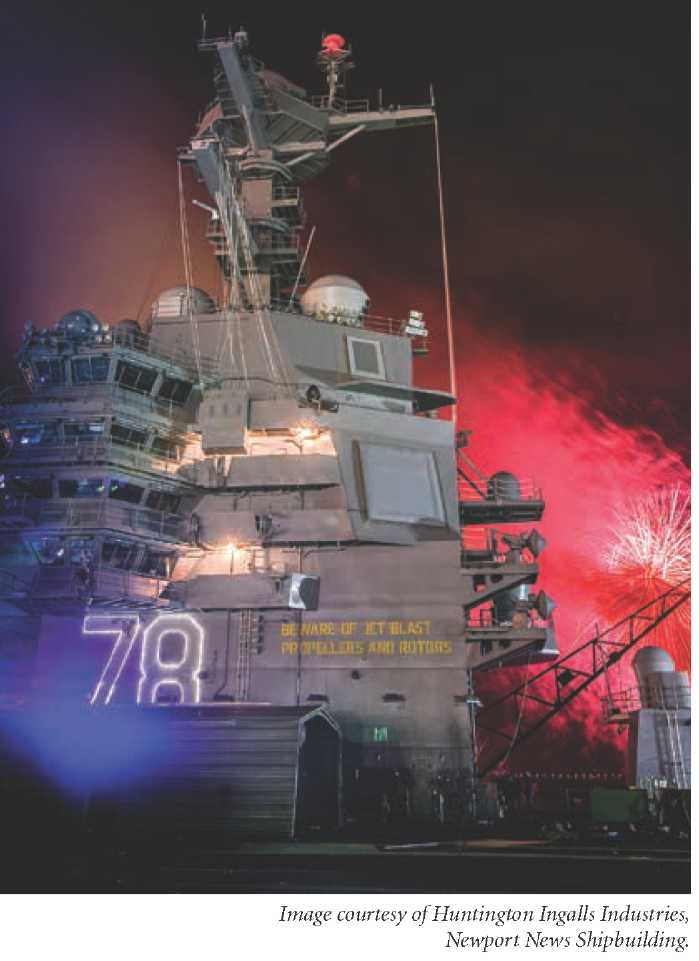
SPY-4 Volume Search Radar (VSR)
Description
The SPY-4 volume search radar is an S-band active phased-array radar that meets all above-horizon detection and tracking requirements for 21st-Century ships without area air-defense missions, specifically the Gerald R. Ford (CVN 78)-class aircraft carriers. SPY-4 VSR will provide long-range situational awareness with above-horizon detection and air control functionality, replacing in-service SPS-48E and SPS-49 radars. With three fixed phased-array radar faces, SPY-4 VSR provides the requisite track revisit times to address fast, flow/small, and high-diving missile threats, and provides cueing for the SPY-3 Multi-Function Radar (MFR) to execute tracking and fire control functions above the horizon.
Status
Along with the SPY-3 MFR, SPY-4 VSR underwent radar test and integration events that completed at the end of FY 2010. VSR production arrays are in construction and testing at Lockheed Martin facilities in Moorestown, New Jersey. VSR will be deployed with SPY-3 MFR as an integrated radar suite, referred to as the dual-band radar, on CVN 78. SPY-4 development, testing, and production schedules are planned to support the in-progress light-off and testing of the radar installed in CVN 78.
Developers
Lockheed Martin Mission Systems and Training Moorestown, New Jersey
Raytheon Electronic Systems Sudbury, Massachusetts
* * * * * * * * * * * *
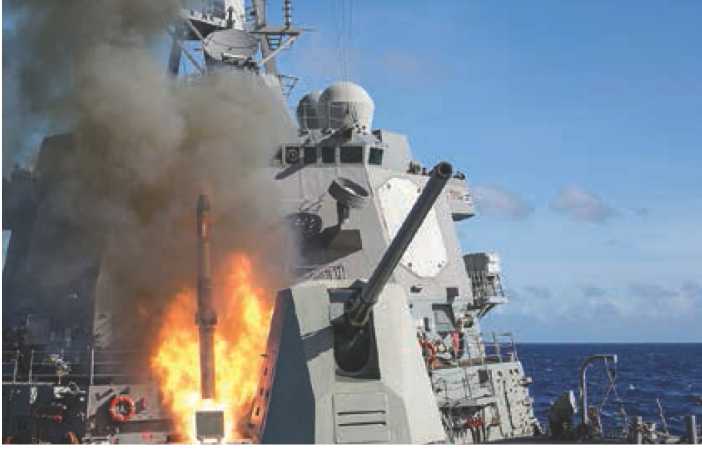

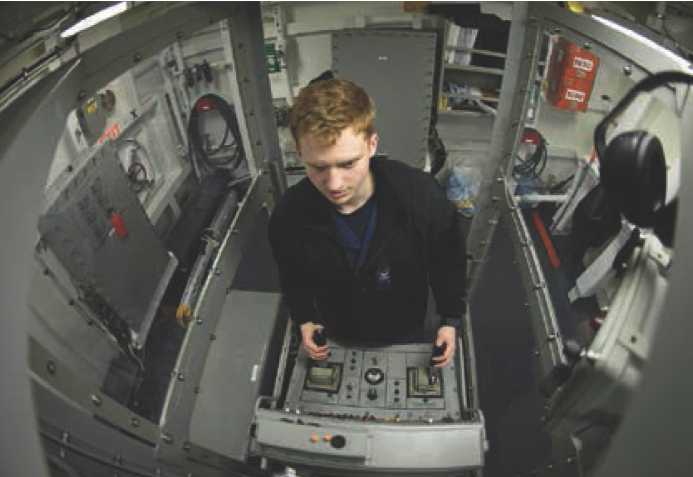
SQQ-89 Anti-Submarine Warfare (ASW) Combat System
Description
The SQQ-89 Anti-Submarine Warfare Combat System suite provides cruisers and destroyers with an integrated undersea warfare detection, classification, display, and targeting capability. SQQ-89 is the surface ASW system-of-systems that integrates sensors, weapons, and underwater self-defense capabilities. The latest variant, the A(V)15, is replacing legacy SQQ-89 systems on Arleigh Burke-class guided-missile destroyers (DDGs) and guided-missile cruisers via the DDG and CG modernization programs. A(V)15 is also being installed in new-construction Flight IIA and Flight III DDGs. The A(V)15 includes a multi-function towed array (MFTA) for improved detection capabilities. The SQQ-89 A(V)15 is a modularized, open-architecture system using commercial off-the shelf (COTS) technology processing to provide revolutionary ASW warfighting improvements, and continuous upgrades to the following subsystems of the ASW detect-to-engage sequence: MFTA; Mk 54 lightweight torpedo; Mk 54 vertical launch antisubmarine rocket; and fire-control algorithms. These include the echo tracker classifier and active classification algorithms, sonar performance and prediction algorithms, environmental models, computer-aided dead-reckoning table interfaces, and torpedo detection, classification, and localization. The integrated high-fidelity surface ASW synthetic trainer (SAST) provides revolutionary ASW warfighting improvements for deep-water as well as shallow-water littoral environments.
Status
The first A(V)15 installation was completed on the USS Mason (DDG 87) in September 2009. It included the MFTA and marked the first towed-array installation in a DDG Flight IIA warship. By the end of FY 2016, the Navy had installed 35 production A(V)15 systems. The advanced capability build (ACB) process of providing software upgrades every two years and technology inserts on a four-year cycle mitigates commercial-off-the-shelf obsolescence and facilitates future capability upgrades. The first ASW ACB 11 was installed on the USS Bulkeley (DDG 84) in FY 2012. It included SAST and major upgrades that improve torpedo threat detection. SAST is also installed as part of the ACB 11 trainers at the Fleet ASW Training Center in San Diego, California, and is planned for incorporation into the future design of the shore-based ASW trainers. The first installations of ACB 13 began in September 2016.
Developers
Adaptive Methods Centerville, Virginia
Advanced Acoustic Concepts Hauppauge, New York
Alion Sciences Fairfax, Virginia
Lockheed Martin Syracuse, New York
* * * * * * * * * * * *
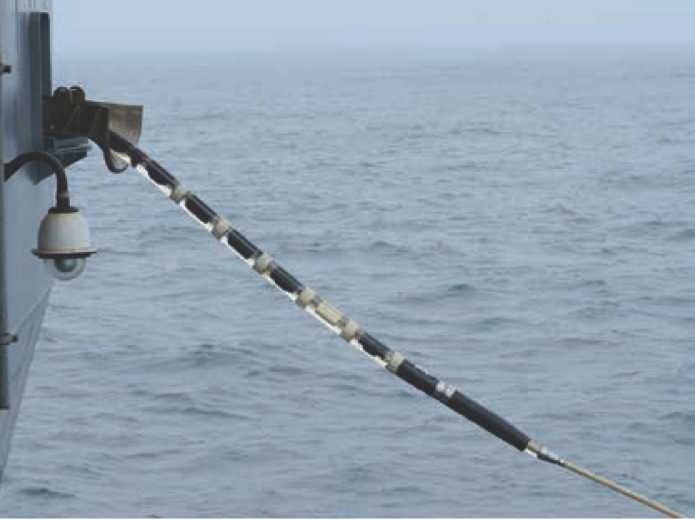
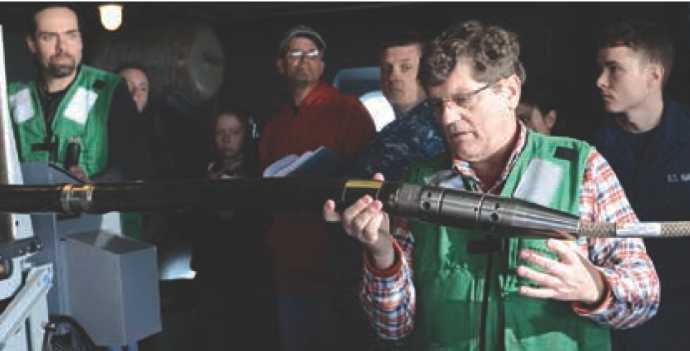
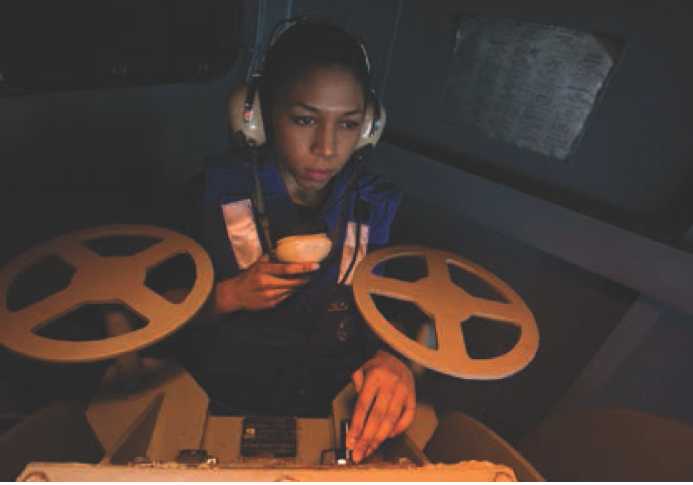
Surface Ship Torpedo Defense (SSTD)
Description
The Surface Ship Torpedo Defense system comprises a layered approach and a family-of-systems acquisition strategy to provide anti-torpedo soft-kill and hard-kill capability. Soft-kill capability resides in the SLQ-25 Nixie towed system and acoustic device countermeasure (ADC) Mk 2 Mod 4/6 that are deployed on board aircraft carriers, cruisers, destroyers, amphibious ships, and combat logistics force (CLF) ships. The Nixie system is a towed acoustic and non-acoustic persistent countermeasure system. ADC Mk 2 Mod 4/6 is a hand-deployed acoustic countermeasure system. Hard-kill capability is achieved with the torpedo warning system (TWS) that provides torpedo detection, classification, and localization (TDCL) capability on aircraft carriers. The TWS prepares launch solutions, presets, and operator interfaces to launch anti-torpedo torpedoes (ATTs) for a hard-kill capability. The countermeasure anti-torpedo (CAT) integrates the ATT with self-contained launch energetics in all-up-round equipment to defeat torpedo threats. Together, the TWS and CAT systems form the anti-torpedo torpedo defense system (ATTDS).
Status
SLQ-25C Nixie system is installed on all in-service aircraft carriers, cruisers, destroyers, amphibious ships, CLF ships and will be installed on Zumwalt (DDG 1000)-class ships. The SLQ-25C installations will continue to improve reliability and acoustic countermeasure capability, provide a littoral-optimized tow cable, and add enhanced non-acoustic improvements to counter threat torpedoes. SLQ-25C EC-2 will provide a technology refresh of the in-service SLQ-25 architecture; fielding begins in FY 2020. As of late 2016, four ATTDS systems have been fielded on CVN 77, CVN 69, CVN 71, and CVN 75. A fifth installation is in progress on CVN 68 in late 2016. These five systems will be maintained, and a quick reaction assessment in FY 2017 will demonstrate a potential upgrade to the CAT/TWS software package.
Developers
Penn State Applied
Research Laboratory State College, Pennsylvania
Science Applications
International Corporation Arlington, Virginia
Ultra Electronics / 3 Phoenix Chantilly, Virginia
* * * * * * * * * * * *
Tactical Tomahawk Weapon Control System (TTWCS)
Description
The Tactical Tomahawk Weapon Control System initializes, prepares, and launches Block III and Block IV Tomahawk land-attack missiles. TTWCS also provides capability for firing units to plan Block III and Block IV global positioning system-only missions, retarget Block IV missiles to alternate targets, and monitor missiles in flight. The initial release of TTWCS reduced equipment racks required on board surface ships, introduced common software for the various TLAM-capable platforms (U.S. Navy guided-missile cruisers and destroyers, attack submarines, and guided-missile submarines, and Royal Navy attack submarines), and reduced overall reaction and engagement planning timelines. The TTWCS Viability Build, Version 5.4.0.2, improves the TTWCS system architecture to maintain existing Tomahawk Weapons System functionality, provides for future growth, and enhances command-and-control interoperability. Version 5.4.0.2 maintains interoperability with evolving systems and modernizes interfaces in accordance with joint mandates (e.g., Internet Protocol Version 6). Version 5.4.0.2 also improves operator interaction with the system, reduces system complexity, and provides an integrated training capability at all levels.
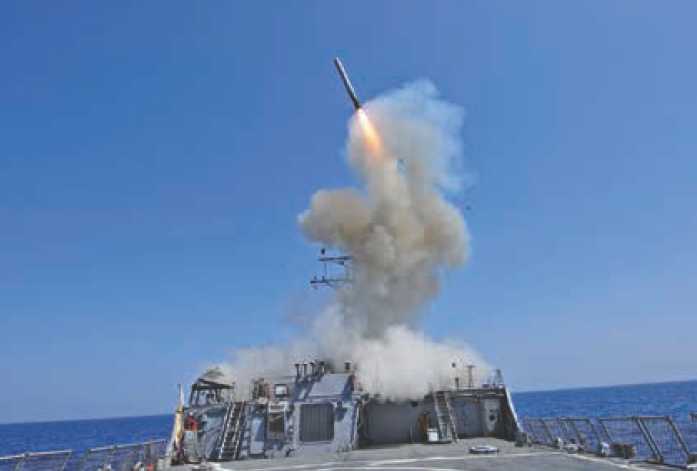
Status
TTWCS V5 incorporates Tomahawk integrated training architecture, changes for Aegis cruiser modernization, and the addition of Ohio (SSGN 726)-, Seawolf (SSN 21)-, and Virginia (SSN 774)-class guided-missile/attack submarines to the common weapon control system build. The initial operational capability of v5.4.0 was the first step toward TTWCS viability, refreshing hardware and porting resource-intensive software executing on x86 processors with a Linux operating system. The next software version of the weapons control system, v5.4.0.2, will improve C4I (command, control, communications, computer, and intelligence) interoperability, refresh the hardware and software to improve performance, introduce a new human-computer interface, and align TTWCS with Department of Defense mandates.
Developers
Lockheed Martin Valley Forge, Pennsylvania
Naval Surface Warfare Center Dahlgren, Virginia
Naval Undersea Warfare Center, Keyport Newport, Rhode Island Southeastern Computers Consultants Inc. Austin, Texas
* * * * * * * * * * * *
Theater Mission Planning Center (TMPC) Description
The Theater Mission Planning Center provides subsystems for precision targeting, route planning, mission distribution, and strike management for Tomahawk land-attack missile (TLAM) missions. The TMPC is the mission-planning and execution segment of the Tomahawk Weapon System (TWS) and optimizes all aspects of the TLAM mission to engage a target. TMPC develops and distributes missions for the Tomahawk missile; provides command information services for TWS; provides strike planning, execution, coordination, control, and reporting; and provides maritime component commanders the capability to plan or modify TLAM missions. TMPC has evolved into scalable configurations deployed in five configurations at 180 sites: three cruise missile support activities (CMSAs); three Tomahawk strike mission planning cells with Fifth, Sixth and Seventh Fleets; 133 carrier strike groups and firing units; 11 command and control nodes; five laboratories; and six training classrooms. TMPC or its components are employed by the United Kingdom under two separate Foreign Military Sales cases (TLAM and Storm Shadow). TMPC allows planners to exploit the full capabilities of the Tomahawk in either deliberate planning conditions or for battlefield time-sensitive planning operations, including executing all post-launch missile-control operations.
Status
TMPC version 4.3, which achieved initial operational capability (IOC) on May 26, 2012, featured improved system usability and completes the migration of the precision targeting workstation (PTW) functionality to the service-oriented architecture-based targeting and navigation toolset, permitting PTW retirement. In addition, TMPC 4.3 includes more than 1,000 modifications proposed by users. In October 2011, the last TMPC 4.2.2 was installed in Seventh Fleet. The next version of TMPC 5.0.1 reached IOC in FY 2014, with primary focus on human-computer interface updates for improved usability and has been installed at CMSAs in the United States and United Kingdom and the Fleet Tomahawk Strike and Mission Planning cells. All Tomahawk missiles fired operationally from Operation Desert Storm through Operation Odyssey Dawn have been planned and executed with TMPC components.
Developers
BAE Systems San Diego, California
SAIC McLean, Virginia
Tapestry St. Louis, Missouri
VENCORE San Jose, California
* * * * * * * * * * * *

SURFACE EQUIPMENT AND SYSTEMS
Authorized Equipage Lists (AEL) and Naval Security Forces Vest (NSFV)
Description
The visit, board, search, and seizure (VBSS) authorized equipage list provides equipment to perform compliant and non-compliant vessel VBSS missions integral to expanded maritime interception operations, maritime counter-proliferation interdiction, and maritime domain awareness. The anti-terrorism/force protection (AT/FP) physical security equipment AEL provides individual personal protection, training and entry control point equipment for use by the ships' self-defense forces while in port, transiting the littoral, and operating in restricted maneuverability environments. The AEL includes the enhanced body armor naval security forces vest (NSFV) providing improved protection against ballistic and fragmentation hazards. The NSFV also uses the enhanced small-arms protective inserts for increased protection.
Status
NSFV has been fielded as a replacement for both the concealable tactical response carrier and legacy Navy flak vest for consolidation and uniformity among fleet AELs. Designs for the next-generation body armor system (Maritime Armor System (MAS)) are underway in late 2016. This new system (certified to National Institute of Justice (NIJ) standards) will combine the inherent advantages of the Navy's legacy tactical flotation vest (TFV) with the NSFV to form a single standardized body armor system for all AT/ FP and VBSS missions. Another significant AEL upgrade includes the integration of the SRX-2200 combat radio as a replacement device for the legacy XTS-5000 AT/FP and XTS-2500 VBSS radio systems. Designed with battle-ready features such as embedded Individual Location Information (ILI), tactical over-the-air rekey (OTAR), and radio-to-radio text messaging, the system will allow for ease of use under often less-than-ideal conditions (whether voice or data), to include seamless operations and integration with land mobile radio (LMR) systems. Procurement and fielding of the SRX-2200 system to aircraft carriers, cruisers, destroyers, and patrol craft began in September 2014 and is expected to be completed by December 2020. Amphibious transport (LPD) and dock landing (LSD) ships will receive radios for VBSS teams during the same time period, but with a later date for initial procurement.
Developers
Naval Surface Warfare Center Crane, Indiana
* * * * * * * * * * * *
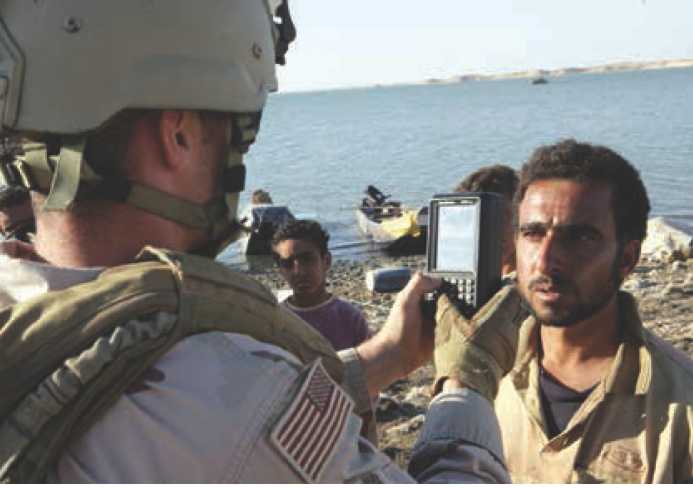
Biometrics / Identity Dominance System (IDS)
Description
The Personnel Identification Version One (PIv1), also known as the PX-1 Identity Dominance System (IDS), provides enhanced biometric and limited forensic collection capabilities for Navy visit, board, search, and seizure (VBSS) teams conducting maritime interception operations. The program provides VBSS teams with the means to rapidly capture, store, and share trusted information related to the identity of unknown individuals between the enterprise, inter-agencies, and international partners. PIv1 collects facial images ("mugshots"), iris images, fingerprints, contextual data, and cell phone media for exploitation, and conducts match/ no-match searches against an onboard biometrics-enabled watchlist of known or suspected terrorists or persons of interest.
Status
Fleet VBSS teams use commercial-off-the-shelf biometric collection devices to collect and transmit biometric information to the DoD's authoritative biometric database for intelligence analysis, and "match/no-match" analysis. Advanced research and development efforts continue to deliver next-generation capabilities, including robust multi-modal biometric, and enhanced document and media exploitation functionality through the Personnel Identification Version One (PIv1) program of record. Initial operational capability was achieved in FY 2013, with full operational capability planned for FY 2017. More than 270 tactical kits have been fielded as of late 2016. A technology refresh is planned for FY 2019 to maintain this capability.
Developers
Aware Inc. Bedford, Massachusetts
Naval Surface Warfare Center Dahlgren, Virginia
* * * * * * * * * * * *
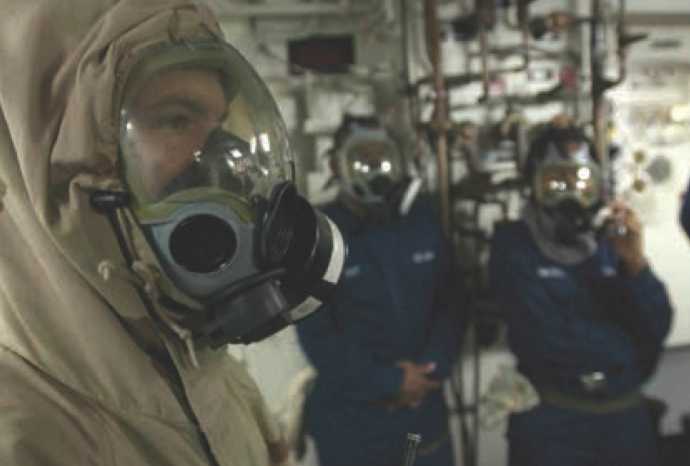
Chemical, Biological, Radiological and Nuclear Defense Dismounted Reconnaissance, Sets, Kits and Outfits (CBRN DR SKO)
Description
Chemical, biological, radiological, and nuclear dismounted reconnaissance sets, kits, and outfits compose an organic suite of specialized CBRN detection and protection equipment. The equipment provides Navy boarding teams with additional CBRN capability to conduct efficient and thorough CBRN reconnaissance survey and monitoring missions on vessels of interest. It provides visit, board, search, and seizure (VBSS) teams with the capability to detect the presence of weapons of mass destruction (WMD) in support of WMD interdiction missions. In addition to enhanced detection and Identification capability for radiological and nuclear material, chemical and biological warfare agents, toxic industrial chemicals/toxic industrial materials (TIC/TIM), the DR SKO provides detection capabilities for deficient oxygen levels and combustible gases, and some explosives and drugs.
Status
The Navy's participation in this program responds to Commander, U.S. Naval Forces Central Command's urgent operational need to provide VBSS teams with enhanced capabilities to identify and detect CBRN/WMD material. A "stop-gap" capability was initially deployed in response to this request. Approximately 163 radiation detection/hazardous atmospheric kits were procured in FY 20072008, with each kit consisting of six UDR-15 personal radiation detectors, six handheld radiation monitors, one Thermo IdentiFinder Ultra NGM (used to identify isotopes), one Chameleon TIC vapor and gas detector, one GAMIC 4 gas analyzer, and one NIK drug testing kit. Recognizing the enduring nature of the request, Navy in FY 2015 took measure to transition the full-spectrum CBRN/ WMD detection requirement into the DR SKO as a joint program of record for proper resourcing and long-term sustainment. Initial operational capability for the DR SKO end items (11 kits) was achieved in September 2014; full operational capability is expected in FY 2020.
Developers
FLIR/ICx Elkridge, Maryland
JPM-NBC CA Aberdeen PG, Maryland
* * * * * * * * * * * *
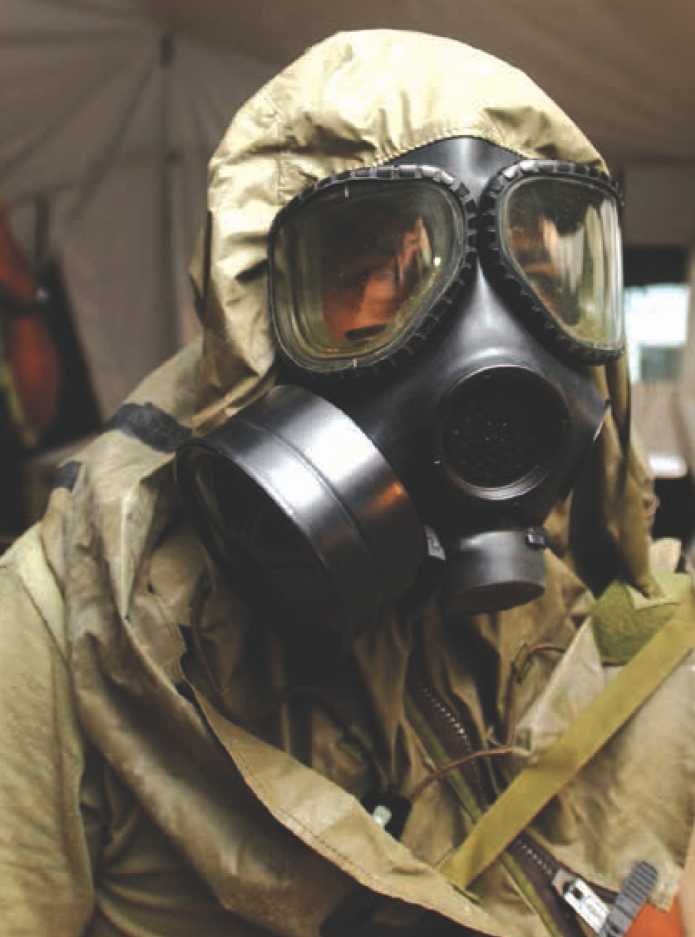
Chemical, Biological, Radiological and Nuclear Defense-Individual Protection Equipment-Readiness Improvement Program (CBRND-IPE-RIP)